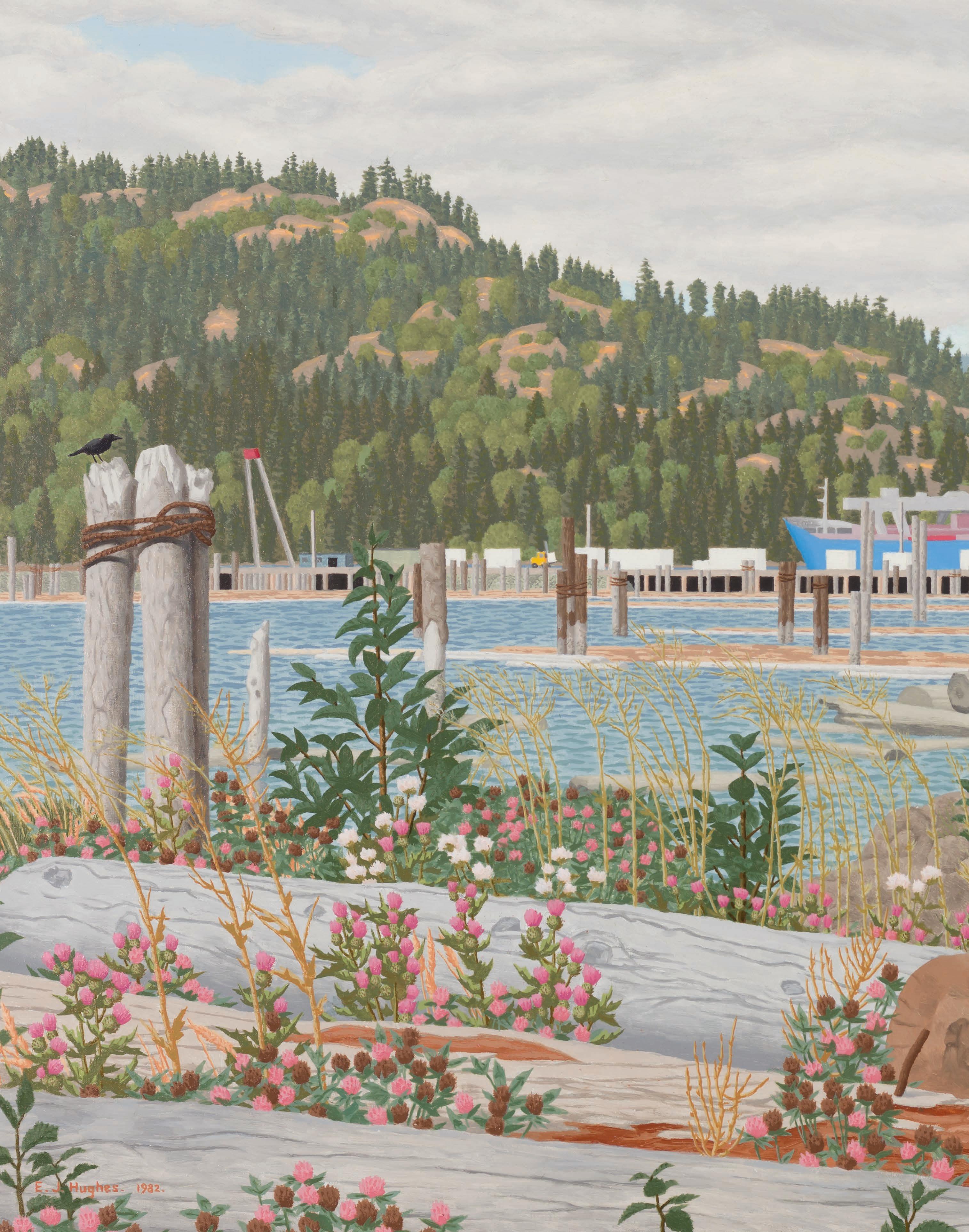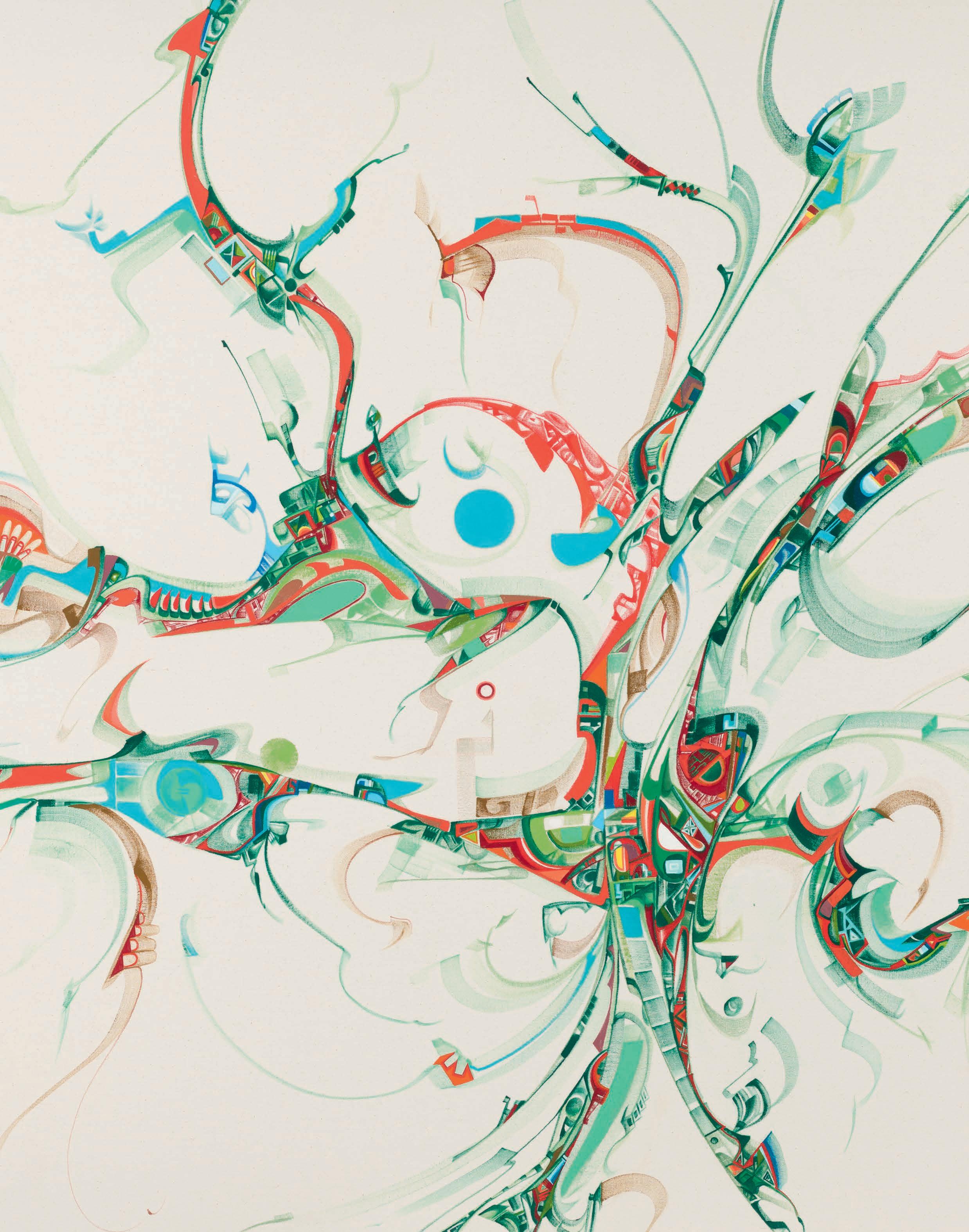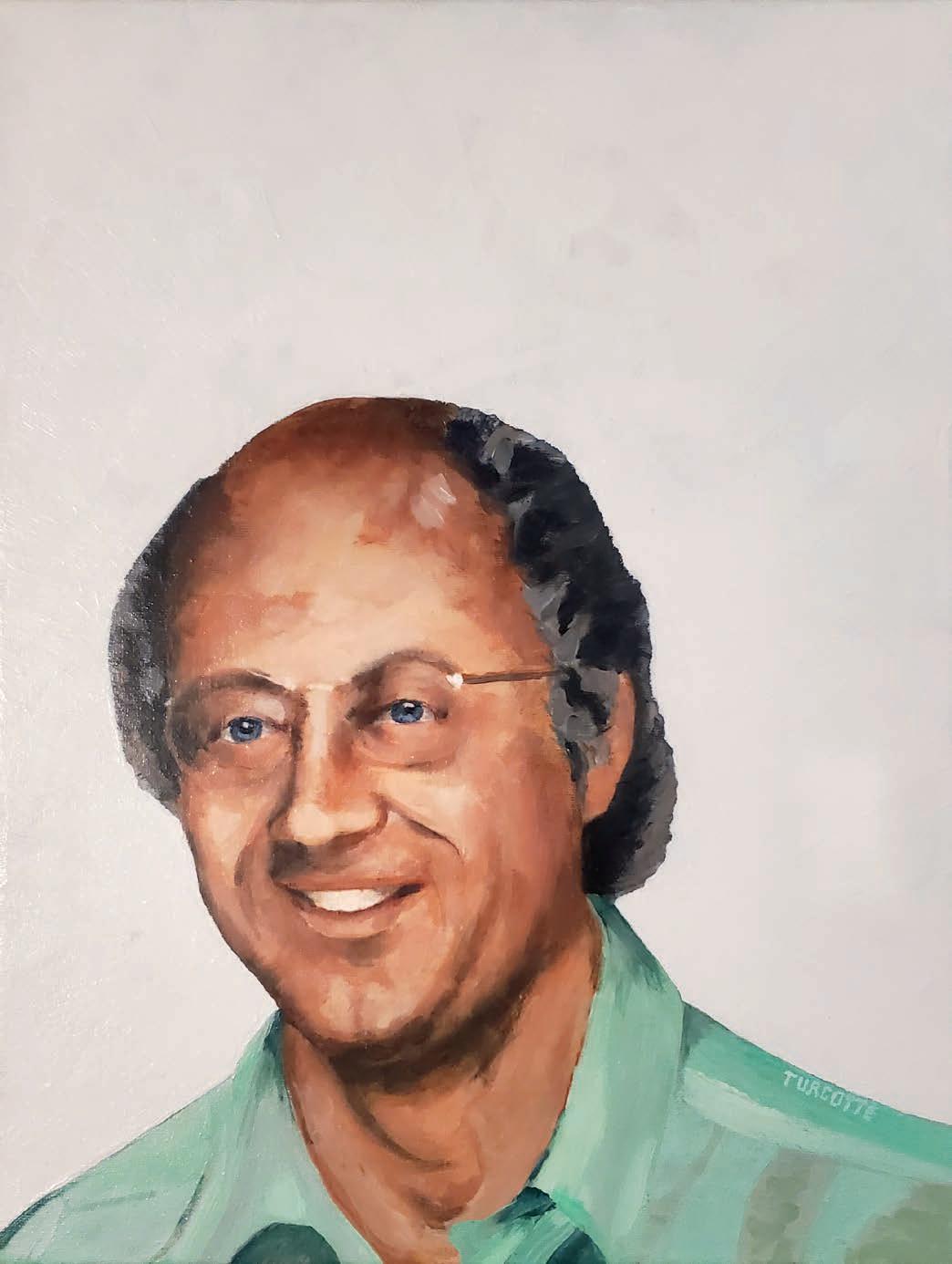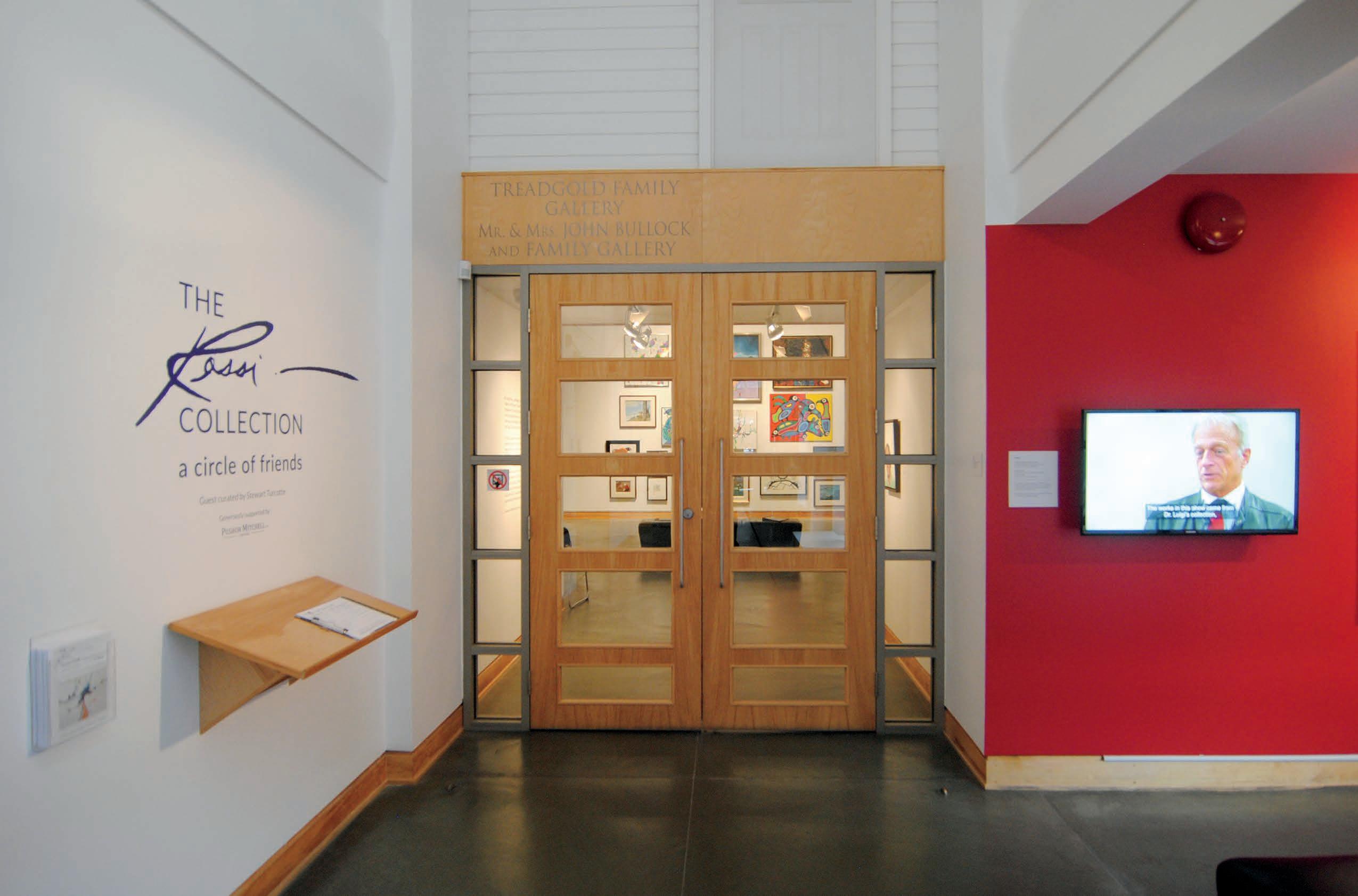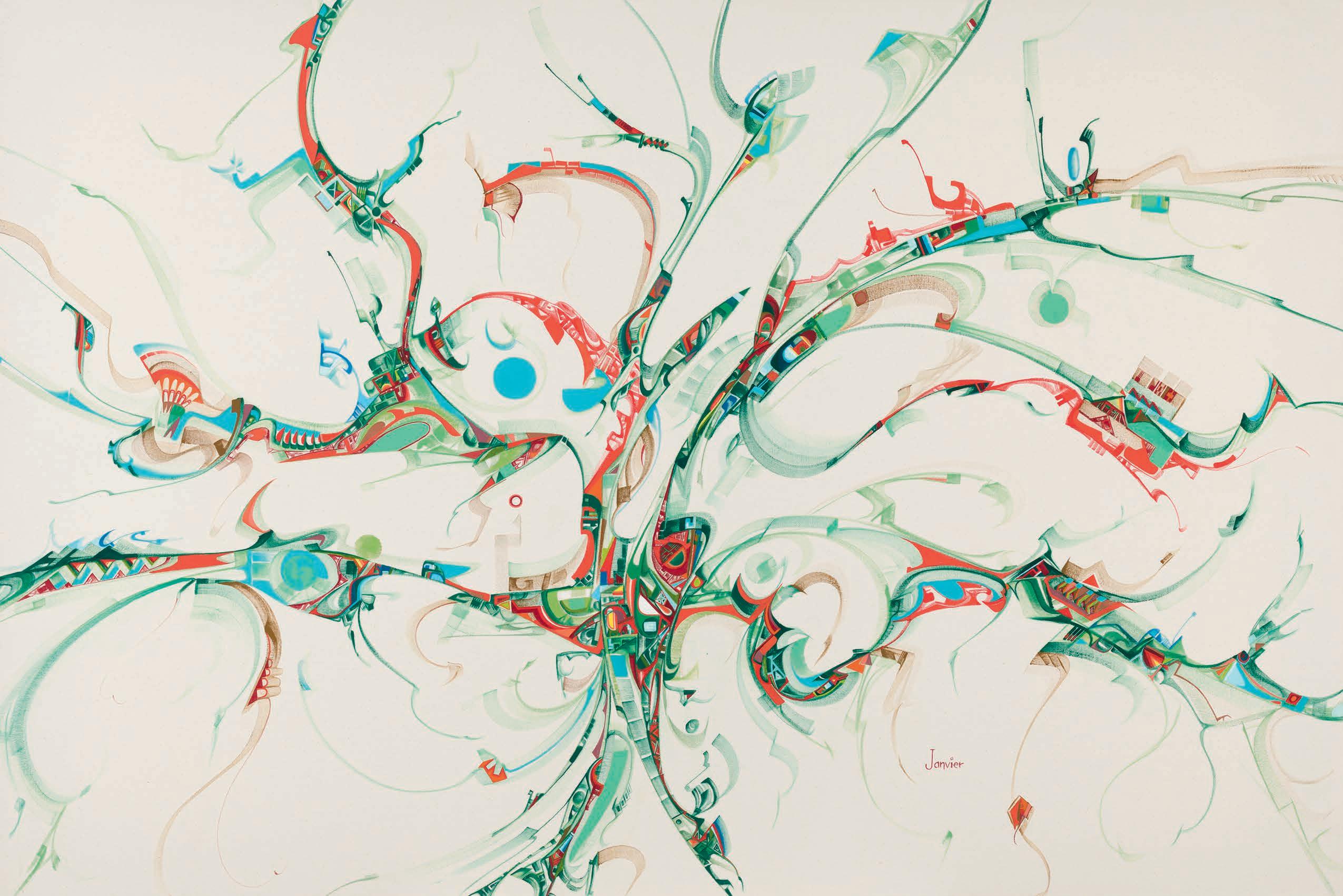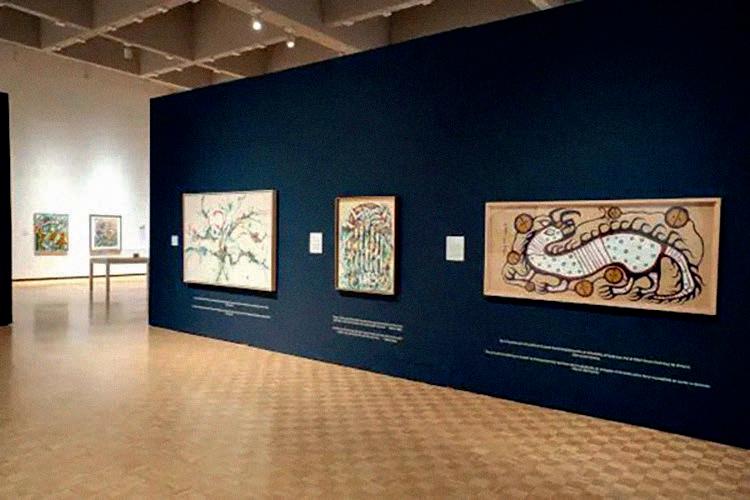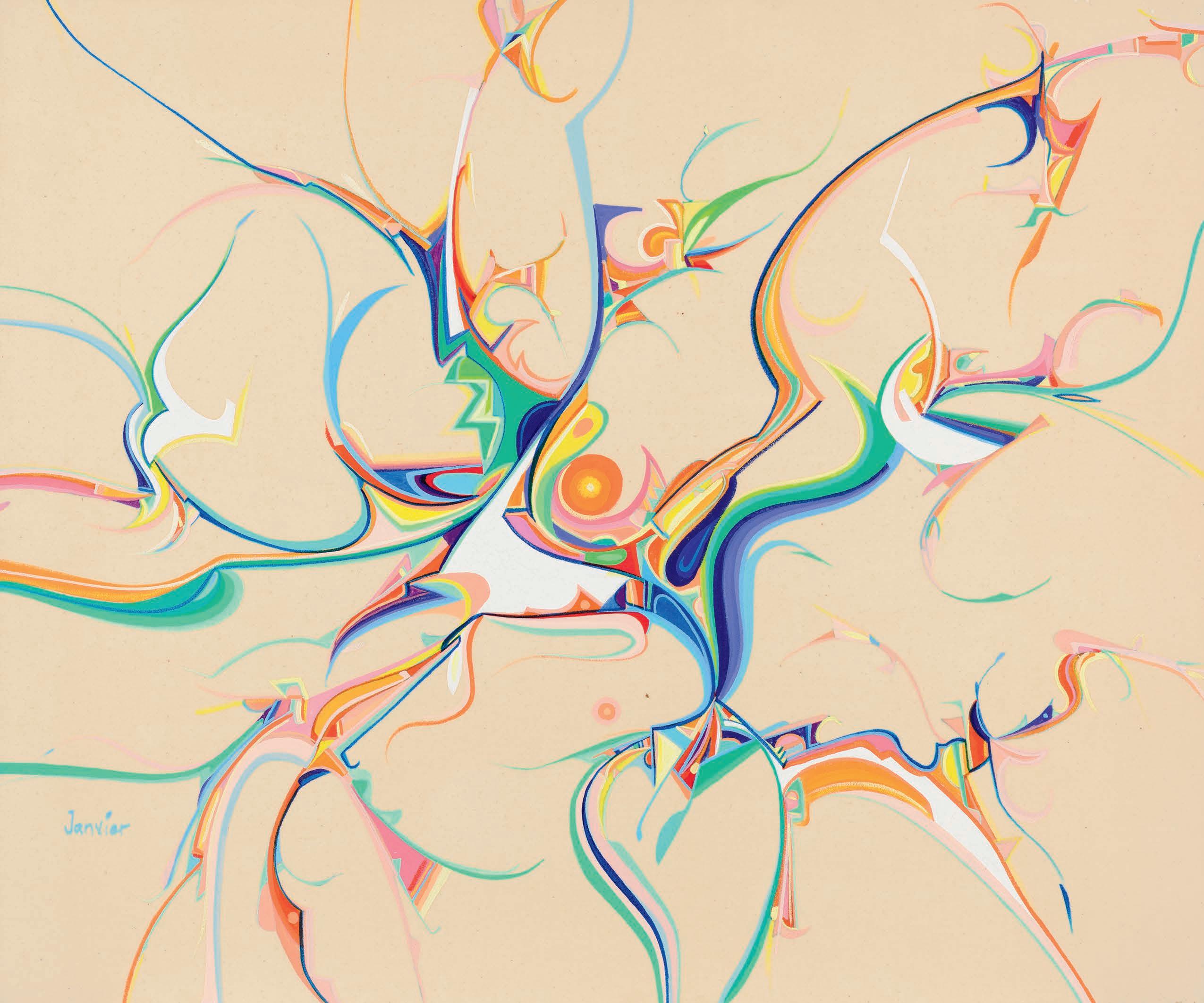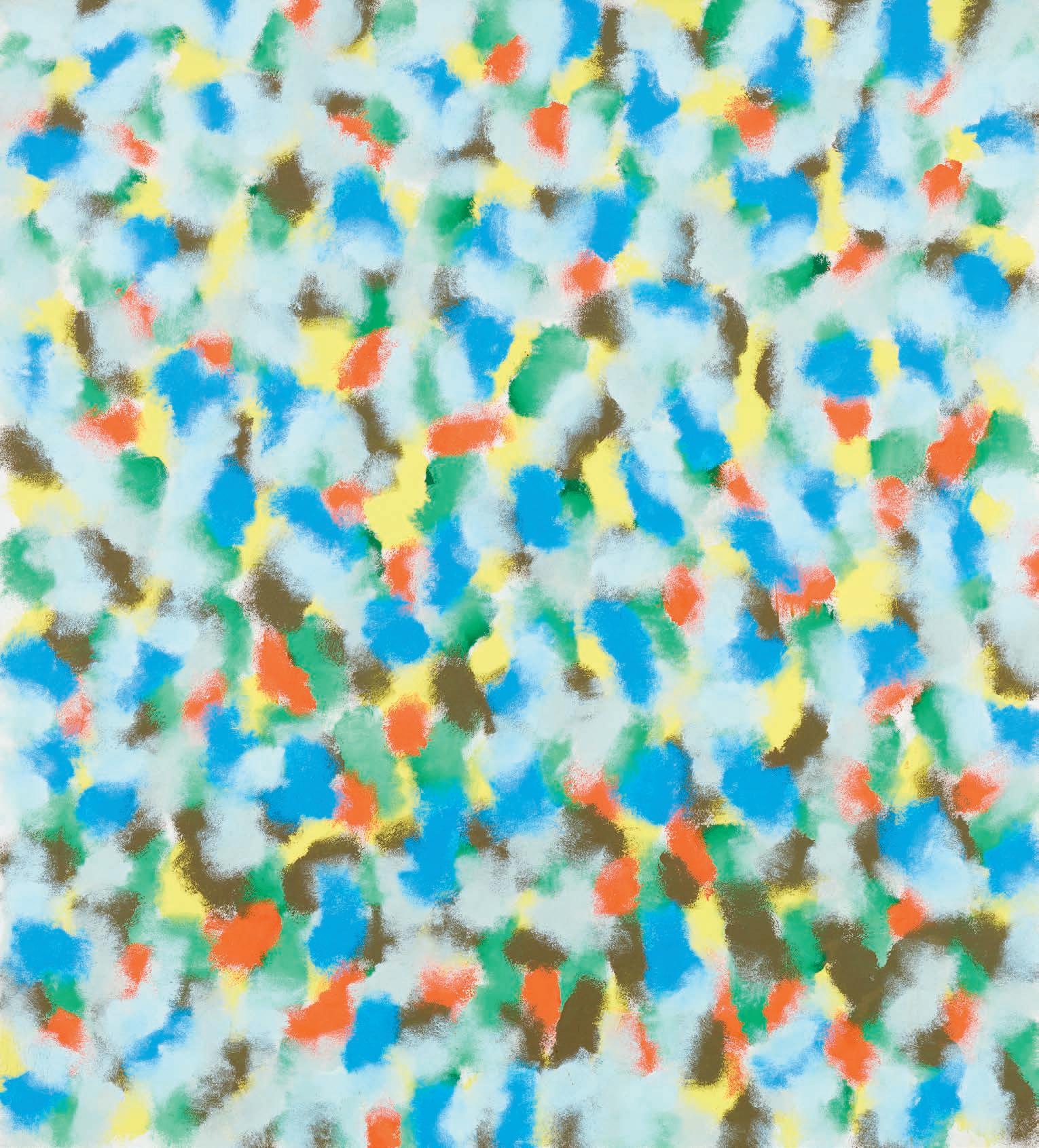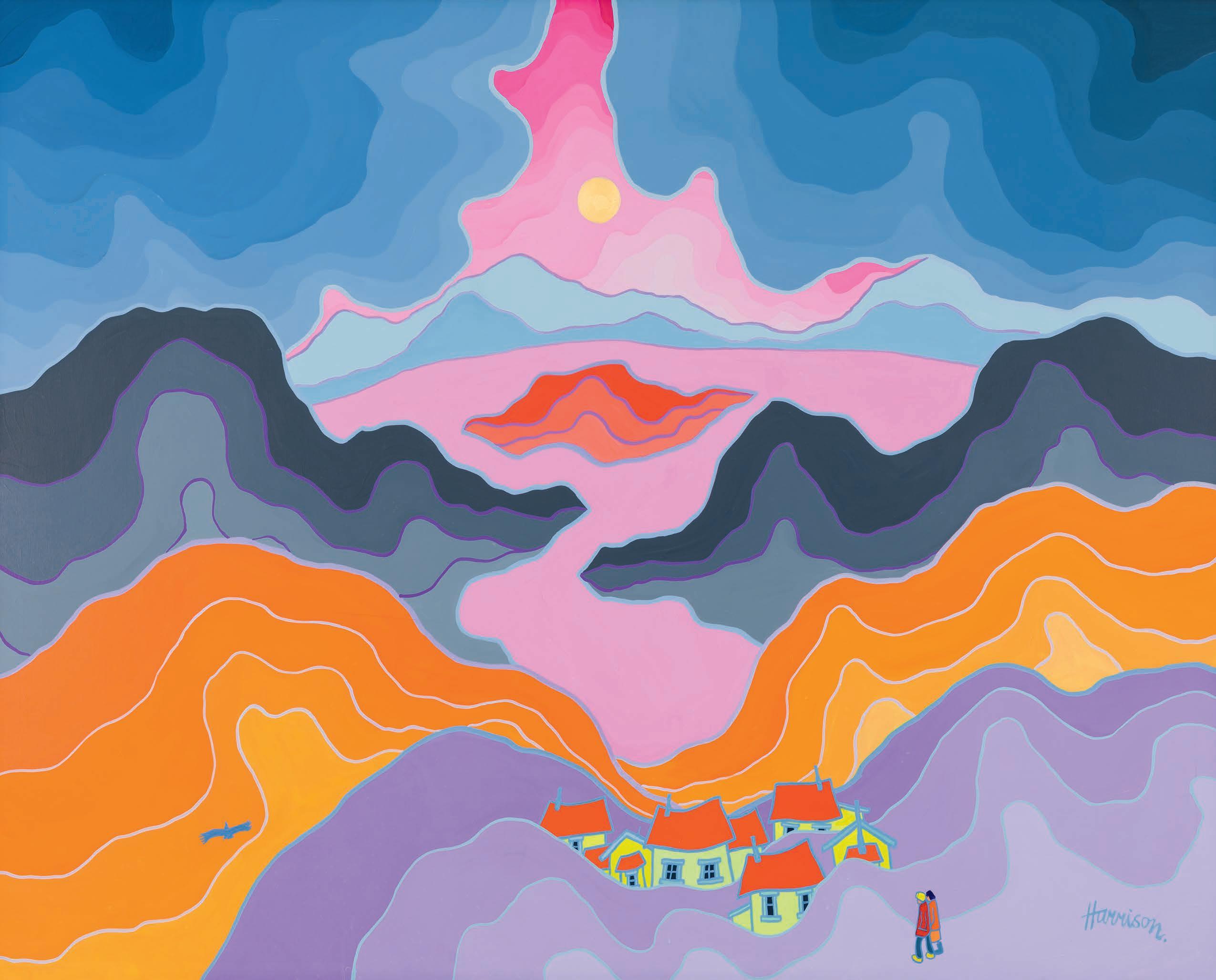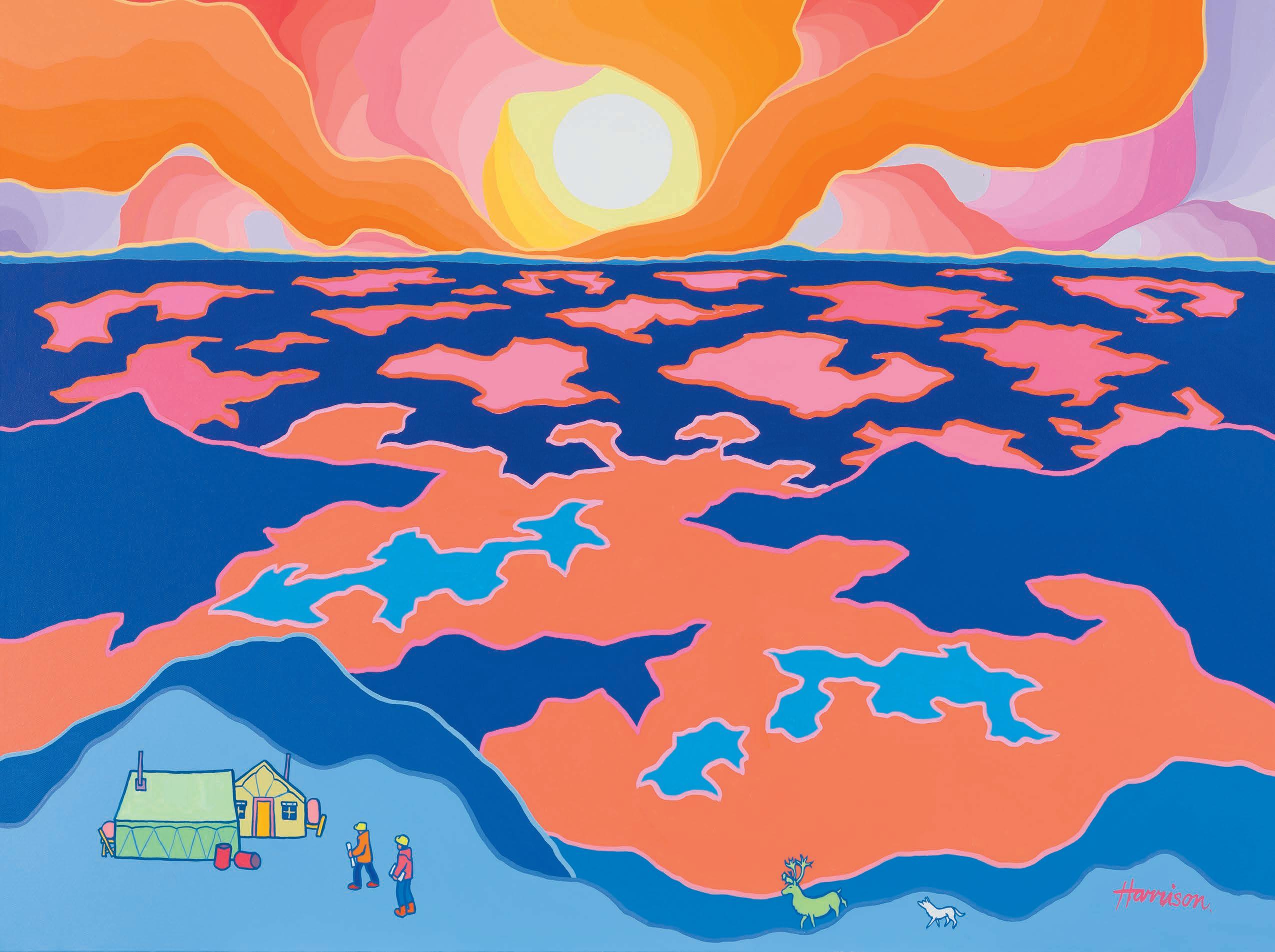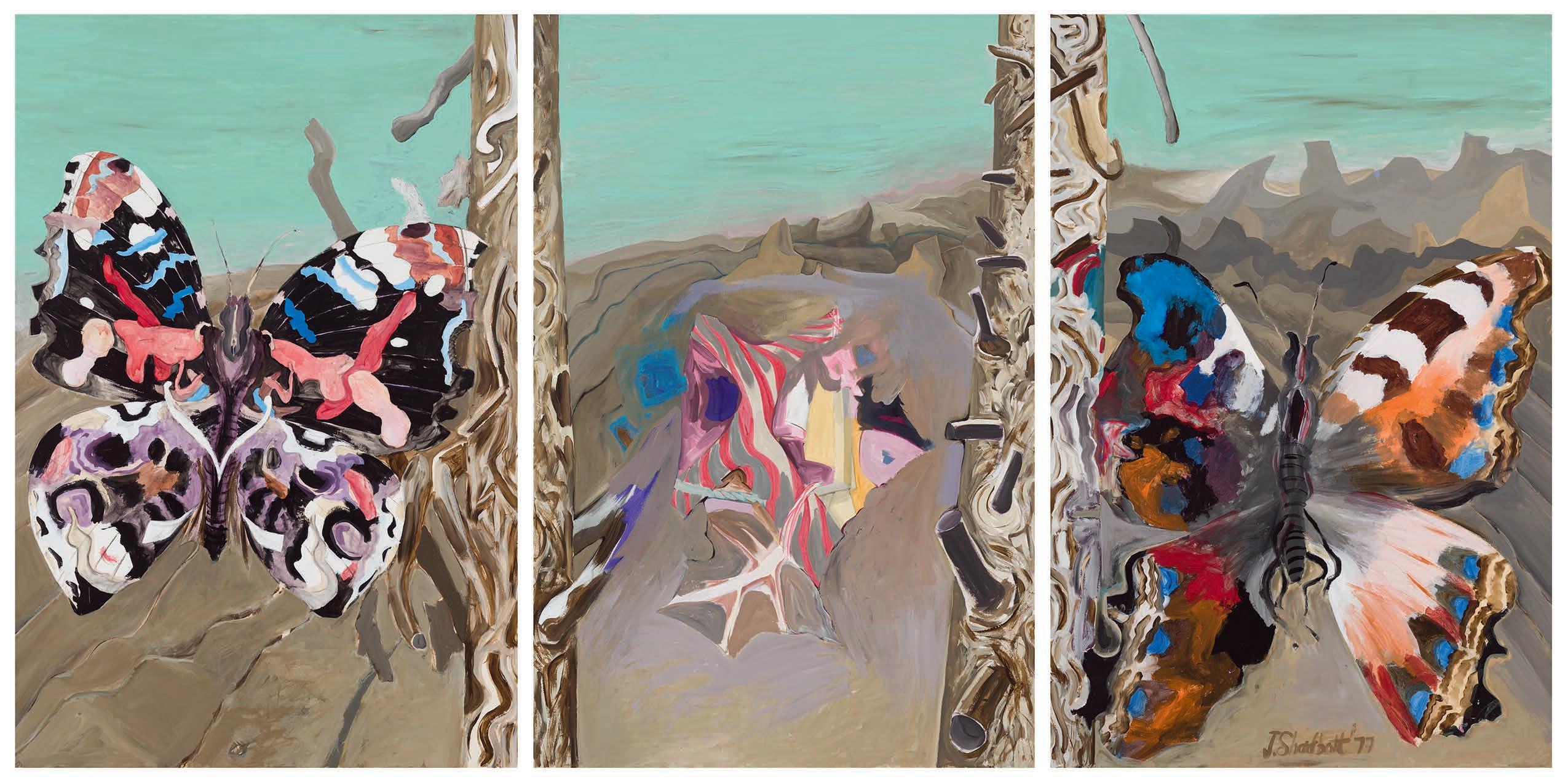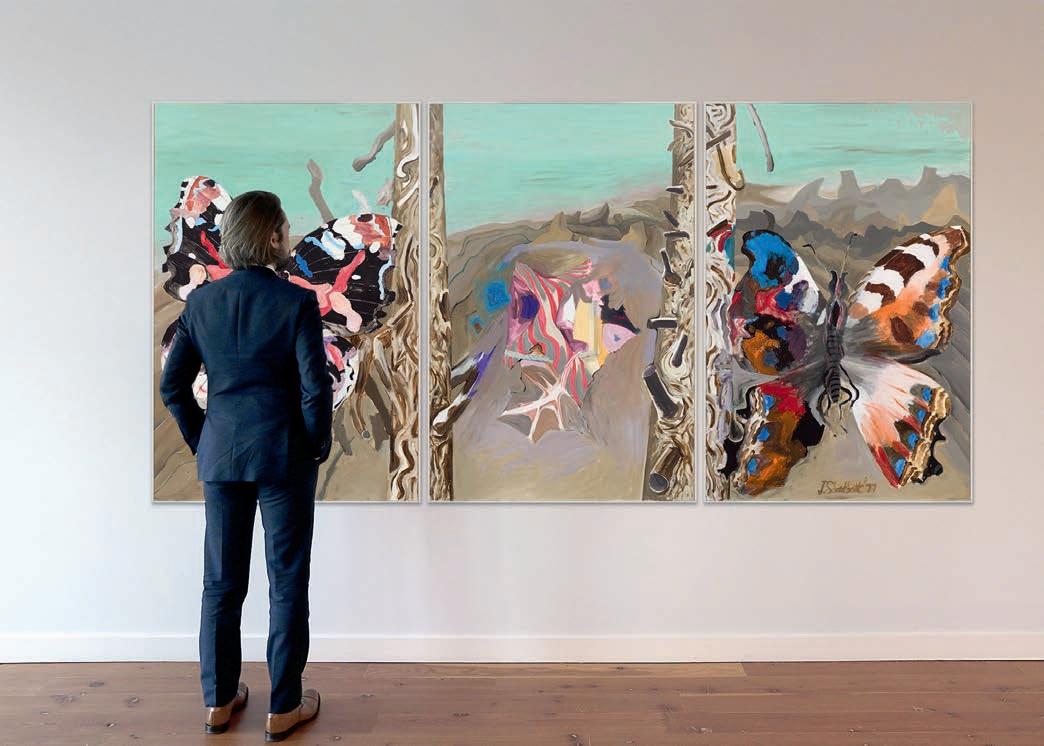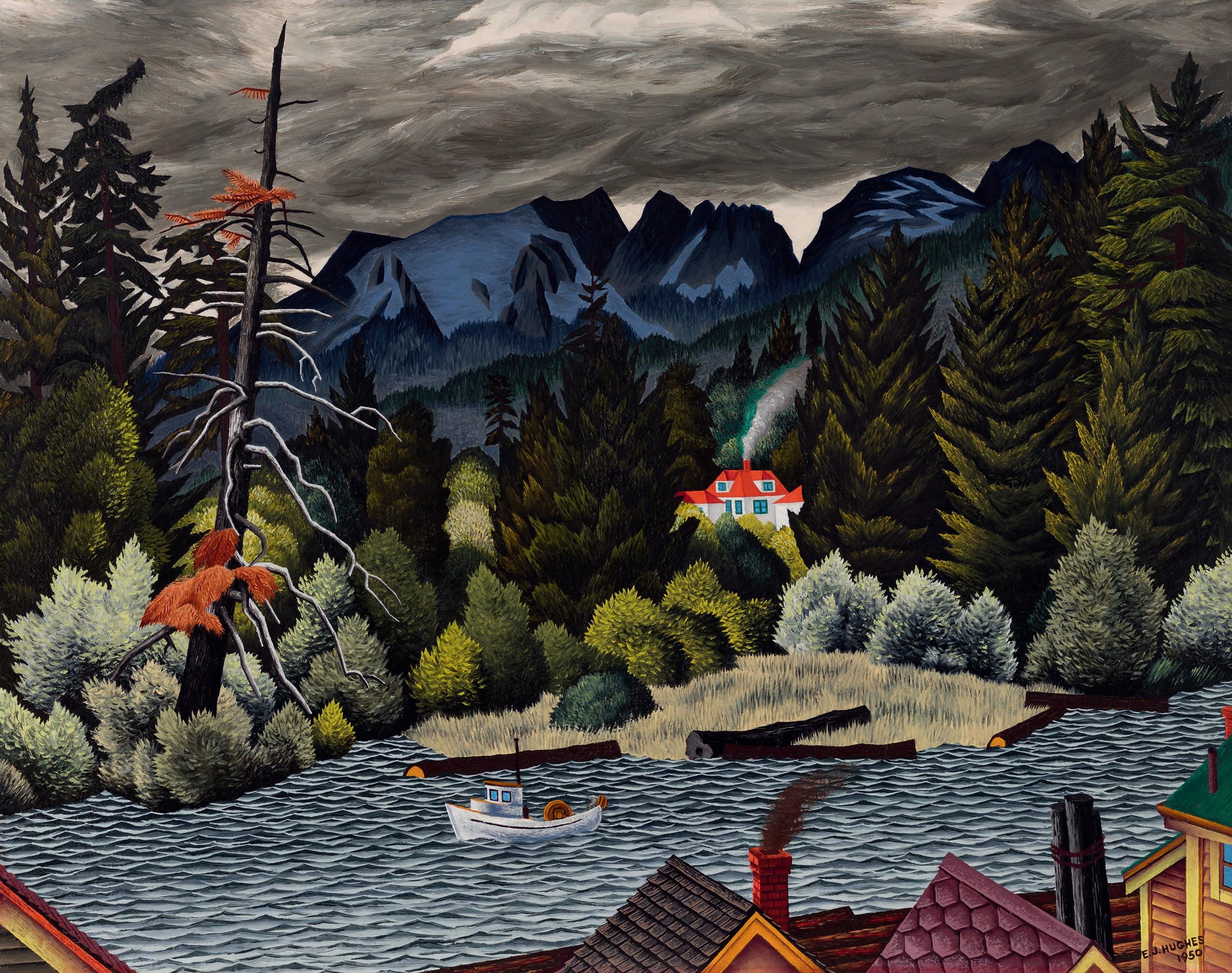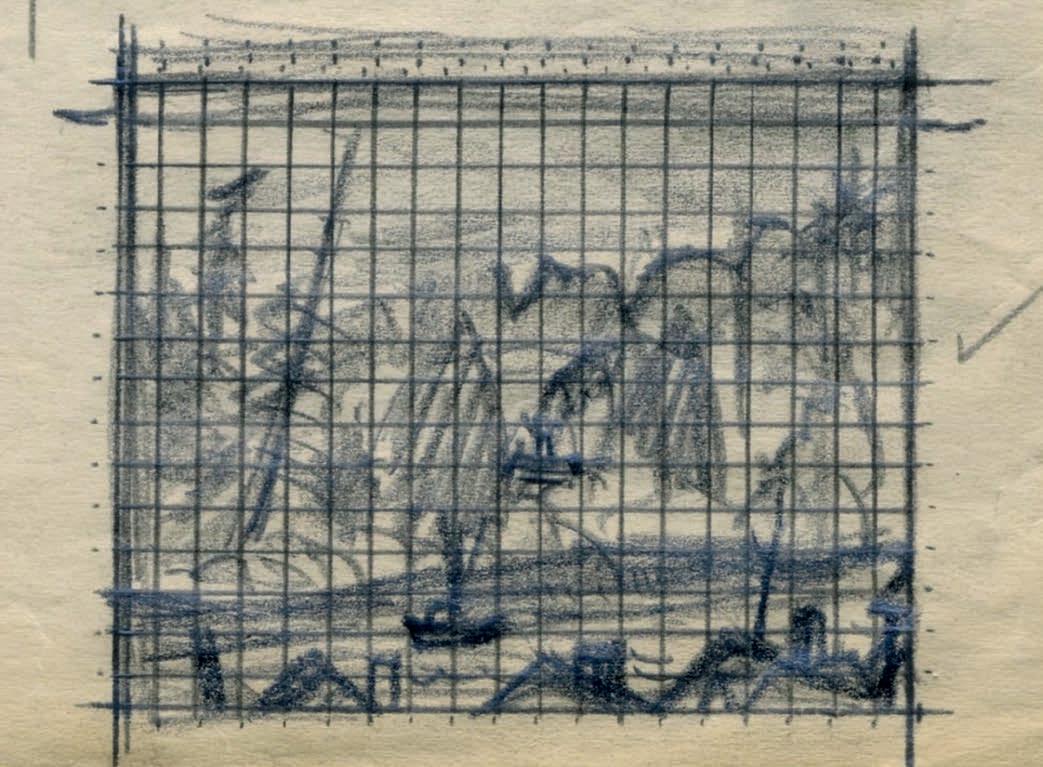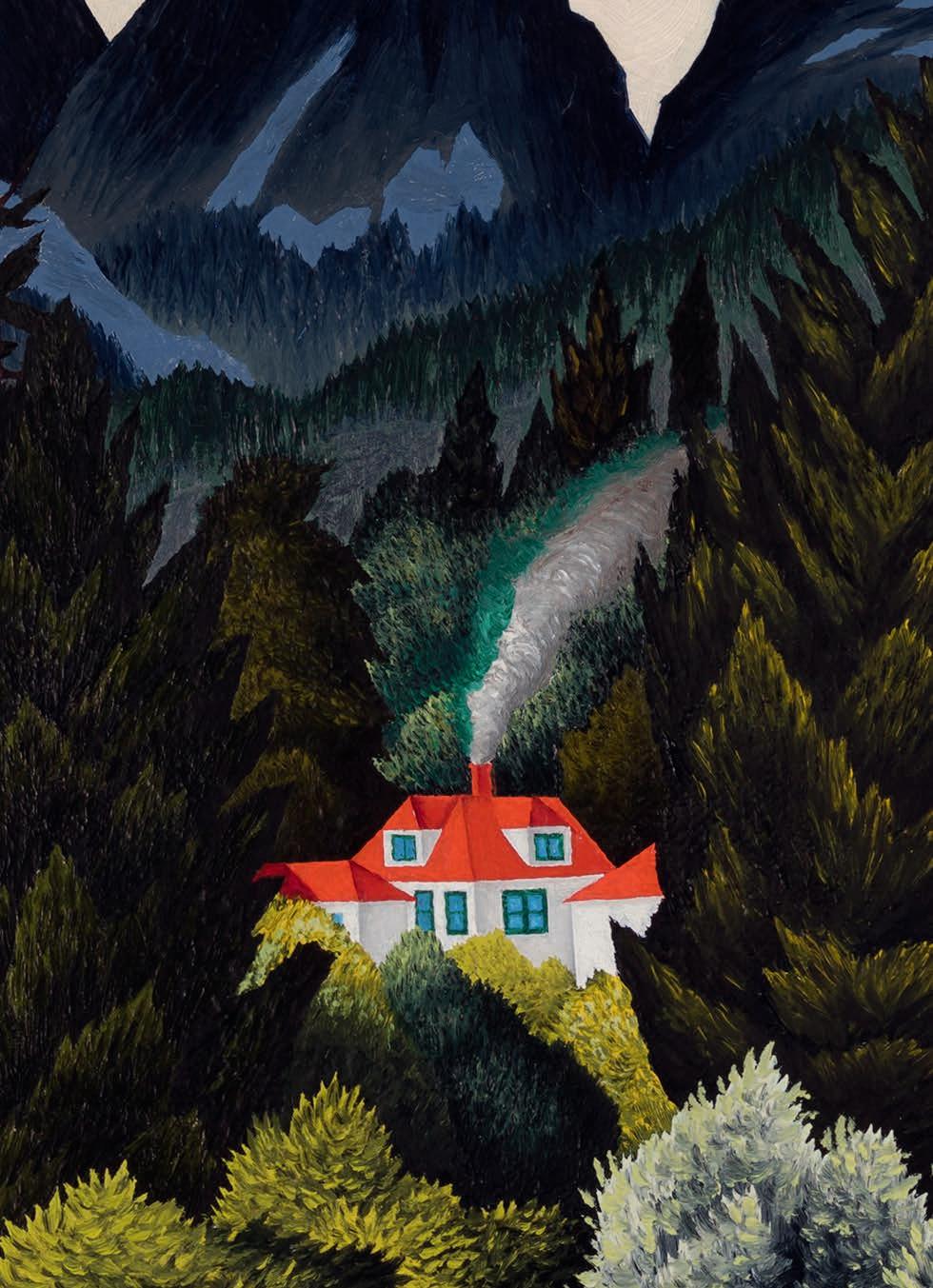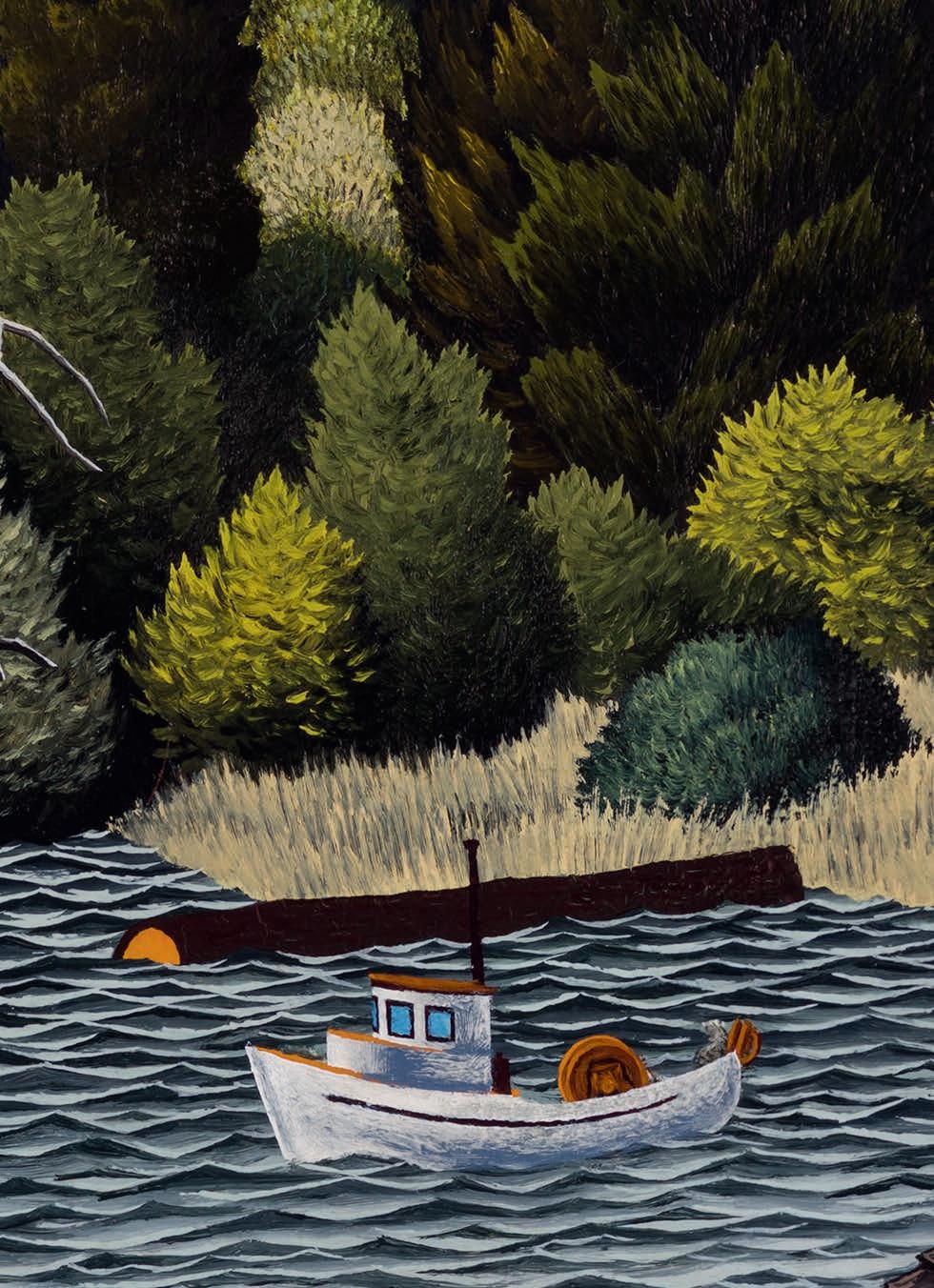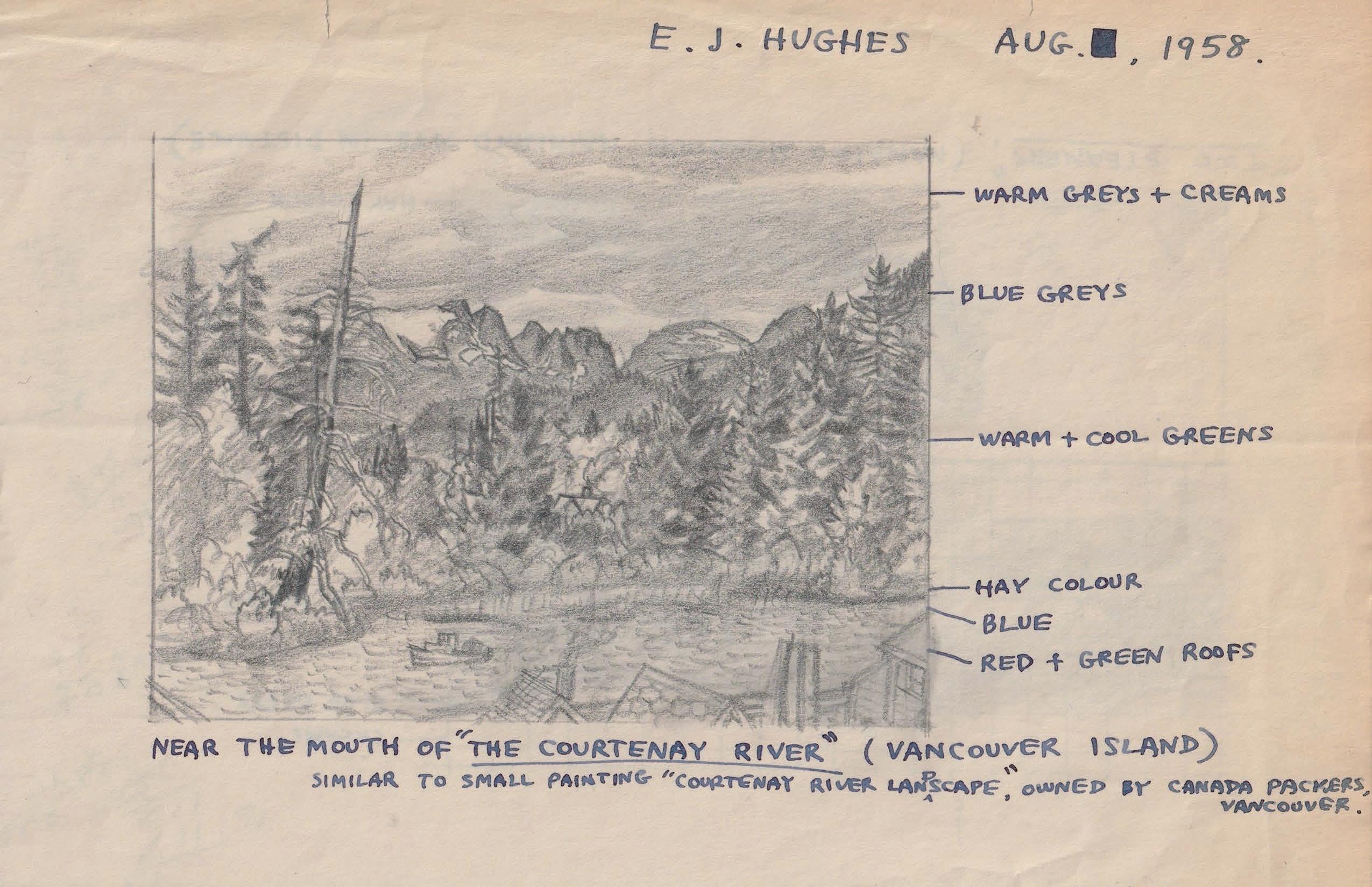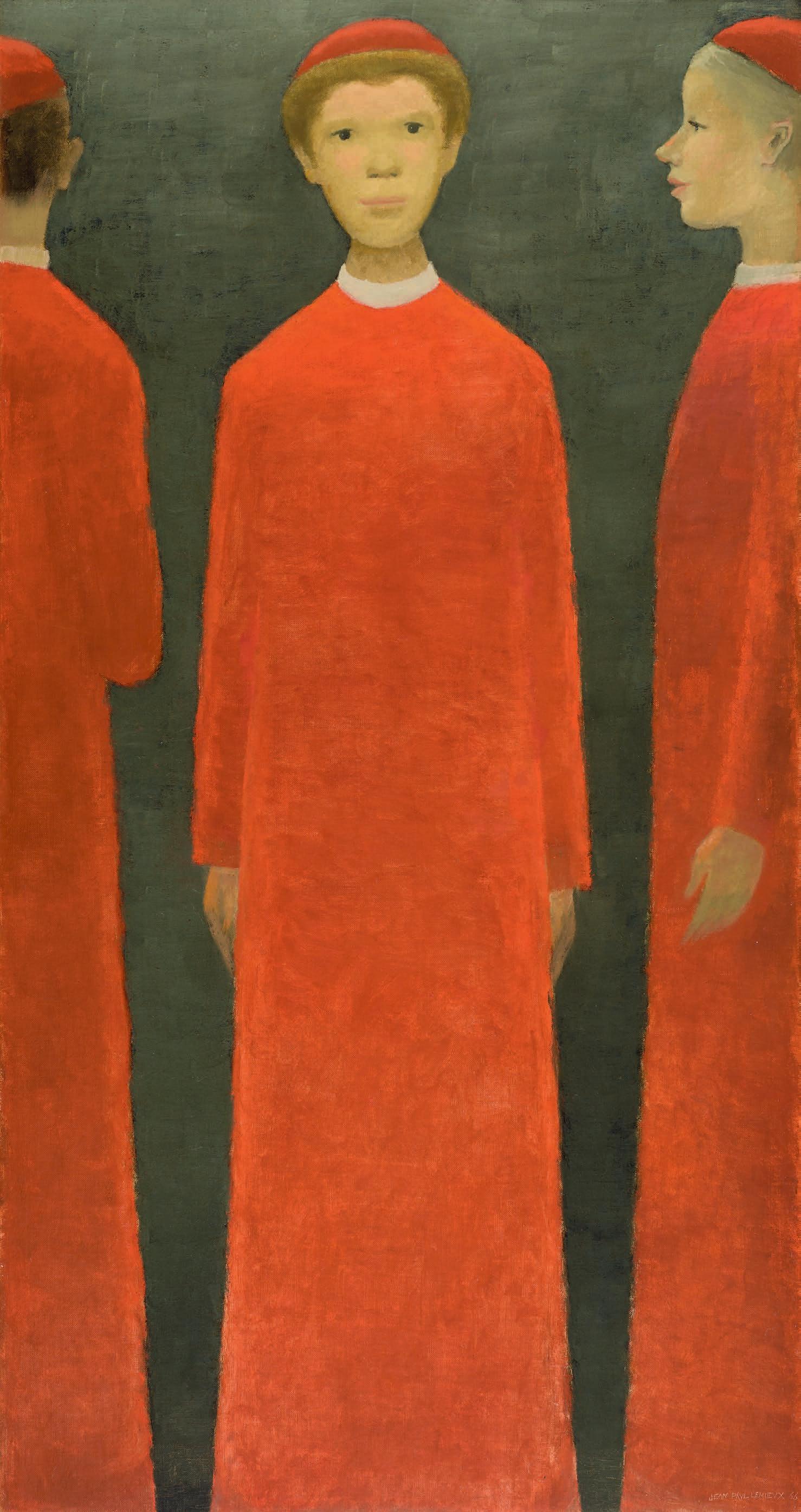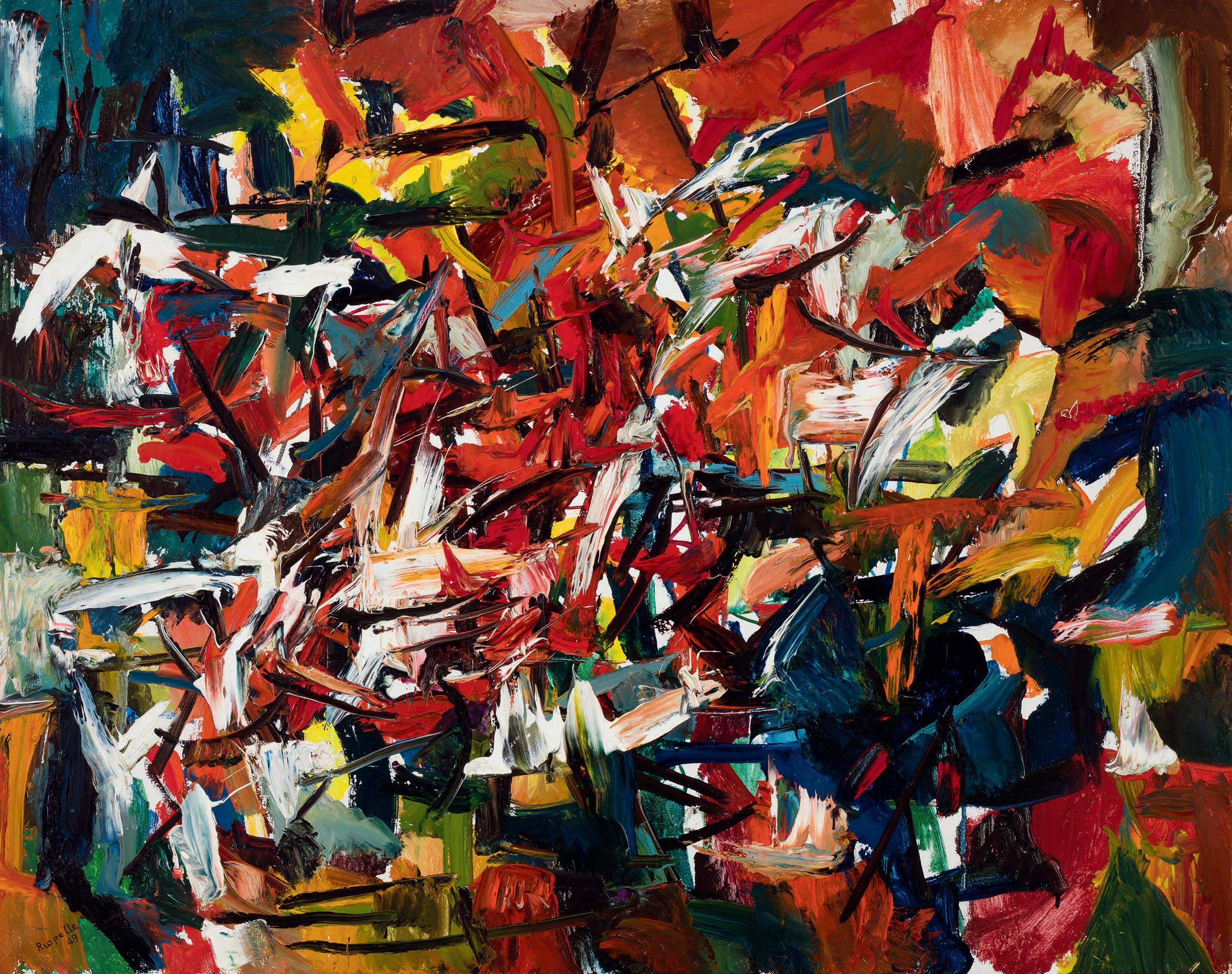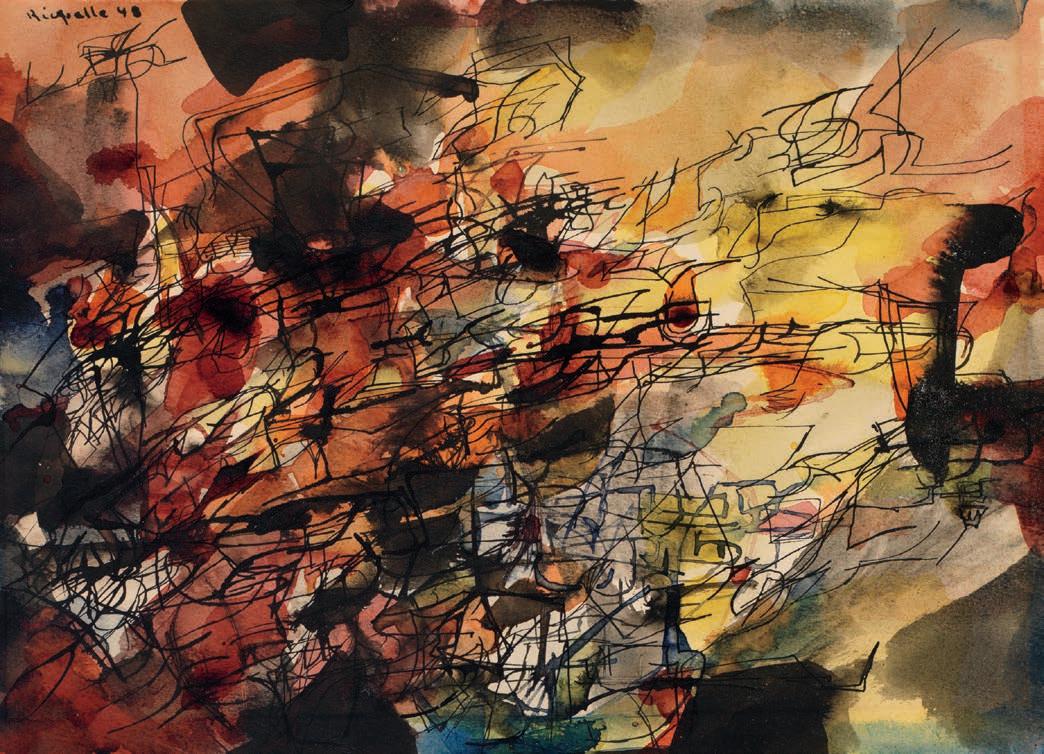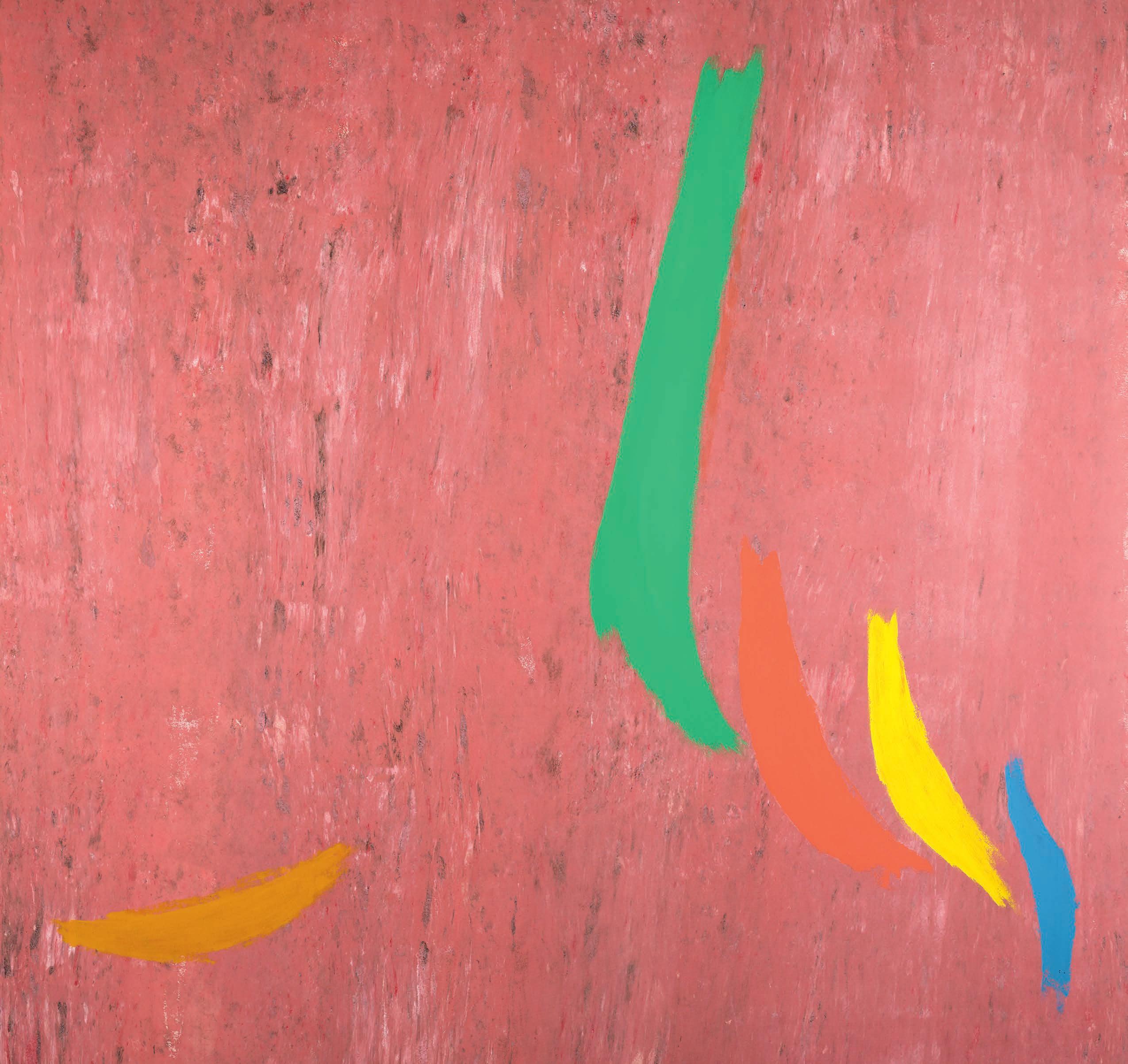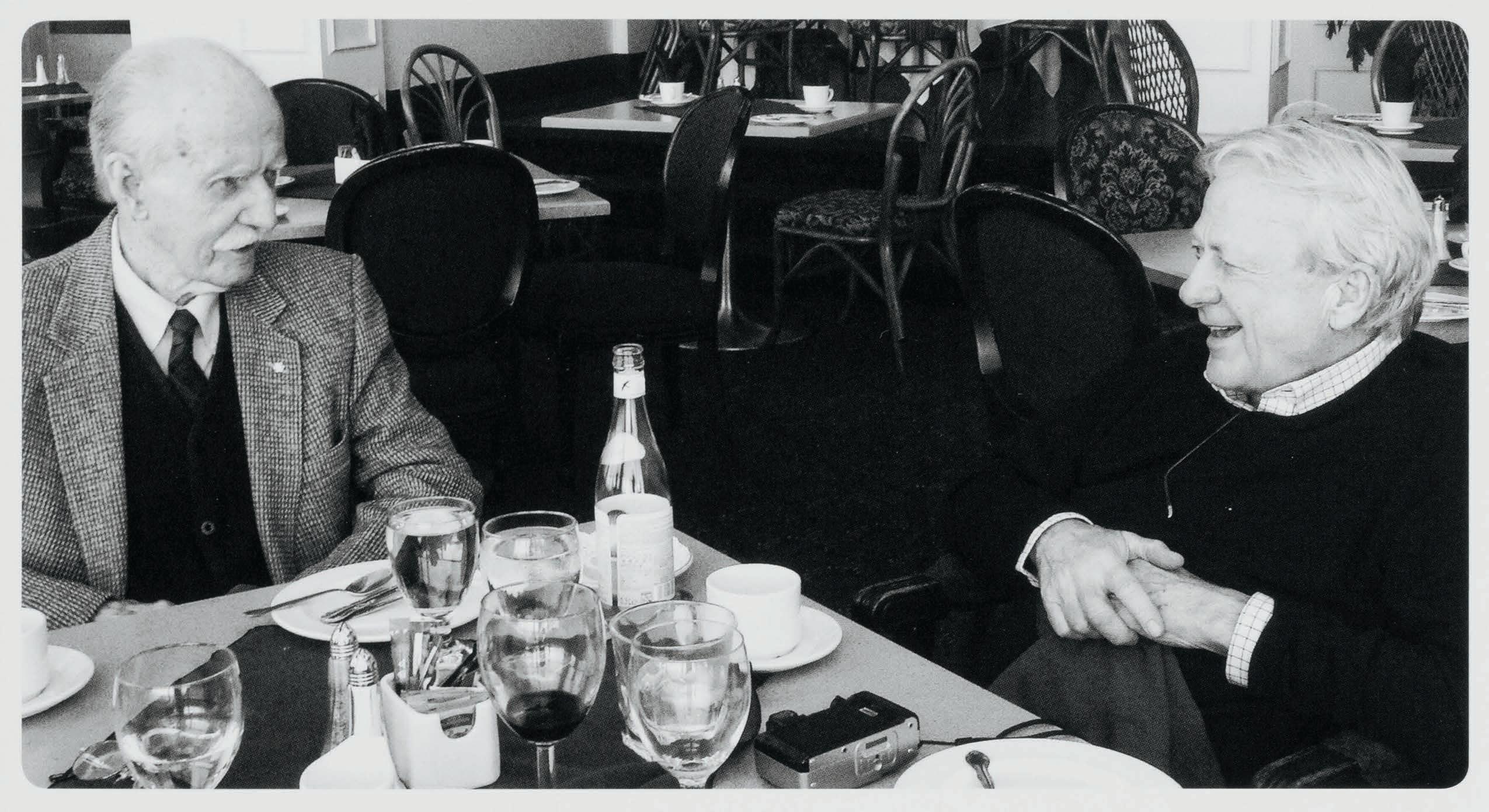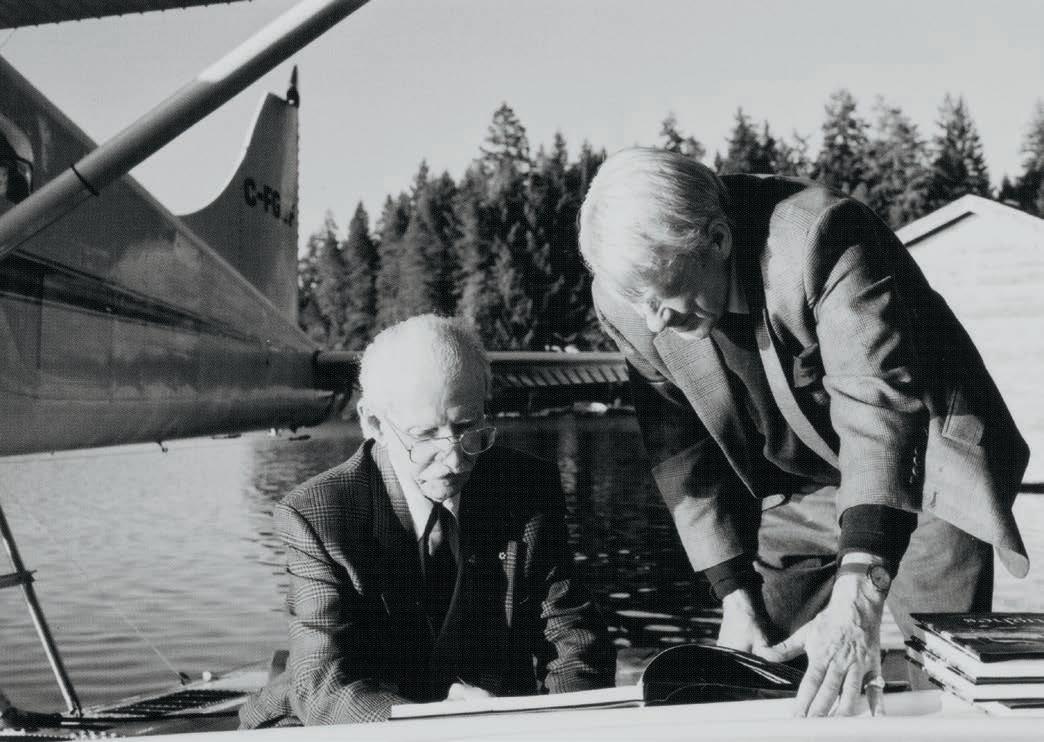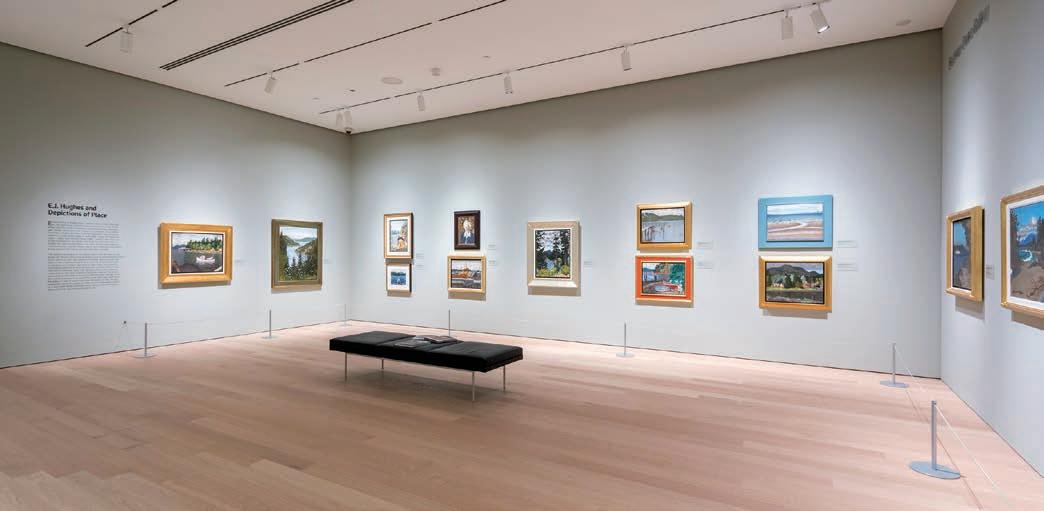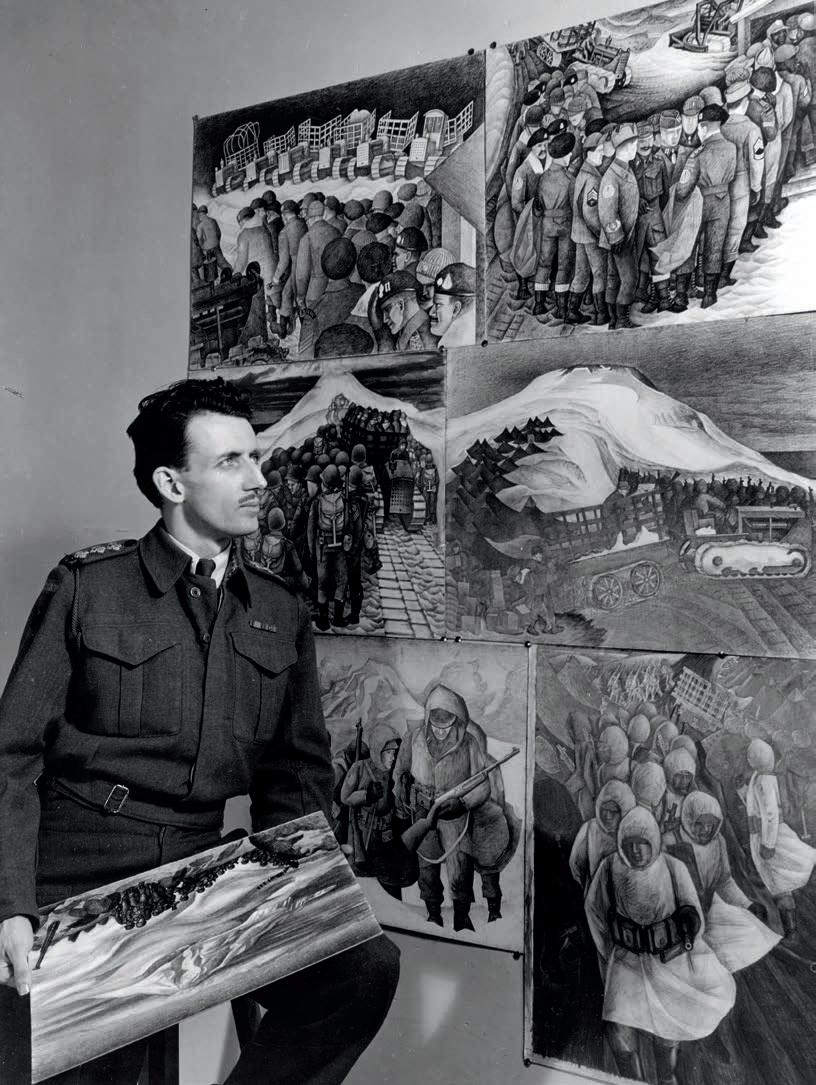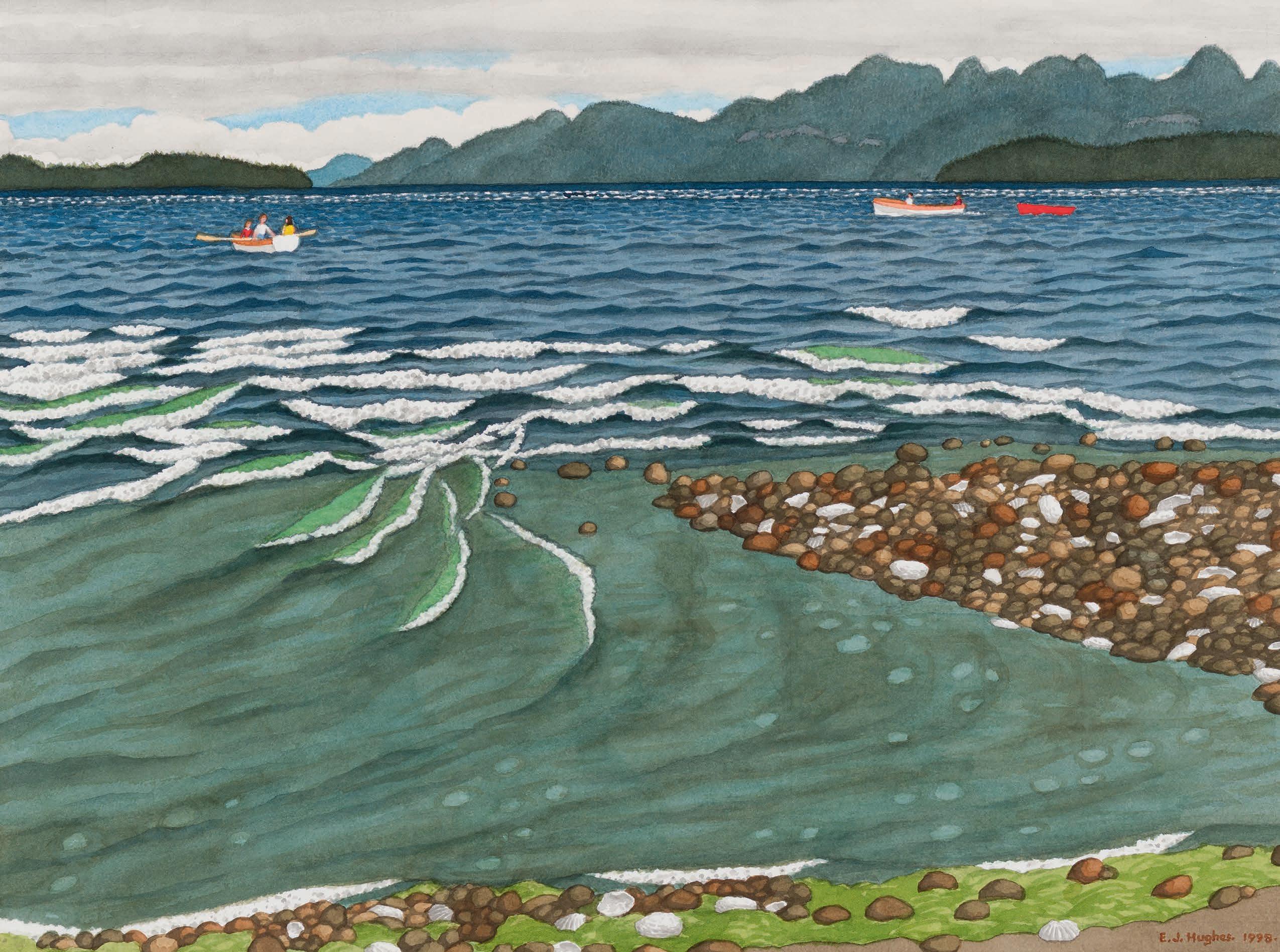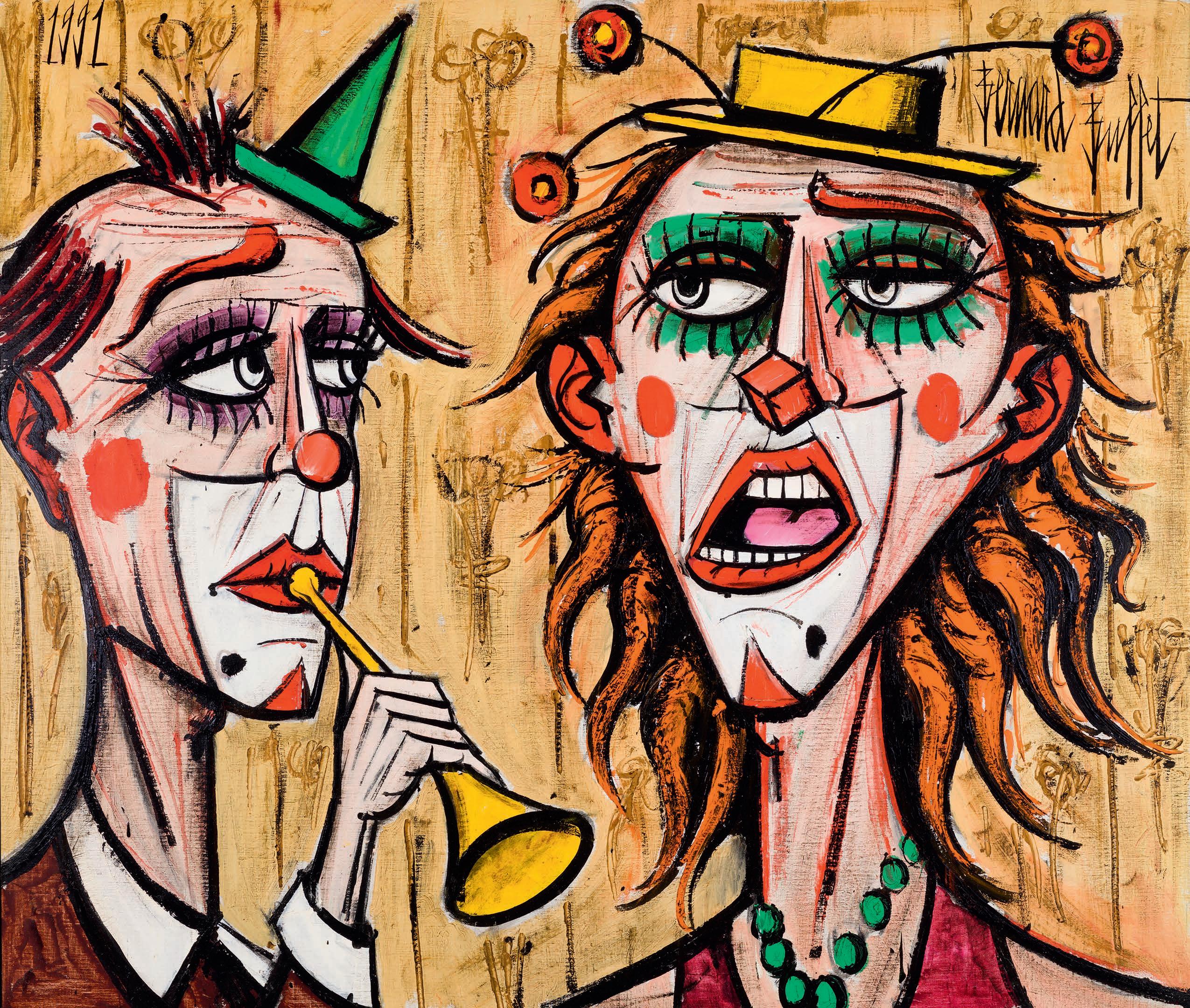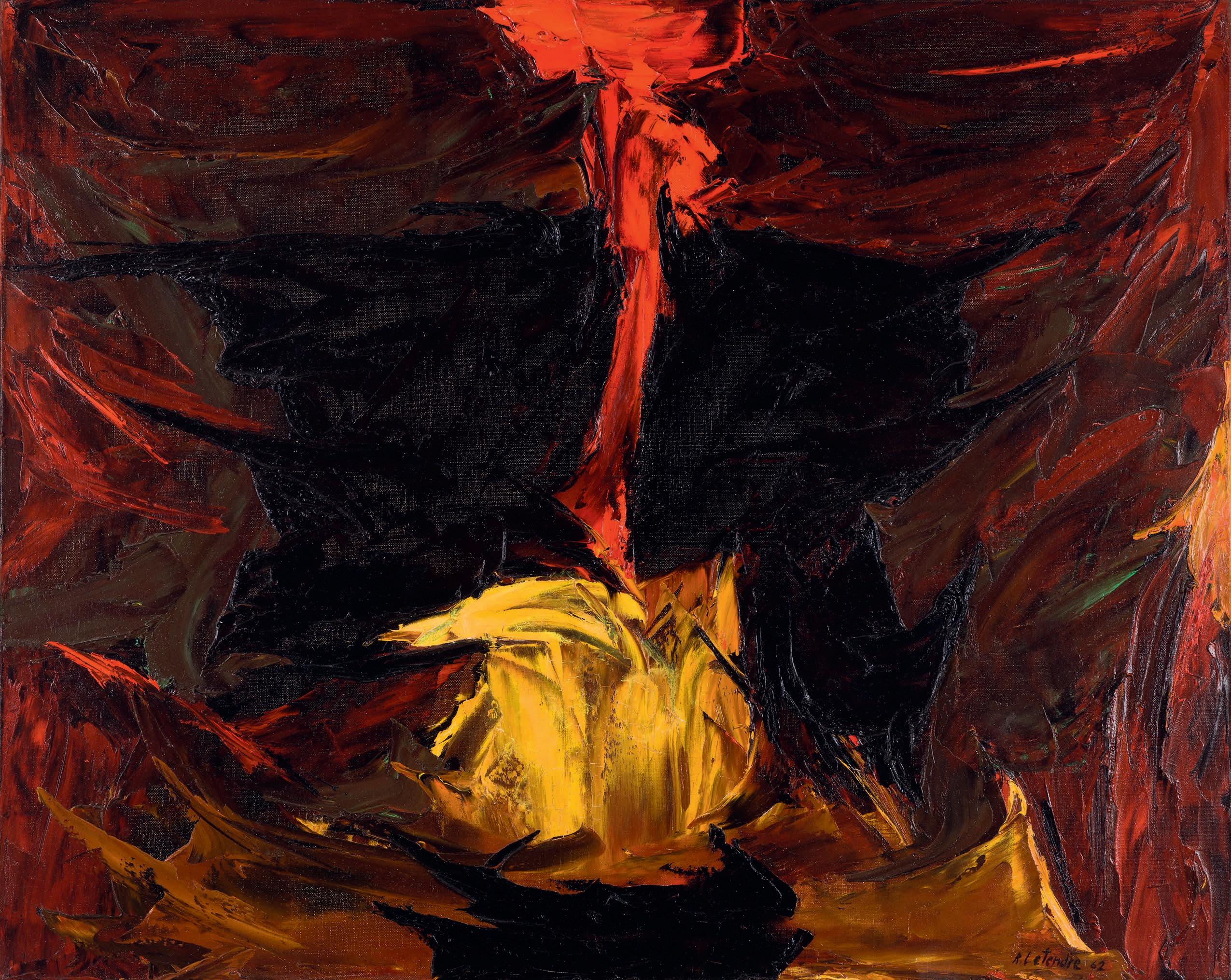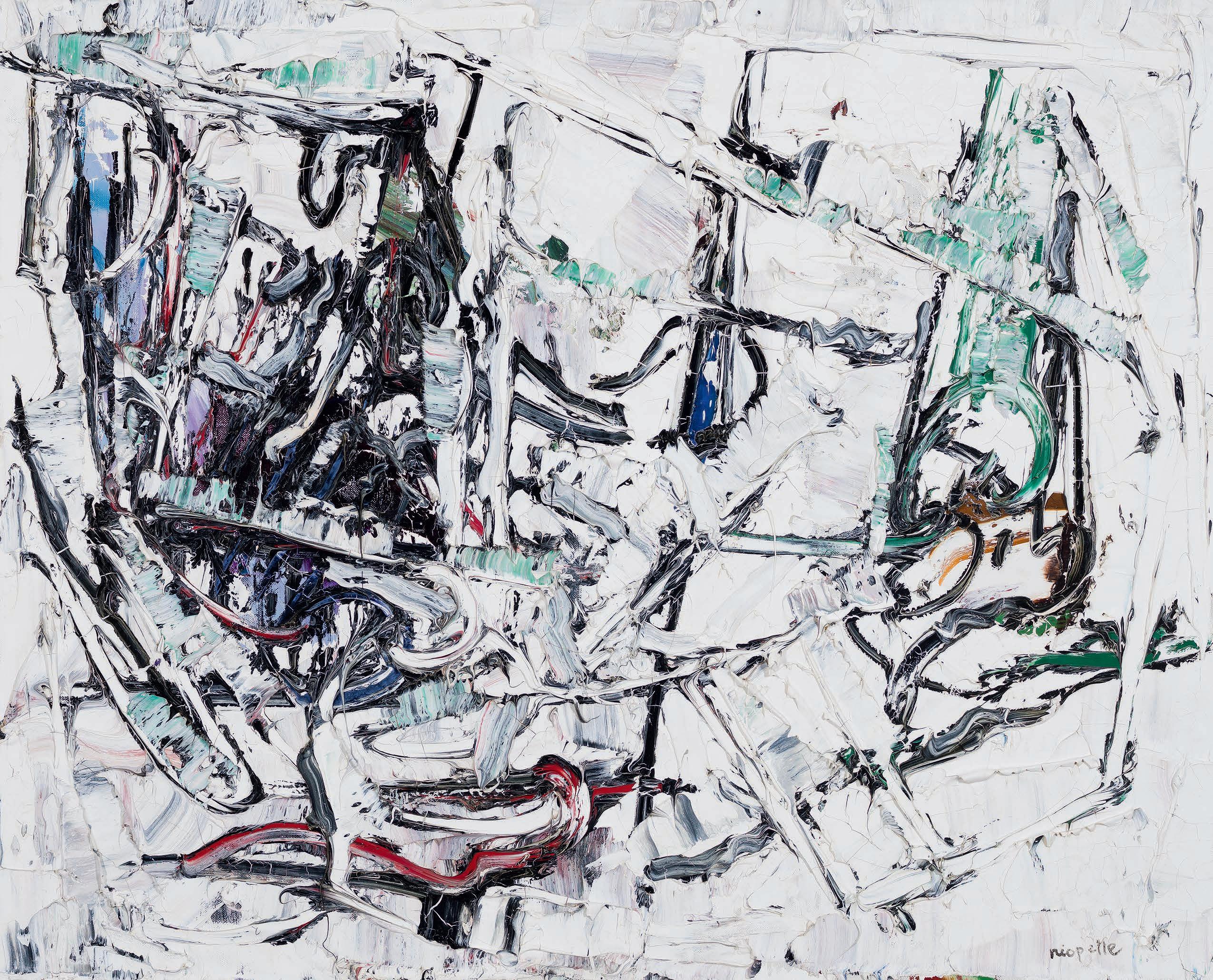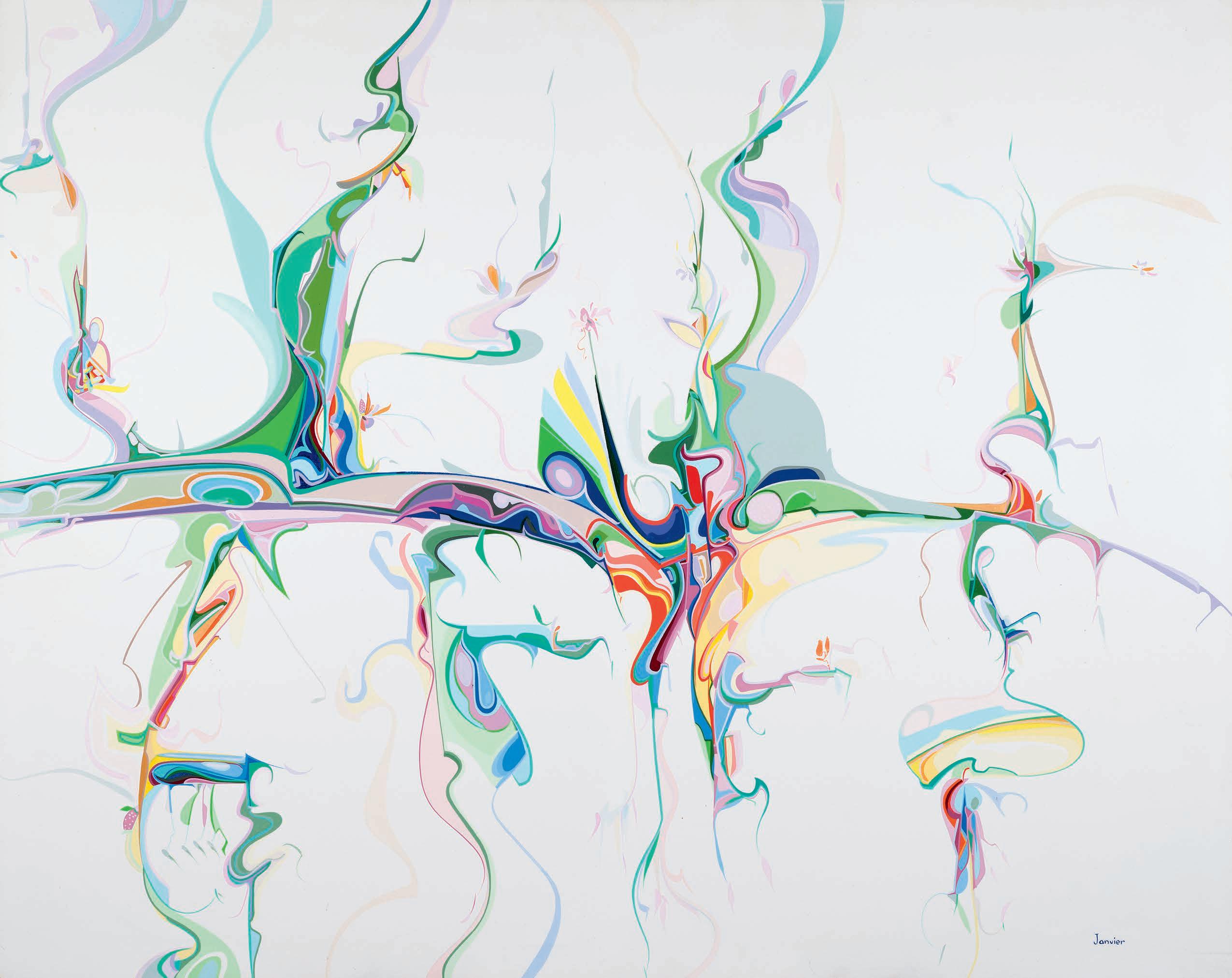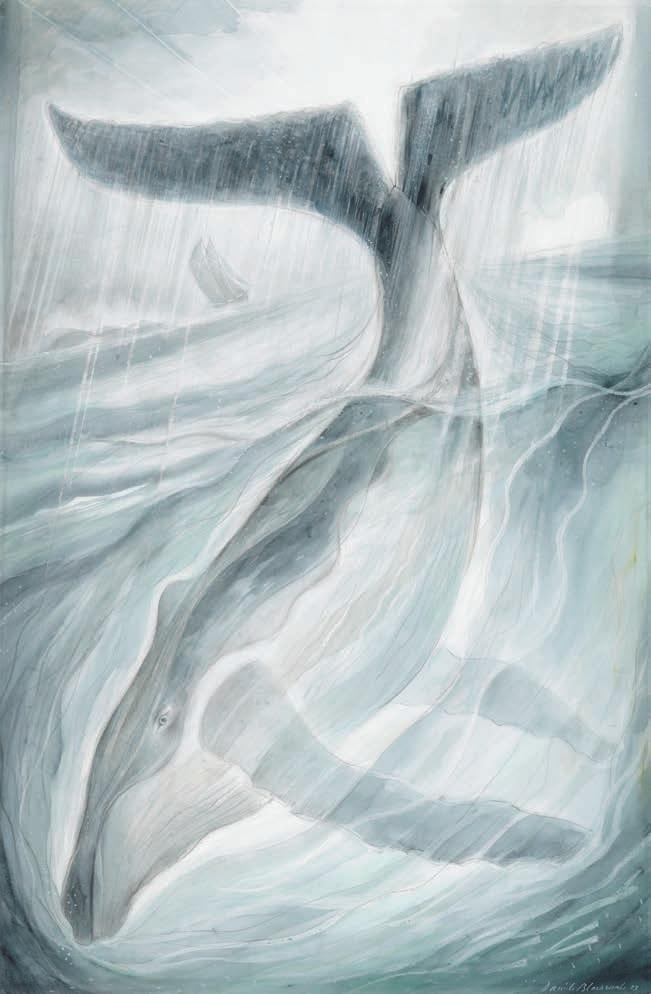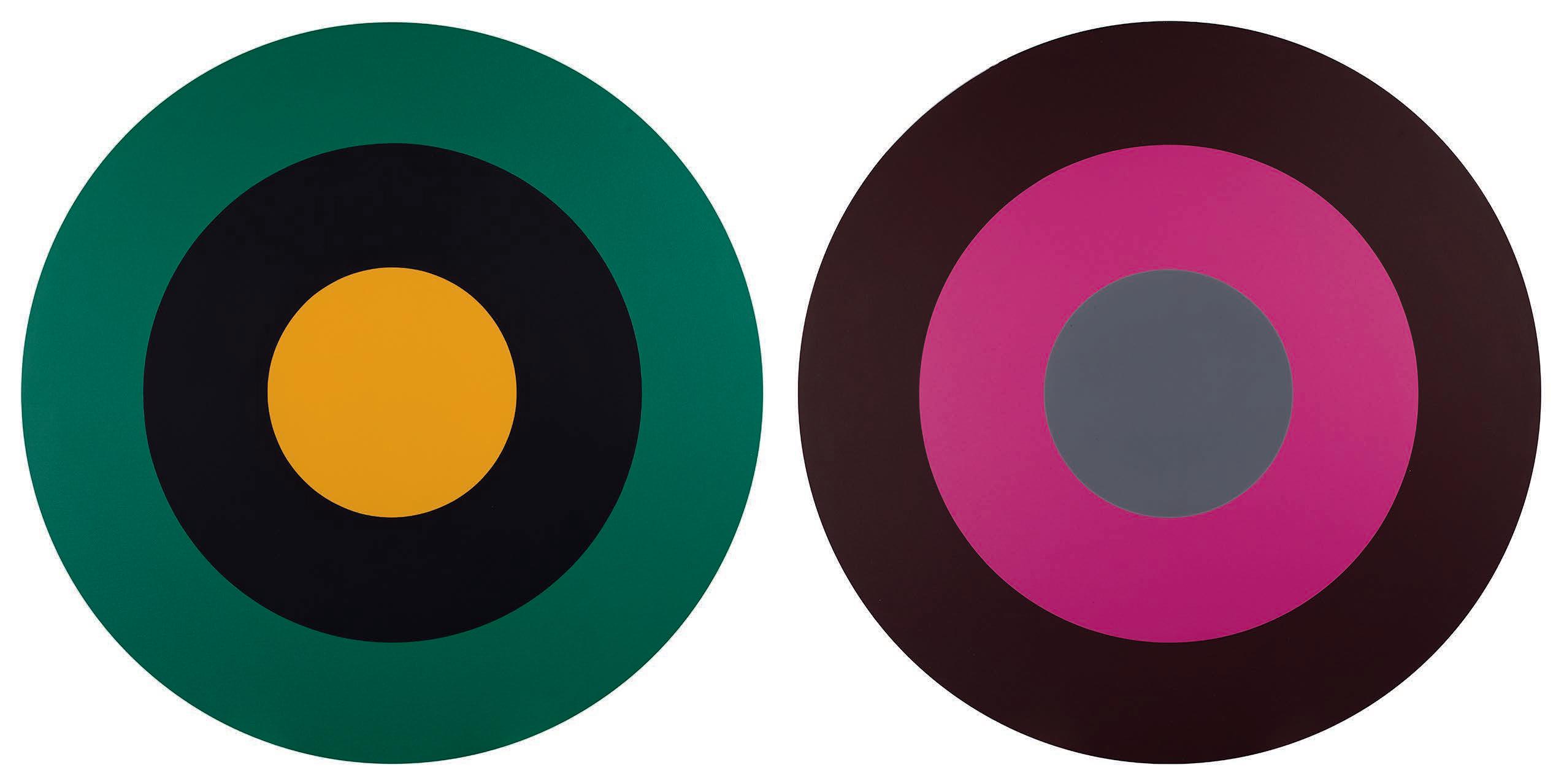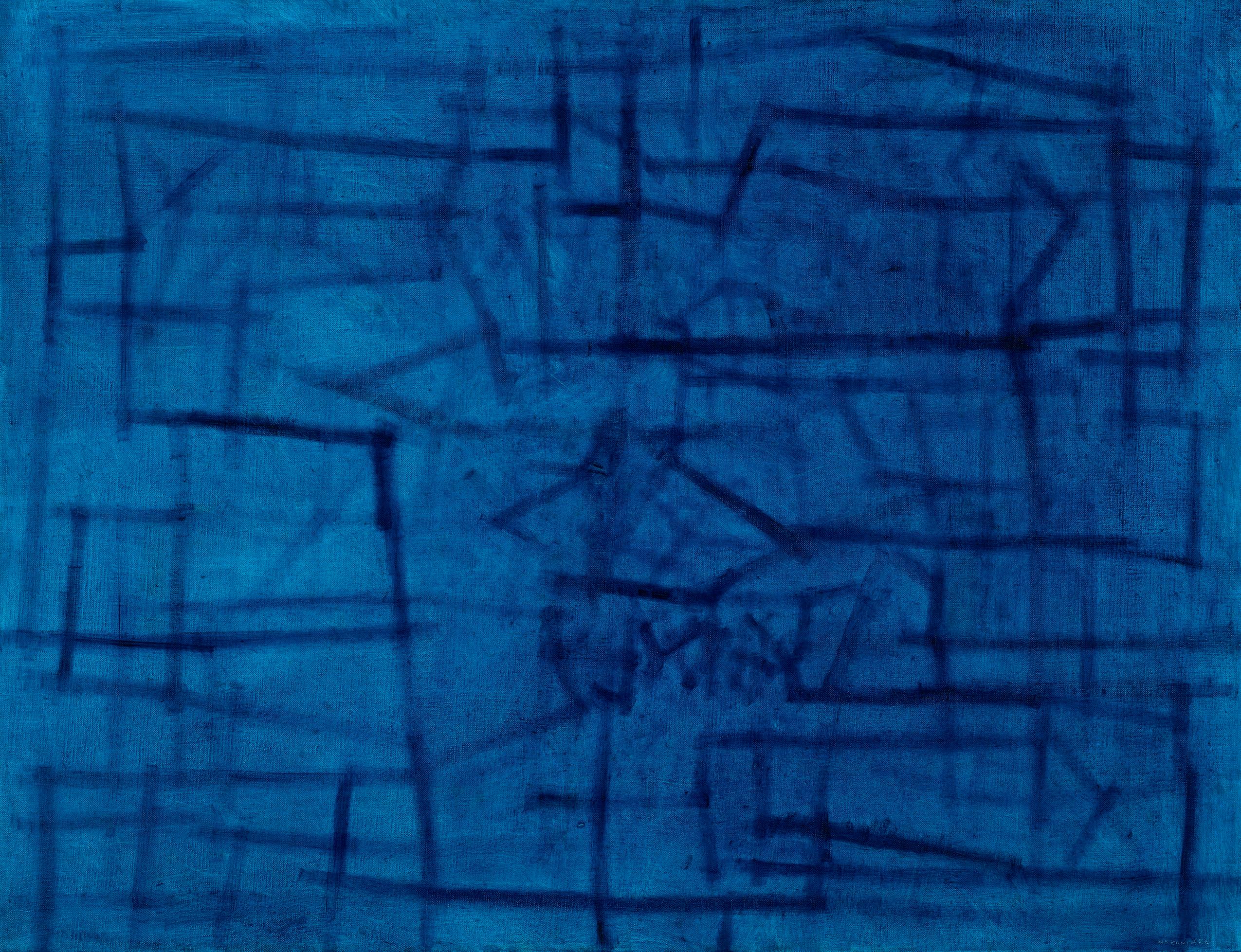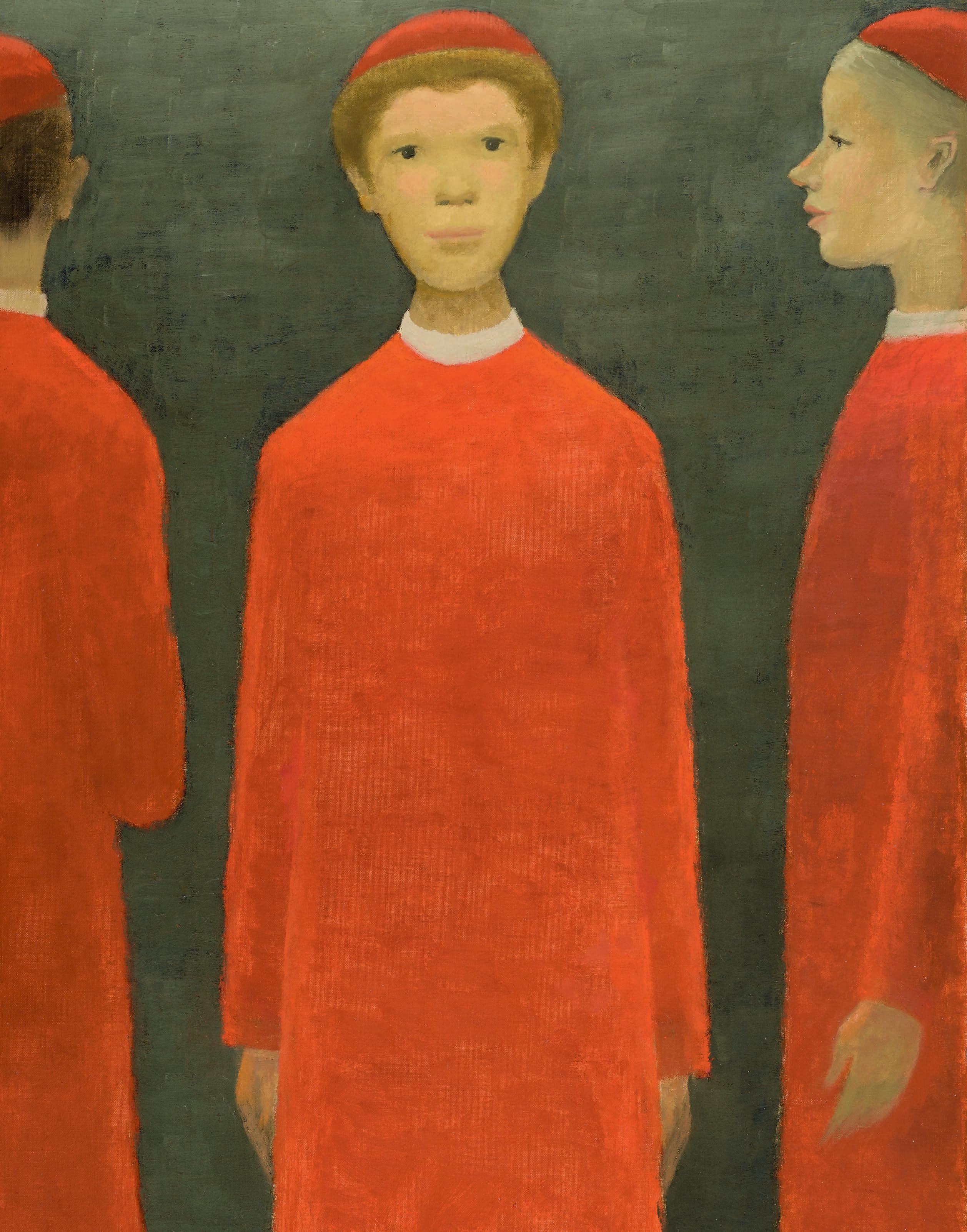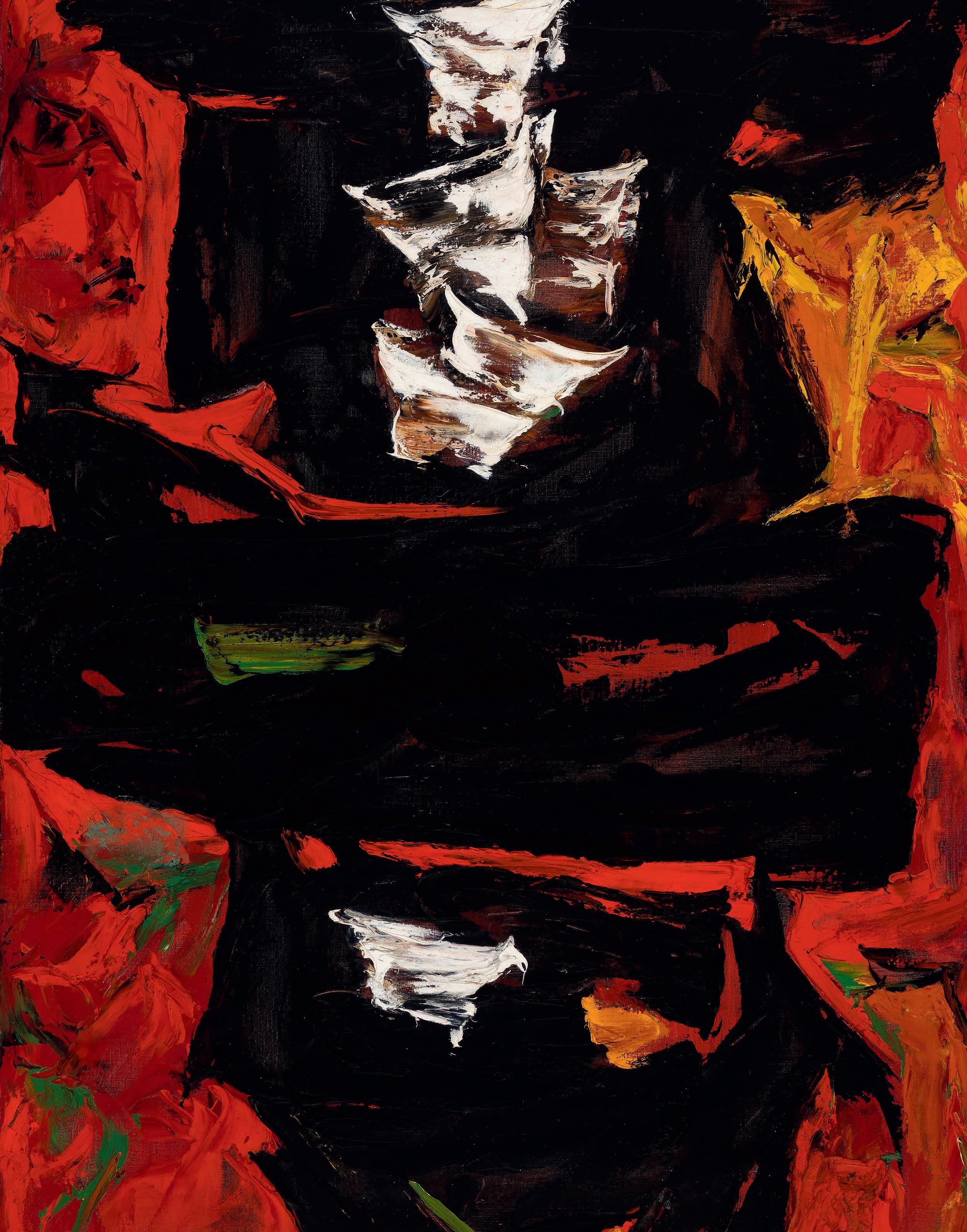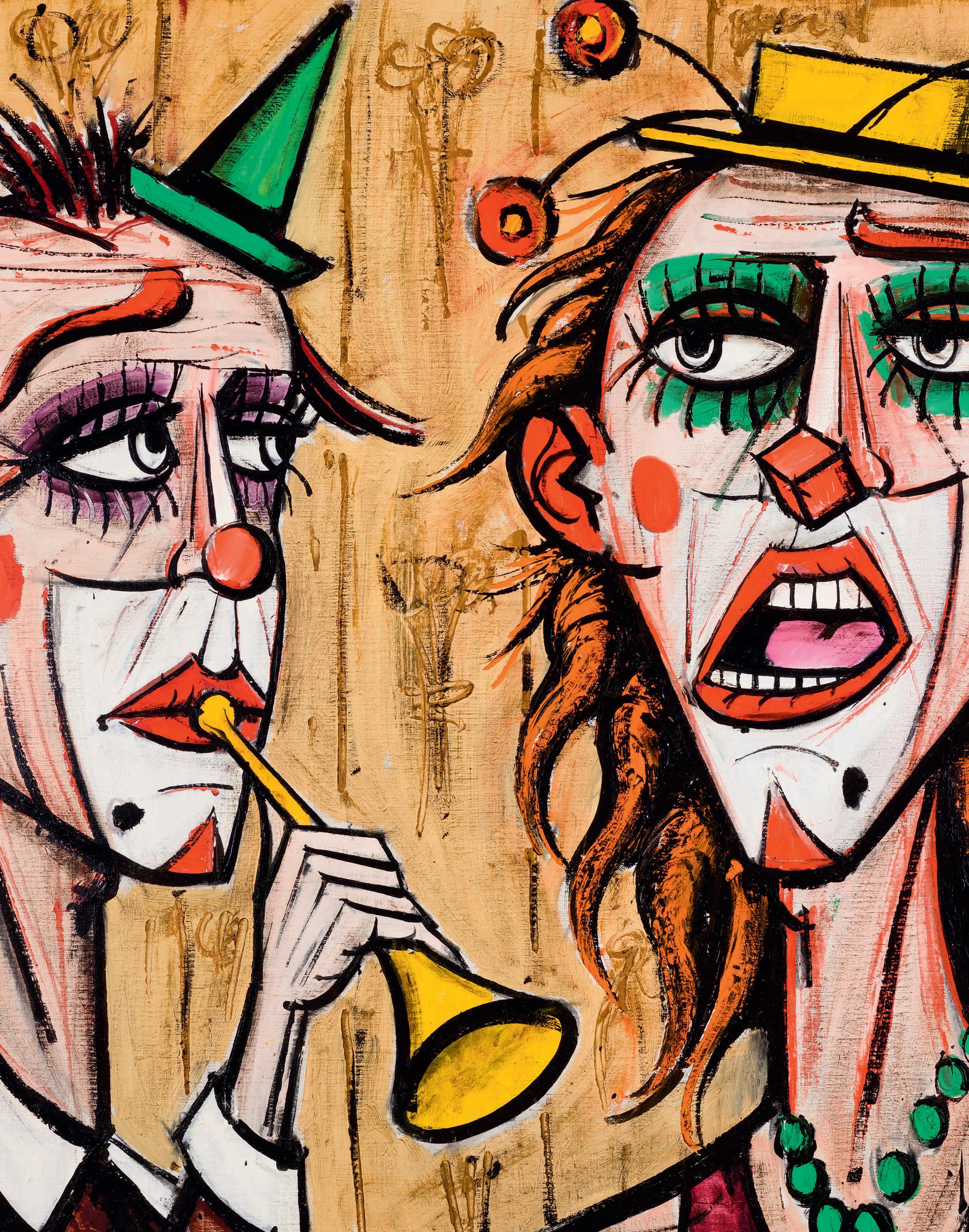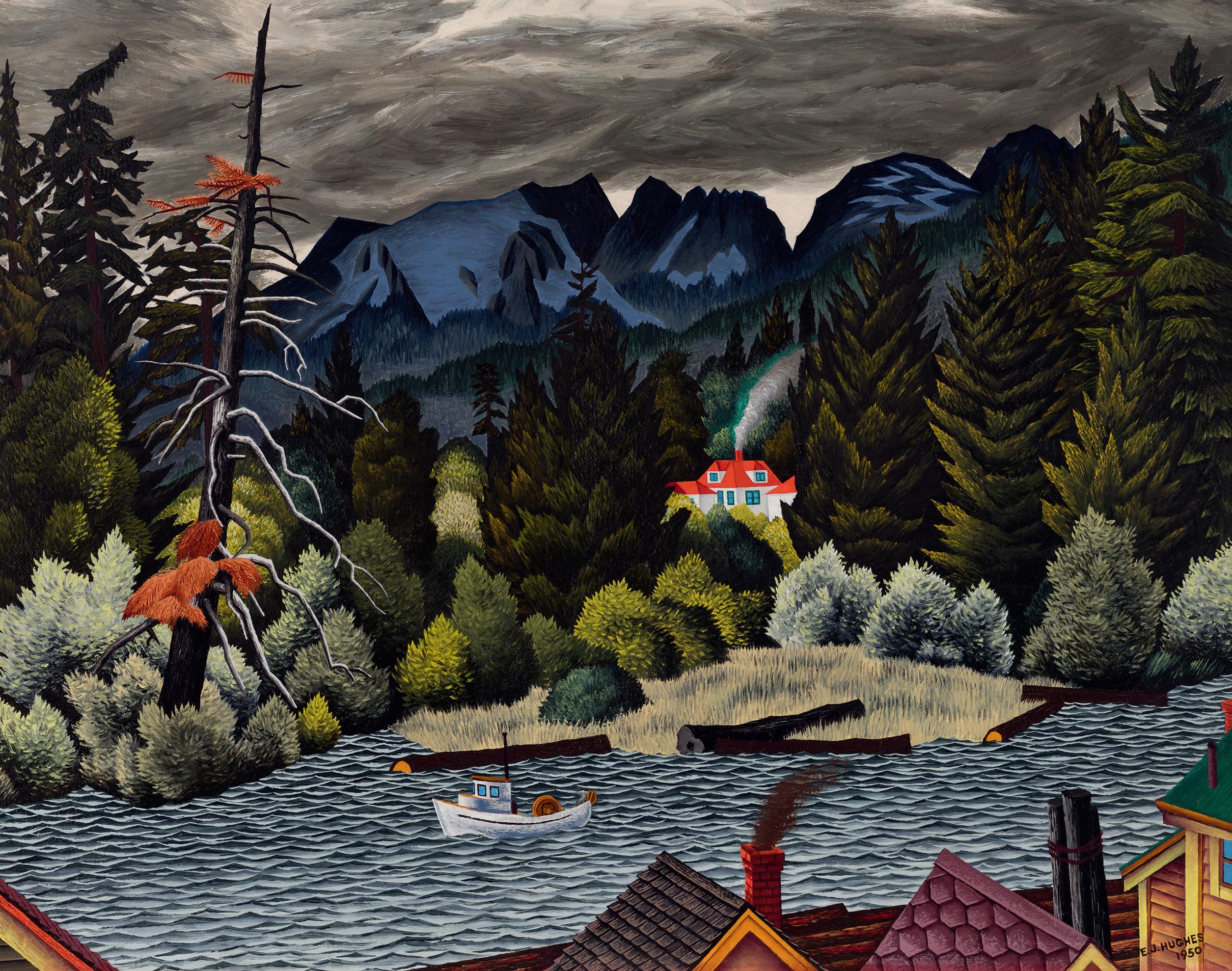l uigi r ossi
l ike fA mily: t he c ollection of d r. l uigi r ossi
dR . lUIGI R OSSI was born in 1956 in Smithers, a small town in northwestern British Columbia, where his parents Alba and Carmine had earlier immigrated to from Italy. With minimal education, money or knowledge of the English language, they left their family and what they had known as home, hoping to discover a place of opportunity and to create a rewarding life for themselves and the family they envisioned. To succeed, let alone survive, his parents knew they would have to work extremely hard.
Their work ethic was not lost on their son Luigi. From a very young age, whether academically or athletically, he had a simple outlook on life: if anything was worth doing, the only way to do it was to the best of one’s ability. He was always exceptional and excelled in whatever he did, while he remained incredibly humble in doing so. After completing high school, he enrolled at the University of British Columbia, where he completed his
bachelor of science in 1977 and subsequently obtained his doctor of medicine degree in 1981. He continued his education at the Foothills Hospital in Calgary and in 1986 graduated as a specialist in radiology with a licence to practise in Canada as well as the United States. He then moved to Grande Prairie, Alberta, located over 700 kilometres northwest of Calgary, and practised for 30 years at the regional hospital there as well as his clinic, until his passing in 2017.
Dr. Rossi’s collection of art had a modest beginning and can be traced back to 1982, though his interest had started much earlier. His passion continued to grow and even though Grande Prairie was far removed from major art centres, Dr. Rossi combined his love for traveling with that of art; he visited countless public and private galleries in North America and established relationships with many art dealers as well as the artists themselves.1
Collectors are not all cut from the same cloth and beauty is said to be in the eyes of the individual beholder. Collectors can have different perspectives or interests but share one meaningful characteristic—a deep passion for living with art, as one would envision being part of a family. This is not something that can be taught or copied from others: it is a lifelong journey of education and emotions.
A typical trajectory of collecting might be to start unassumingly, with emerging local artists, before taking the “plunge” and perhaps later, with a sense of history, acquiring work by precursors. In this way interests can shift and change over time. However, Dr. Rossi’s focus from the outset was Indigenous artists who were working in Western Canada, at a time when these artists had yet to be foregrounded in gallery exhibitions and critical writing in art magazines was sparse.2
Dr. Rossi acquired in depth works by artists who had been associated with the formative Professional Native Indian Artists Inc. (given the name the “Indian Group of Seven” by a Winnipeg art critic): Jackson Beardy, Eddy Cobiness, Norval Morrisseau, Daphne Odjig, Carl Ray, Joseph Sanchez and Alex Janvier, with whom he established a long friendship.3 Dr. Rossi’s interests continued to broaden and he acquired works by established artists Jack Bush, Rita Letendre, Gershon Iskowitz and Jack Shadbolt, and also landscape painters such as Robert Genn and Ted Harrison. Dr. Rossi’s collection was truly breathtaking, with many works rivaling what you would expect to discover in a museum. In turn he acquired intimate and thought-provoking works.
A hallmark of a committed collector is not needing to justify their choices but rather to satisfy their own love and passion for the art. Dr. Rossi did not follow fashion and market trends; he essentially established his own. There was no hint of architectural or design magazine staging in his Kelowna condo; an Iskowitz and a Shadbolt hung next to an Odjig, a Janvier next to a Letendre and a Bush, to underscore what the works shared. The walls and hallways disappeared in this intensive hanging: one frequent visitor “counted” over 100 works. Far from being claustrophobic, there was a sense of space and liveliness, a conversation of spirit on the walls that was enlivened by daylight pouring in from windows facing west over the city of Kelowna and Okanagan Lake.
s tew A rt t urcotte
Portrait of Dr. Luigi Rossi acrylic on canvas, 2018 18 × 14 in, 45.7 × 35.6 cm
I toured Dr. Rossi’s condo with Janvier in the summer of 2018 (my second time that year and a year after Dr. Rossi’s passing). We sat, talked, moved from room to room. Janvier offered comments on his own works that he had not seen for many years, but also those of other artists. It could well have been a conversation with Dr. Rossi. Living with art makes for a living collection and made so by the fine art of knowing, a discerning eye.
We thank Ihor Holubizky and the family of Dr. Rossi for contributing to the above text. Holubizky is one of the authors of The Rossi Collection: A Circle of Friends exhibition catalogue, published by the Kelowna Art Gallery.
1. The Art Gallery of Grande Prairie was established in 1975. Its current location opened in 2012.
2. An early and formative exhibition was Norval Morrisseau and the Emergence of the Image Makers, at the Art Gallery of Ontario in 1984.
3. While Inuit prints from the Kinngait (Cape Dorset), Qamani’tuaq (Baker Lake) and Ulukhaktok (Holman Island)
workshops were widely available and promoted from the 1960s on, the short-lived PNIAI (active from 1973 to 1975) offered a model for younger First Nations artists at a time when such cultural consciousness initiatives were rare.
Dr. Rossi’s life of collecting culminated with The Rossi Collection: A Circle of Friends, the 2018 exhibition mounted at the Kelowna Art Gallery. His collection was like a family to him, and on his behalf, members of his family were extremely proud to share these works with the public. Beyond its beauty and depth, the collection continues to resonate today as Canada advances on its path of truth and reconciliation. By foregrounding Indigenous voices and providing opportunity for artists who were once overlooked by mainstream institutions, Rossi’s legacy affirms the role of private collectors in shaping cultural awareness and dialogue. His vision continues to live on not only in the artwork he cherished but also in the conversations they bring forth—conversations about history, identity, and the responsibility we all share in building a more inclusive and reconciled future.
The Rossi Collection: A Circle of Friends, exhibition of the Kelowna Art Gallery, 2018 – 2019
Photo: Kyle L. Poirier Courtesy of the Kelowna Art Gallery
301 Rita Letendre
AANFM ARCA OC QMG 1928 – 2021
Sans titre
oil on canvas, signed and dated 1961 and on verso signed, titled and inscribed Daniel et Dagmar Limoges, [amitié] de Rita Letendre
29 × 25 in, 73.7 × 63.5 cm
Prov E nanc E
Galerie Simon Blais, Montreal Private Collection, Montreal
Canadian Post-War & Contemporary Art, Heffel Fine Art Auction House, May 28, 2014, lot 3
Dr. Luigi Rossi, Kelowna and Grande Prairie Estate of Dr. Luigi Rossi
Lit E ratur E
Wanda Nanibush and Georgiana Uhlyarik, Rita Letendre: Fire & Light, Art Gallery of Ontario, 2017, pages 16 and 19
Exhibit E d
Galerie Simon Blais, Rita Letendre: Ode à Isis, November 26, 2003 – February 7, 2004
The long and indelible career of Rita Letendre is marked by continual innovation and fearless exploration, defying rigid categorization. As Wanda Nanibush notes, “Letendre has found a variety of ways to work through the seemingly impossible unification of expressionism, lyrical abstraction, and hard-edged abstraction.” While her practice evolved over decades, the mid-1950s to early 1960s was a particularly formative period, culminating in a series of abstractions that would set the stage for both national and international acclaim.
The vibrant culture of Montreal avant-garde abstraction at the time, orbiting the influential artist and teacher Paul-Émile Borduas, sparked a profound shift in Letendre’s early work, propelling her towards exploring painting as a means of selfexpression and discovery. Initially engaging with the spontaneous, automatic approaches championed by Borduas and his
circle, Letendre would later experiment with ordered rhythms and structured grid formations loosely inspired by the Plasticiens. Despite these explorations, she maintained a distinctive lyrical sensibility in her compositions; her application of paint remained gestural, fluid and emotive, refusing to be confined by a stringent ideology. Experimentation and reinvention were vital forces in her practice, as she went on to develop a singular visual language rooted in a deep commitment to emotional expression and the intuitive act of creation.
For Letendre, painting was a visceral process—an attempt to access the inner workings of the self, to give form to emotional intensity, and to engage with the elemental energies at the core of human experience. By 1961, Letendre would move into one of her most productive and transformative periods, translating this ethos into a striking series of works infused with heightened dynamism, dramatic forms and visual tension. Light is a central motif of this period, punctuating moody surfaces with ebullient flashes of cool white or radiant flares of warmth. As Nanibush aptly observes, “Letendre is a master of colour and light; the fiery quality of her work is significant to what makes it beautiful. Light moves through her work like a beacon of hope, a pathway to somewhere else, and as an uncontainable futurity.”
In this exceptional 1961 canvas, Letendre creates a charged, immersive composition, entwining lively currents of movement and gestural bands of vibrant colour against a stormy field of inky black rendered in heavy impasto. The overall impression is of something organic, chaotic and unruly. Vertical swathes of crimson surge upwards, framing the dynamic tableau, anchored by a swirling pool of tranquil cerulean. Gravitational forces course across the surface, converging in brilliant bursts of luminous white—a spark of renewal, of steadfast hope, of life against the surging void. Here, Letendre masterfully balances opposing visual forces—light and darkness, flux and stillness—and conjures the propulsive, emotive thrill of an artist in the throes of creative discovery. In a career defined by regeneration, experimentation and unrelenting evolution, this work stands as a remarkable example from a vital and visionary period.
Estimat E : $ 30,000 – 50,000
302 Alex Simeon Janvier
CM PNIAI RCA WS 1935 – 2024
Exodus from the Soil acrylic on linen, signed and on verso titled, 1978 48 × 72 in, 121.9 × 182.9 cm
Prov E nanc E
Wallace Galleries Ltd., Calgary Acquired from the above by Dr. Luigi Rossi, Kelowna and Grande Prairie, 2004
Estate of Dr. Luigi Rossi
Lit E ratur E
Michelle LaVallee et al., 7: Professional Native Indian Artists Inc., MacKenzie Art Gallery, 2014, reproduced page 37 and listed page 353
Murray Whyte, “At the McMichael Gallery, the Other Group of Seven,” Toronto Star, May 13, 2015, reproduced The Rossi Collection: A Circle of Friends, Kelowna Art Gallery, 2018, listed page 44
Exhibit E d
MacKenzie Art Gallery, Regina, 7: Professional Native Indian Artists Inc., September 21, 2013 – January 12, 2014, traveling in 2014 – 2016 to the Winnipeg Art Gallery; Kelowna Art Gallery; McMichael Canadian Art Collection, Kleinburg; and Art Gallery of Windsor, catalogue #44
Kelowna Art Gallery, The Rossi Collection: A Circle of Friends, November 10, 2018 – January 20, 2019
Exodus from thE s oil is an impressively scaled and intricately detailed canvas by Denesųłiné artist Alex Janvier, completed in 1978. A warm white background serves as a spare field for Janvier’s wildly experimental and iconic brushed designs that were at the core of his more than 70-year career. With Exodus, Janvier has deviated from his strictly hard-edged paint application to include lightly brushed calligraphic strokes, like those typically used in underpainting while developing a canvas’s composition. Vine-like wisps burst outwards from the centre of the canvas like new growth searching for sunshine, water and support, forming an armature for Janvier’s harder, denser designs that cluster inside the connected systems in tones of cyan, orange and green.
The diverse iterations of patterning avoid cohering into identifiable subject matter or cultural symbols, instead maintaining an abstract language derived by the artist associatively, inspired by his upbringing and cumulative experiences as an artist. Janvier recalls growing up on the Le Goff Reserve, Cold Lake First Nations, in northern Alberta: “The old porcupine quill designs were angular and straight-edged. In later years, the Hudson’s Bay beads came, and the geometric rigidity was loosened by the freedom of the new beads. This is where my art began, watching the old ladies doing their new free-flowing designs.”
His drive towards abstraction, influenced by both Indigenous traditions and Western styles, would impact Janvier’s entire career artistically and politically. In 1973, Janvier, along with fellow artists Jackson Beardy, Eddy Cobiness, Norval Morisseau, Daphne Odjig, Carl Ray and Joseph Sanchez, formed Professional
Native Indian Artists Inc. (PNIAI ), a legally incorporated entity with the goal of promoting these Indigenous Canadian artists as a collective. The group sought recognition from galleries, institutions and the government that had to this point excluded Indigenous artists from official canons of Canadian art history.
A PNIAI group exhibition at Max Stern’s influential Dominion Gallery in Montreal in 1975 proved to be a watershed moment, opening a succession of opportunities for the seven PNIAI artists. By 1978, the year this canvas was produced, PNIAI was winding down its activities in part due to the success of meeting its original objectives and the strength of its members’ individual careers. Janvier had by this time garnered countless important commissions, sales and exhibitions internationally.
Exodus from the Soil was a centrepiece of the traveling 2014 exhibition 7: Professional Native Indian Artists Inc., originating at the MacKenzie Art Gallery in Regina and curated by Michelle LaVallee. The exhibition’s award-winning catalogue, which reproduces this work, discusses the group’s lengthy battles for Indigenous recognition in Canadian art and the countless obstacles that Janvier and PNIAI overcame due to their resilience and collective sense of purpose. With ancestral ties and connection to the land at the core of PNIAI and Janvier’s ethos, the group worked to develop a new, modern Indigenous art language that gained recognition in the Canadian art world.
Exodus from the Soil reflects Janvier’s deep cultural and spiritual attachment to the land, rooted in the soil’s regenerative properties that allow for the seasonal flourishing of plants and animals that sustain us. The painting can be read as richly symbolic of Janvier’s vision for a growing, self-determined Indigenous art movement in Canada and its limitless potential. During his speech at the opening of the Regina exhibition, Janvier said, “Our story is really a Canadian story, a real Canadian story. It comes from here, by the people from here, and it’s about here. I welcome you all to take a good look and feel proud.”
Estimat E : $ 50,000 – 70,000
Alex Janvier’s Exodus from the Soil (centre left) on view at the MacKenzie Art Gallery, Regina, 2014
Photo: Don Hall
Courtesy of the MacKenzie Art Gallery
303 Alex Simeon Janvier
CM PNIAI RCA WS 1935 – 2024
Back to Shinny
acrylic on linen, signed and on verso titled, dated 1984 on the gallery label and inscribed EBB -16
30 × 36 in, 76.2 × 91.4 cm
Proven A nce
Gallery Moos, Toronto
Dr. Luigi Rossi, Kelowna and Grande Prairie
Estate of Dr. Luigi Rossi
l iter A ture
The Rossi Collection: A Circle of Friends, Kelowna Art Gallery, 2018, listed page 44
e xhibited
Kelowna Art Gallery, The Rossi Collection: A Circle of Friends, November 10, 2018 – January 20, 2019
T HE TIT l E O f this brilliant 1984 canvas, Back to Shinny, refers to one of Alex Janvier’s great passions and sources of inspiration: hockey. Shinny is one name for an informal game of hockey, usually played on a frozen pond or an empty stretch of pavement. The game typically has no goaltenders, no contact, and players often resort to makeshift sticks, goals, and pucks or balls.
It is easy to see how the improvisational game might have informed the development of Janvier’s distinctive abstract visual language. Much like players weaving between and around each other, the painted lines of flight in this work radiate and circle each other in unpredictable patterns, as if tracing the players’ movements from above. Back to Shinny also glows with colour. Its dancing hard-edged lines, seemingly illuminated by the light of the central, sun-like orb, glisten with tones of peach, teal and orange. Reminiscent of a Prairie morning, the abutted colours vibrate with an excitement that was almost certainly felt by the artist, anticipating returning to his beloved game.
e stim A te: $ 20,000 – 30,000
304 Gershon Iskowitz
CSGA RCA 1919 – 1988
Green Yellow Orange Painting oil on canvas, on verso signed, titled, dated 1974 and inscribed B 251 43 × 39 in, 109.2 × 99.1 cm
Proven A nce
Miriam Shiell Fine Art, Toronto
Dr. Luigi Rossi, Kelowna and Grande Prairie Estate of Dr. Luigi Rossi
l iter A ture
Adele Freedman, Gershon Iskowitz: Painter of Light, Gallery Moos, 1982, page 113
I N 1967, G ERSHON I SKOWIT z received a Canada Council travel grant to fly to Churchill, Manitoba, following a suggestion by photographer John Reeves that his paintings carried an “aerial perspective.” From a helicopter, Iskowitz recognized in the
scattered lakes, cloud formations and forest clusters of Northern Canada the motifs he had been working towards in his increasingly abstract painting practice. As Adele Freedman notes, based on extensive interviews with the artist, “He saw bright colours exploding through the layers of clouds, land masses breaking through atmospheric barriers, dramas enacted on epic scale by the protagonists—space, form, and colour.” He continued to travel to new northern destinations in the following years, sketching what he saw in his hotel rooms and then beginning large-scale canvases once back in his Spadina Street studio in Toronto.
Green Yellow Orange Painting, completed in 1974, is exemplary of the artist’s new expanded vision for his practice. After his 1972 exhibition representing Canada at the Venice Biennale, Iskowitz’s canvases became increasingly more confident. Through his precise juxtaposition of colour and form, they exuded the exhilarating sensation of viewing great Canadian landscapes from the skies above.
e stim A te: $ 20,000 – 30,000
305 Ted Harrison
OC SCA 1926 – 2015
Waving Hills
acrylic on canvas, signed and on verso signed, titled and dated 1988
48 × 60 in, 121.9 × 152.4 cm
Proven A nce
Harrison Galleries, Vancouver Private Collection, Toronto
Fine Canadian Art, Heffel Fine Art Auction House, November 26, 2005, lot 247
Dr. Luigi Rossi, Kelowna and Grande Prairie Estate of Dr. Luigi Rossi
l iter A ture
Katherine Gibson, Ted Harrison: Painting Paradise, 2009, page 126
The Rossi Collection: A Circle of Friends, Kelowna Art Gallery, 2018, reproduced page 23
e xhibited
Kelowna Art Gallery, The Rossi Collection: A Circle of Friends, November 10, 2018 – January 20, 2019
Waving hillS IS a spectacularly scaled and brilliant painting by Ted Harrison, an artist known as the quintessential painter of the Yukon. Harrison was born in the working-class town of Wingate, County Durham, Northern England in 1926 and did not arrive in the Yukon until 1968, after deployments to East Africa and India with the British Armed Forces and teaching posts in Malaysia and New Zealand. Although the colours and energies of these locations would stay with him throughout his career, the distinctive style he is now renowned for only emerged when he arrived in northern Alberta in 1967. He was offered a grant to write and illustrate his first children’s alphabet book as a teaching tool, depicting northern and Indigenous ways of living. He took stock of local animals, food preparation, industry, shelter, social dynamics and natural formations that would later shape the iconography of his northern paintings for decades to come.
After accepting a new teaching position in Carcross, Yukon, a village two hours south of Whitehorse, Harrison’s iconic vision began to coalesce, finally reaching its full force after he relocated to Whitehorse. He painted lively and populated town scenes amongst vernacular buildings, backed by the expansive skies that would come to dominate his more monumental late works. Harrison’s signature imagery made use of flat areas of saturated colour, often divided by uniform graphic lines, creating an elemental and propulsive visual language deftly tuned to conveying the majesty of the Yukon. According to Harrison: “By a process of retrogression and simplification I threw out all the academic brica-brac which had stratified my thoughts. From there, my personal view of the Yukon began to emerge, leading to greater freedom of line and colour.”
In Waving Hills, the landscape dwarfs the traces of human life, here just a tiny cluster of buildings nestled at the bottom of the work. Two figures walk closely together, depicted in a “matchstick” style reminiscent of the busy city folk populating the Manchester paintings of Lawrence Stephen Lowry (1887 – 1976). Here, natural features dominate as repeating bands of orange, blue, purple and pink undulate across the painting, outlining the landforms and ocean horizon as they pulsate together. The mountains and clouds separate into a nearly symmetrical composition around the central island, giving the sense of a supernatural or spiritual occurrence. A lone raven hovering in the bottom left corner—a recurring motif for Harrison—symbolizes the proudly independent and solitary nature of northern living.
Harrison’s work was wildly popular during his lifetime, receiving accolades and adoration from far and wide. His increasing exhibition schedule led him to give up his teaching position to paint full time in 1979. Harrison received the Order of Canada in 1987, and in 1988, the year this work was completed, his work appeared on the front cover of Reader’s Digest magazine. The demand for his work has only grown since his death in 2015, serving as testament to the ongoing appeal of his optimistic and resonant vision of northern life.
e stim A te: $ 30,000 – 50,000
306 Ted Harrison
OC SCA 1926 – 2015
North of Yellowknife
acrylic on canvas, signed and on verso signed twice, titled and dated 1990
36 × 48 in, 91.4 × 121.9 cm
Prov E nanc E
Robertson Galleries Limited, Ottawa
Acquired from the above by Dr. Luigi Rossi, Kelowna and Grande Prairie, 1991
Estate of Dr. Luigi Rossi
“How do I paint this sky and these mountains? How can I capture the movement, the music of this land? It is too big, too wild, to put on canvas.” Ted Harrison expressed this sentiment to me over a glass of Japanese plum wine late one August afternoon in 2005. It underlined his frustration after he emigrated from northern England to Carcross, Yukon, in 1968. As we now know, he eventually found his unique style, one we celebrate and treasure today.
While his work fits neatly into the folk art genre typified by self-taught Nova Scotian painters Maud Lewis and Joe Norris, Harrison stood apart, for he completed four years of college education in art and design. He classified his work as “Naïve Expressionism,” a nod to his formal training.
In 1971, Globe and Mail art critic Kay Kritzwiser attended Harrison’s first solo exhibition, at Robertson Galleries in Ottawa. Her review catapulted him into our national cultural conversation. She wrote, “Take a Grandma Moses dog, add a tilted shack in black Matisse line, put a Miró moon (or two or three) in a sky and you ought to have a painting like any in the exhibition by Yukon artist Ted Harrison. . . . [The works have] the sophistication of a traditional art education background.” 1
“I like twisted buildings, I like to use heavy black lines,” said Harrison during one of our interviews. “Sometimes I paint a sun and moon in the same picture. Art is the last free expression of man and so I damn well paint as I please.” And that he did! We might find a pink or blue moose. He often set a paddlewheeler on land—not on a river—and happily posed it beside a church, next to tipsy houses.
Harrison’s artistic talents were paired with his insatiable curiosity and genuine warmth, infused with a quirky sense of humour. His narrative scenes of community life—children sliding on toboggans or chasing ravens, gaily coloured buildings, and often an outhouse—show us what fun it is to live in the North.
Harrison attributed the colours in his paintings to his four years teaching art at General Slim School in the Cameron Highlands of Malaysia, from 1958 to 1962. Ever the poet, he described that country as a paradise, a “warm flowery land washed by tropical rains.” 2
Although his work evokes an innocent charm, it evolved from an underpainting of hardships he experienced during a Depression-era childhood. Later, while serving with the British Army in Egypt between 1945 and 1950, he witnessed atrocities that deeply affected him. “There is enough pain and suffering in the world without putting it on our walls,” he told me. And so Harrison chose happy themes with an uncomplicated sense of joy.
The stunning canvas North of Yellowknife (1990) illustrates Harrison’s philosophy. We see a fascinating depiction of a landscape that takes us to the top of the world in vibrating motion. His swirling skies dominate a diminutive human camp that is but a footnote in this work, underscoring the power of the natural world both on, and above, the land.
Harrison’s work reminds us that happiness can be found in what lies just beyond our front doors: folks waving to each other, playful dogs, shadows on snow, and mischievous ravens. And above all, as Harrison shows us, happiness also lives in the profound beauty of each sunrise and sunset.
Among the many awards the artist received during his lifetime are five honorary doctorates and the Order of Canada. His work hangs in private, public and corporate collections across Canada, England, Australia, New Zealand, the USA , Germany, Malaysia, Denmark, South Africa and Japan.
We thank Katherine Gibson, author of Ted Harrison: Painting Paradise, for contributing the above essay.
1. Kay Kritzwiser, art review, Globe and Mail, January 29, 1971.
2. Ted Harrison, The Last Horizon (Toronto: Merritt Publishing, 1980), 71, as quoted in Katherine Gibson, Ted Harrison: Painting Paradise (Victoria: Crown Publications, 2009), 93.
Estimat E : $ 20,000 – 30,000
307 Daphne Odjig
FCA OC PNIAI RCA WS 1919 – 2016
Rhythm of the Northern Lights
acrylic on canvas, signed and on verso titled, dated 1983 and inscribed A 314
48 × 40 in, 121.9 × 101.6 cm
Proven A nce
Shayne Gallery, Montreal
Private Collection, Montreal
Canadian Post-War & Contemporary Art, Heffel Fine Art Auction House, November 26, 2009, lot 100
Dr. Luigi Rossi, Kelowna and Grande Prairie Estate of Dr. Luigi Rossi
l iter A ture
Daphne Odjig et al., A Paintbrush in My Hand: Daphne Odjig, 1992, page 84
e xhibited
Kelowna Art Gallery, The Rossi Collection: A Circle of Friends, November 10, 2018 – January 20, 2019
dAPHNE Od JIG WAS one of the most important Indigenous artists of the twentieth century and a groundbreaking figure in Canadian art. Born on the Wikwemikong Reserve on Manitoulin Island, Odjig was of Odawa-Potawatomi-English heritage. Encouraged to draw from a young age, she gravitated naturally towards a life in art. Though her early influences were largely European, her style evolved over time to incorporate Anishinaabe world views, personal memory and modernist experimentation, resulting in a singular and powerful visual language.
Rhythm of the Northern Lights from 1983 is a compelling example of Odjig’s mature style and spiritual vision. Richly coloured and densely composed, the painting features a cluster of curving figures rendered in her signature bold lines and saturated hues. The forms flow into one another, creating a sense of unity, spiritual connection and shared experience. There is no single focal point; instead, the viewer is drawn into a visual rhythm that mirrors both the energy of the natural world and the interconnectedness of human relationships.
This work was created during a period of heightened recognition and creative intensity for Odjig. That same year, she participated in the National Native Indian Artists Symposium in Ksan, British Columbia, an event that marked a turning point in her career. Works from this period often exhibit a shift towards immersive, layered compositions in which figures and landscape merge as one. Rhythm of the Northern Lights exemplifies this approach. The figures seem to pulse with movement, evoking not only physical presence but also spiritual transformation.
Odjig’s fascination with distortion and layered imagery plays a central role in this piece. As she explained in her book A Paintbrush in My Hand, “I loved to distort things. . Picasso distorted. Ever since I was a child I elongated necks and always did faces over on top of others. But for me that had a [cultural] meaning to it. . . . One face emerging from another would be like the spirit of that person leaving that individual.” In Rhythm of the Northern Lights, this sensibility is vividly expressed as the figures appear to dissolve into one another, their overlapping forms suggesting ancestral presence, memory and spiritual continuity.
Odjig’s paintings often explore themes of family, womanhood and community. Here, her deep respect for relational bonds is not conveyed through literal narrative, but through an abstract visual harmony that speaks to resilience and belonging. At the same time, her confident manipulation of scale, space and form places her within the modernist canon.
Throughout her career, Odjig challenged cultural and aesthetic boundaries. In 1971, she opened Canada’s first Indigenous-owned commercial art gallery, and in 1973, co-founded Professional Native Indian Artists Inc. Her work synthesized diverse influences—Northwest Coast design, pictographic traditions and Cubist fragmentation—into a bold and expressive style that was always deeply personal and culturally grounded. Rhythm of the Northern Lights embodies her singular vision: a vibrant expression of Indigenous identity, alive with movement, memory and spiritual force.
e stim A te: $ 40,000 – 60,000
308 Jack Leonard Shadbolt
BCSFA CGP CSPWC OC RCA 1909 – 1998
Event on the Rocks
acrylic and latex on board (triptych), signed and dated 1977 and on verso signed, titled and dated 60 × 120 in, 152.4 × 304.8 cm
Proven A nce
Bau-Xi Gallery, Vancouver
Dr. Luigi Rossi, Kelowna and Grande Prairie Estate of Dr. Luigi Rossi
l iter A ture
The Rossi Collection: A Circle of Friends, Kelowna Art Gallery, 2018, titled as Event on the Docks Triptych, reproduced page 38 and detail on back cover, listed page 45
e xhibited
Kelowna Art Gallery, The Rossi Collection: A Circle of Friends, November 10, 2018 – January 20, 2019
J ACK lEONAR d S HA d BO lT was a remarkable figure in the art history of British Columbia. Born in the United Kingdom, Shadbolt came to Canada as a child, settling with his family in Victoria. An accomplished artist from early in his career, Shadbolt taught at the Vancouver School of Decorative and Applied Arts (now Emily Carr University of Art + Design). Shadbolt was drawn to the natural world but his work was often strongly abstracted. He would begin studies of nature quite directly but as his work developed, the immediate connection to the environment was altered by the artist’s interest in abstraction. Shadbolt was a keen observer of nature and his interest in the butterfly—a creature that undergoes fascinating transformations through its life cycle— was long-standing.
Shadbolt’s vision of the natural world was expansive, and this vision is reflected in the numerous multi-panel works that date from the latter part of his career. These large-scale paintings on conservation mat board, glazed in Plexiglas frames, reflect both the grandeur of Shadbolt’s vision and the impact of his visual statements.
Event on the Rocks is a fine example of Shadbolt’s painting ambition and his willingness to produce images that can be read in a variety of ways. This three-panel work is at once quite clear and distinctly ambiguous. The panels are painted with strength and confidence, and yet the meaning of the image remains opaque.
The title, Event on the Rocks, is descriptive but when we look at the image, the “event” is unclear and, indeed, the rocks themselves are ill defined. Are we meant to read the rocks as being below and behind the two roughly hewn logs that visually link the three panels? The viewpoint upon these logs, which is strongly vertical, seems to suggest otherwise. Obviously, the log forms, each of which spans two panels, provide a visual link but they do not suggest rocks, which remain ill-defined in the image. Similarly, the background forms of the sea and land provide only slight evidence of a craggy landscape, most notably in the
central and right panels. All three panels are animated by linear patterns that hint at sandy beaches, but perhaps this reading is too straightforward. While the background of each panel may be read as a patch of sand and the ocean beyond, Shadbolt has been careful not to precisely define any aspect of the backgrounds of the panels.
Our attention is directed to the log and butterfly forms that appear in each panel. Striking as these butterfly forms are, here too Shadbolt has confounded our expectations. Where we expect the butterflies to have similarly patterned wings, Shadbolt has depicted their forms vividly but using varied patterns on each wing. The pattern is more closely matched on the butterfly to the left, but the butterfly on the right panel has distinctly different wings. Both images suggest movement and variety within the natural world, but the central panel is the most unusual image. What do we have here? A butterfly emerging from the chrysalis form or an insect dying? One cannot be sure. The image may depict life or death or a transitionary stage.
What is certain is that this image is one Shadbolt has painted with confidence and skill. The work has a deliberate openness and mystery. Shadbolt, leery of too literal an interpretation, has given the viewer the freedom to interpret his meaning. The mystery of this image brings us back to Shadbolt’s title, Event on the Rocks. It is up to us, as viewers, to engage with the work and to define the meaning of the “event.” This strategy on Shadbolt’s part strongly suggests his belief in the centrality of looking at and meaningfully engaging with art.
We thank Ian M. Thom, Senior Curator—Historical at the Vancouver Art Gallery from 1988 to 2018, for contributing the above essay.
This work is a triptych consisting of three panels each measuring 60 × 40 inches.
e stim A te: $ 40,000 – 60,000
309 Edward John (E.J.) Hughes
BCSFA CGP OC RCA 1913 – 2007
Courtenay River Landscape
oil on canvas, signed and dated 1950 and on verso signed, titled, dated 1950 and inscribed LT COAT 16
OCT 46, COAT PT SPRING 47, V TH W LD DEC 1947
and 1 G / 2 G / 3 G / 4 G on each corner of the stretcher
19 1/8 × 24 1/4 in, 48.6 × 61.6 cm
Proven A nce
Dominion Gallery, Montreal
J.S. McLean, Toronto, president, Canada Packers Ltd.
By descent to Mary Stewart, Toronto
By descent to a Private Collection, Victoria
By descent to the present Private Collection, London, United Kingdom
l iter A ture
Robert Ayre, “New Exhibitions Bring out a Galaxy of Colourful Works,” Montreal Star, October 27, 1951, page 16
Doris Shadbolt, E.J. Hughes, Vancouver Art Gallery, 1967, the related 1952 oil Mouth of the Courtenay River reproduced, unpaginated
lan M. Thom, E.J. Hughes, Vancouver Art Gallery, 2002, the related 1952 oil discussed page 108, reproduced page 109
Jacques Barbeau, A Journey with E.J. Hughes: One Collector’s Odyssey, 2005, the related 2003 watercolour Mouth of the Courtenay River reproduced page 110
Canadian Post-War & Contemporary Art, Heffel Fine Art Auction House, June 17, 2009, the related 1952 drawing Mouth of the Courtenay River reproduced page 12, lot 5
Jacques Barbeau, The E.J. Hughes Album, Volume 1, The Paintings, 1932 – 1991, 2011, reproduced page 12 and listed page 90
e xhibited
Vancouver Art Gallery, Quarterly Group Show, June 20 – July 9, 1950
Not for sale with this lot
Vancouver Art Gallery, 2 1st Annual B.C. Artists’ Exhibition, 1952, the related 1952 oil, price $ 150
Vancouver Art Gallery, E.J. Hughes: A Retrospective Exhibition, October 5 – 29, 1967, traveling to York University, Toronto, November 13 – December 8, 1967, the related 1952 oil, catalogue #23
Vancouver Art Gallery, E.J. Hughes, January 30 – June 8, 2003, traveling in 2003 – 2004 to the McMichael Canadian Art Collection, Kleinburg, and the Art Gallery of Greater Victoria, the related 1952 oil
e dw A rd John ( e .J.) h ughes Study for Courtenay River Landscape pencil drawing, 1948
details
CourTEnay rivEr landSCapE is a prime example of the so-called primitive paintings E.J. Hughes created in the years immediately following his service as an official war artist for Canada. These distinctive canvases have always been considered his most important works, treasured for their powerful lighting effects and bold perspectival shifts. It is especially interesting to discover a painting such as this one, which has not been seen in a very long time.
Soon after his discharge from the army, Hughes was awarded the Emily Carr Scholarship. This prize enabled him in 1948 to travel by bus up the east coast of Vancouver Island, during which expedition he made a large number of sketches. While staying at Courtenay, the most northerly point of the journey, he hiked east towards Comox and from there drew scenes that served him throughout his career.
Courtenay River Landscape shows a scene just below the bridge to Courtenay, looking west towards the mountains of the Forbidden Plateau. Hughes adopted his “primitive style” after a 1945 visit to New York’s Museum of Modern Art, where he was inspired by The Sleeping Gypsy (1897) by the French Naïve painter
Henri Rousseau. Hughes explained his attachment to this style: “I admire the primitives so much, especially with the slight flattening, the distortion of perspective to make the shapes more interesting on the picture plane.” 1
In the middle distance, stylized tree forms reach for the sky, and beyond them the snowy peaks of Strathcona, BC ’s oldest provincial park, are overtopped by heavy clouds. A pool of light in the centre illuminates the bright white farmhouse with its vivid red roof. Rising from the home’s central chimney, a plume of white smoke echoes the dark smoke drifting from the chimney in the foreground. Further animating the composition, a single fishing boat with a seine spool heads downstream. Details throughout the painting, whether waves or leaves or tufts of grass, are not handled naturalistically but are reduced to stylized motifs endlessly repeated.
Courtenay River Landscape was originally shown at the Vancouver Art Gallery’s first Quarterly Group Show “for upcoming talent,” held from June 20 to July 9, 1950. A year later Montreal gallerist Max Stern, following Lawren Harris’s advice, sought out Hughes in his Shawnigan Lake home and on that memorable day bought
e dw A rd John ( e .J.) h ughes
Proposal for a mural for
Not for sale with this lot
everything Hughes had in his studio. Courtenay River Landscape was one of 13 oils he purchased, and it was soon sold by Stern’s Dominion Gallery to J.S. McLean, president of Canada Packers Ltd. Stern became Hughes’s sole agent and went on to buy everything the artist produced, an arrangement that lasted for the next half century.
Two years later, Doris Shadbolt wrote about Hughes in Canadian Art Magazine, noting the special mood of his work: “The faint darkening in the sky, which for the moment so sharpens colours and atmosphere, tells us it cannot last.” 2 In August 1958, Hughes proposed the image of Courtenay River Landscape for a mural in Toronto’s Royal York Hotel, though eventually a view of Qualicum Beach was chosen.
Joan Lowndes, reviewing Hughes’s first retrospective in 1967, expressed her reaction to the artist’s early paintings: “Suddenly as you step into the large Emily Carr gallery, you are overwhelmed by the strength of the artist’s forms, by the supernatural quality of his light, and by the intensely personal nature of his vision.” 3
In years to come, his arrangement with the Dominion Gallery gave Hughes confidence and he set aside the “primitive” style, developing a more naturalistic, albeit still acutely technical approach. But the power of these early paintings, coloured by the intensity of his wartime experiences and the uncertainty of his artistic future, have made them the most desirable of Hughes’s oeuvre.
We thank Robert Amos, artist and writer from Victoria, BC , for contributing the above essay. Amos is the official biographer of Hughes and has so far published five books on his work. Building on the archives of Hughes’s friend Pat Salmon, Amos is at work on a catalogue raisonné of the artist’s work.
1. Quoted in The Lively Arts, CBC Television program, 1961.
2. Doris Shadbolt, “Ed Hughes—Painter of the West Coast,” Canadian Art Magazine, Spring 1953, 100.
3. Joan Lowndes, “The Hughes Revelation,” Vancouver Province, October 6, 1967.
e stim A te: $ 300,000 – 400,000
Near the Mouth of the Courtenay River (Vancouver Island) pencil drawing, August 1958
the Royal York Hotel
310 Jean Paul Lemieux
CC QMG RCA 1904 – 1990
Les enfants de choeur oil on canvas, signed and dated 1966 43 × 22 3/4 in, 109.2 × 57.8 cm
Proven A nce
Acquired directly from the Artist Private Collection, Toronto By descent to the present Private Collection, Toronto
l iter A ture
List of paintings by Jean Paul Lemieux, 1965 – 1980 [sale inventory], “January to December 1966,” Fonds Jean Paul Lemieux and Madeleine Des Rosiers, R 6612, Bibliothèques et Archives nationales du Québec, listed, unpaginated Guy Robert, Lemieux, 1975, reproduced page 222
IN lES EnfanTS d E C ho E ur , three characters compete for the narrow space of the canvas. Their truncated bodies appear at the bottom, to the left, and to the right of the composition. Jean Paul Lemieux has arranged the choirboys facing away, head-on, and in profile, in such a way that the trio gives the strange impression of being in motion—one moving away, another approaching, and the third crossing the pictorial field from right to left. Lemieux has dressed them in bright crimson cassocks, without the usual white surplice worn by altar servers. A thin white Roman collar, like a yoke, encircles the necks of their youthful heads, which are topped with red skullcaps.
In this composition, where both figures and setting are stripped down to the extreme, our gaze is first drawn by the vibration of the chromatic masses and by the force fields they create on the surface. Then, a more attentive eye perceives the textures left by brush-strokes applied regardless of form or background. The rhythmic unity that emerges evokes the painter’s breathing as he worked.
Lemieux’s attachment to biblical scenes and to members of the Catholic Church—both clergy and laypeople—may seem anachronistic in the context of the 1960s, when the Quiet Revolution was in full swing and delivered the final blow to the Church’s strong grip on Quebec society. A native of Quebec City, which had long been the centre of Catholic power in North America, the painter was inspired by a culture that once imposed its customs and liturgical calendar on every good Québécois, an era now past. Lemieux was even an avid collector of sacred objects. His body of work, marked by a succession of stylistic periods,
draws deeply from this rich religious heritage—from the primitivism of his early years (1940 – 1945) to the Nordic expressionism of his later period (1970 – 1990), passing through the classical period (1956 – 1970), the most renowned of his career, to which Les enfants de choeur belongs.
In 1965, Lemieux returned from a trip to Tuscany, where he immersed himself in the visions of the Quattrocento painters he had long admired. He then created pared-down works such as Pise (1965, collection of the Musée national des beaux-arts du Québec), with a format similar to Les enfants de choeur, which depicts the baptistery and two tiny cardinals dressed in red—the only bright colour to pierce the enveloping greyness of the painting.1 The following year, he painted a work titled Nativity (1966, collection of the McMichael Canadian Art Collection), which became a popular icon after UNICE f reproduced it as a greeting card in 1967 and Canada Post chose it to illustrate a Christmas stamp, issued in 130 million copies, in 1974.
According to our research, Les enfants de choeur was only ever reproduced in black and white in Guy Robert’s 1975 monograph on the artist. Its sale is recorded in the artist’s sales inventory from 1966. That same year, Lemieux painted Petit Pierre (private collection), a portrait of an altar boy shown in bust-length profile, dressed and capped in the same manner as the subjects of our painting.2
Les enfants de choeur is a remarkable example of the humanist painting that Lemieux left us during a time of great change in both society and the Quebec art scene. With its vibrant colour masses and drastically reduced space, the work embraces the formalist tendencies of contemporary abstract art, yet without abandoning the human figure. For Lemieux, the human figure remained the primary source of the emotion that painting evoked in him.
We thank Michèle Grandbois, author of Jean Paul Lemieux: Life & Work and Quebec City Art & Artists: An Illustrated History (both Art Canada Institute), for contributing the above essay, translated from the French.
1. Reproduced in Michèle Grandbois, Jean Paul Lemieux at the Musée national des beaux-arts du Québec (Quebec City: MNBAQ , 2007), exhibition catalogue, 105.
2. Reproduced in Marie Carani, Jean Paul Lemieux (Quebec City: Musée du Québec, 1992), 154, dated incorrectly as circa 1964.
e stim A te: $ 200,000 – 300,000
311 Rita Letendre
AANFM ARCA OC QMG 1928 – 2021
Les entrailles de Prométhée oil on canvas, signed and dated 1961 and on verso signed and titled 60 × 34 in, 152.4 × 86.4 cm
Proven A nce
Acquired directly from the Artist by a Private Collection, Quebec Private Collection, Quebec
l iter A ture
Sandra Paikowsky, Rita Letendre: The Montreal Years, 1953 – 1963, Concordia Art Gallery, 1989, essay by Elizabeth Kilbourn, page 29
lES EnTraillES dE p romé T hé E is emblematic of a brief and transformative period in Rita Letendre’s painting career in the early 1960s, in which she asserted the most powerful versions of her explosive gestural abstraction. Letendre began her artistic training in the highly regimented and conservative environment of the École des beaux-arts de Montréal. The school proved restrictive of Letendre’s artistic aspirations, persuading her to leave in the early 1950s and follow Paul-Émile Borduas and the Automatists, who sought to break with the representational dogmas that the École des beaux-arts enforced. Letendre would spend the next decade developing her own abstract language in close concert with the Montreal avant-garde, applying overlapping gestural geometric shapes tiled in loosely gridded compositions, echoing an all-over patterning reminiscent of her Automatist peers and mentors.
Beginning in the early 1960s, there was a clear shift in Letendre’s approach as her canvases became larger, likely inspired by the visionary American Abstract Expressionists including Franz Kline, with whom Letendre had a particular affinity. To meet the demands of her new scale, she would abandon her tiled patterning for more centripetal and rapturous
compositions with jagged-edged planes of colour intruding into a black background. She applied the paint energetically and generously with a spatula, creating impasto riptides and waves that swirled and whipped off the surface of the canvas.
During this period, Letendre developed an interest in her Indigenous Abenaki family lineage and frequently looked to Mexican and pre-Columbian art for inspiration, inviting deep natural history and cosmic unrest into her painted expressions. The results of her self-discovery in paint resonated with critics, with Elizabeth Kilbourn noting that Letendre’s paintings “[seem] to have emerged from a witch’s cauldron, redolent with powerful images and turbulent paint.”
Les entrailles de Prométhée is an exceptional example from Letendre’s oeuvre that embodies the restless energy and operatic ambition of her most innovative period. In the vertically oriented composition, fiery mixtures of red and orange with flecks of green surround a primordial black ground, encroaching on or being subsumed by the central void. White swipes of paint seem to float above the tar-like areas on the central axis, like flakes of ash tossing in gusts of hot air above a gaping volcanic crater. Letendre typically added titles after completing her paintings, and she associated this work with the Greek myth of Prometheus, a Titan punished by the gods of Athens for bringing fire, technology and civilization to humanity. He was bound to a rock where his liver was eaten by an eagle, embodying the god Zeus, only for the organ to regenerate overnight, allowing the punishment to repeat indefinitely.
Through her subtle references to subject matter and organic, gestural brushwork, Letendre translates these mythic energies of creation and discovery into her vibrant abstract compositions. While modern painting tended towards flatness and atemporality, Letendre’s work from the early 1960s ushered in a new synthesis, drawing inspiration from her Indigenous heritage and inviting the energies of natural history, emotional turmoil and epic drama into the lexicon of her abstractions.
e stim A te: $ 70,000 – 90,000
312 Jean Paul Riopelle
2002
Sans titre
oil on canvas, signed and dated 1949 and on verso titled Abstraction, dated on the Musée d’art contemporain exhibition label, inscribed 491 Stuart, Montreal, PQ Canada and 2 (circled) and stamped Galerie Gilles Corbeil, 2175 rue Crescent, Montreal
28 3/4 × 36 1/8 in, 73 × 91.8 cm
Proven A nce
Galerie Gilles Corbeil, Montreal
Maurice Corbeil, Montreal
Galerie Claude Lafitte, Montreal
Acquired from the above by the present Private Collection, Vancouver, 1995
l iter A ture
Evan H. Turner, Eleven Artists in Montreal / Onze artistes à Montréal, 1860 – 1960, Musée des beaux-arts de Montréal, 1960, titled as Abstraction, listed, unpaginated
Gilles Henault, Panorama de la peinture au Québec, 1940 – 1966, Musée d’art contemporain de Montréal, 1967, listed R.H. Hubbard, Painters of Quebec: Maurice and Andrée Corbeil Collection, National Gallery of Canada, 1973, titled as Abstraction, listed page 202 and reproduced page 203
Ann Davis, Frontiers of Our Dreams: Quebec Painting in the 1940s and 1950s, Winnipeg Art Gallery, 1979, titled as Abstraction, listed and reproduced page 83
Guy Robert, Riopelle, Chasseur d’images, 1981, detail reproduced page 61
Yseult Riopelle, Jean Paul Riopelle Catalogue Raisonné, Volume 1, 1939 – 1953, 1999, reproduced page 252 and listed page 368, catalogue #1949.001 H .1949
e xhibited
Musée des beaux-arts de Montréal, Eleven Artists in Montreal / Onze artistes à Montréal, 1860 – 1960, September 8 – October 2, 1960, catalogue #101
Musée d’art contemporain de Montréal, Panorama i de la peinture au Québec, 1940 – 1955, May 15 – June 25, 1967, catalogue #59
Musée des beaux-arts de Montréal, Painters of Quebec: Maurice and Andrée Corbeil Collection, March 30 – April 24, 1973, traveling to the National Gallery of Canada, Ottawa, May 10 – June 10, 1973
Winnipeg Art Gallery, Frontiers of Our Dreams: Quebec Painting in the 1940s and 1950s, February 9 – April 22, 1979, catalogue #29
Not for sale with this lot
I N 1949 , J EAN PAU l R IOPE ll E was in Paris, immersed in a surrealist group gathered around Galerie La Dragonne. Encouraged by this community of artists and writers, Riopelle was beginning to produce the results his high self-expectations demanded. A friendship with Pierre Loeb led to him meeting André Breton, who with Marcel Duchamp included his paintings in the 1947 Exposition internationale du surréalisme in Zurich. Riopelle grasped the freedom offered by Surrealism but quickly moved on to champion an art created more spontaneously, without predetermined forms. Art Informel sought something much rarer, an art of authentic individuals.1
Sans titre (1949) is from the year of Riopelle’s first Paris solo exhibition, Riopelle à la Dragonne (Galerie Nina Dausset). It is an outstanding example of how his experiments with watercolour and ink from 1948, shown above, where the colourful underpainting is contained by a veil of rapidly applied black ink, quickly progressed to showcase his early exploration of automatism and the gestural language that define his mature oeuvre.
A style renowned for refracted colours and intuitive gestures orchestrated by a network of rhythmic black lines, his technique sought to express the unconscious through unpremeditated
Je A n PA ul r io P elle
Sans titre
watercolour and ink on paper, 1948
10 × 13 7/8 in, 25.4 × 35.2 cm
Sold by Heffel Fine Art Auction House, November 22, 2017, lot 25
mark-making. Riopelle developed a distinctive approach that married spontaneous gesture within a complex, mosaic-like structure.
Sans titre begins with a multicoloured background of relatively large areas of orange, red, yellow, green and blue, which remain undisturbed at the extremities of the picture plane. This stability is offset against the increasingly intense vectors of colour that coalesce optically and physically layer upon layer towards the centre. This density creates real depth and the artist’s mark-making engages the full range of techniques: brush, paint applied directly from a tube, and of course his signature, paint applied with a couteau, his preferred description for a palette knife. The result is an intertwined surface of indexical marks that prefigure his “mosaics” of the 1950s.
Like Le Perroquet vert (The Green Parrot) (1949), similar in structure and rhythm of repeating colours, Sans titre marks the beginning of Riopelle establishing his reputation as the most internationally significant Canadian artist of his generation. Riopelle’s wet-on-wet troweling can be seen across the entire
surface of Sans titre. His technique does not allow for the previsualization of an intended result. Instead, the act of painting itself, the physical layering of colour in motion, becomes the subject. Each slashing movement, often in white, brings with it traces of adjacent colours. And the black veil so dominant only a year earlier has disintegrated, dispersed across the entire painting to deliver a compelling argument for depth.
Each black gestural line conveys direction, embedded into every layer, in a way recording each campaign at the easel where chaos and discipline did battle. Unlike Jackson Pollock, often referenced in discussions of Riopelle,2 who worked horizontally, Riopelle worked at an easel, his canvas orientated vertically, therefore unreceptive to a drip. The application of pigments required force and reflects the physicality of paint scraped, squeezed, hurled or dragged across the surface with a couteau.
This brief description just hints at the dynamism and energy that underscores the entirety of Riopelle’s oeuvre. Sans titre is an image of originality, raw energy that pushes the picture plane to the point of dissolution, when a new filigree of dispersed black
lines re-establishes stability only to immediately dissolve again in a metonymical pursuit of new forms to fuse spontaneity with discipline and nature with abstraction. Sans titre transforms the canvas into a living surface, one which first and foremost revels in the joy of a moment.
We thank Gary Dufour, adjunct associate professor at the University of Western Australia, for contributing the above essay. A modern and contemporary art specialist, Dufour was formerly the senior curator at the Vancouver Art Gallery (1988 – 1995) and chief curator / deputy director of the Art Gallery of Western Australia (1995 – 2013).
1. Michel Tapié, “An Other Art” (1952), in Art in Theory, 1900–2000: An Anthology of Changing Ideas, ed. Charles Harrison and Paul Wood (Oxford: Blackwell Publishing, 2003), 630.
2. J. Alverez-Ramirez et al., “Fractality of Riopelle Abstract Expressionism Paintings (1949–1953): A Comparison with Pollock’s Paintings,” Physica A: Statistical Mechanics and Its Applications 526 (April 2019): 121–31.
Paintings by Jean Paul Riopelle from 1949 are exceptionally rare on the market. A closely related work, Le Perroquet vert (The Green Parrot), 1949, is in the collection of the Musée national des beaux-arts du Québec. Our work, Sans titre, belongs to the same important year. The Riopelle catalogue raisonné documents that the artist produced only 26 oil on canvas works in 1949, with even fewer remaining in private hands.
e stim A te: $ 300,000 – 500,000
313 Jean Paul Lemieux
CC QMG RCA 1904 – 1990
Le domaine
oil on canvas, signed and dated 1960 and on verso titled on the stretcher 23 × 41 in, 58.4 × 104.1 cm
Proven A nce
Roberts Gallery, Toronto
Private Collection, Toronto
Fine Canadian Art, Heffel Fine Art Auction House, May 23, 2007, lot 68
Private Collection, Halifax
e xhibited
Galerie Valentin, Montreal, Jean Paul Lemieux: Exhibition
Retrospective, September 12 – 26, 2009
I N lE domainE, one finds the habitual confrontation of a landscape and a figure in Jean Paul Lemieux’s paintings. Often the figure stands in the middle in the foreground. Here, on the contrary, the figure of a woman is positioned on the right, as if to show us more clearly the “domain” with which this person could have a special relation. The landscape itself is circumscribed by a row of bushes or trees in the background, under a grey sky. Painted in 1960, and with such a title, it is tempting to propose that there is a political content in the painting. A “domaine” is a property, and in this early period of the Quiet Revolution, the political slogan in Quebec was “Maître, chez nous!” (Master of our own domain!). However, there are two main reasons to resist such an interpretation. First, Lemieux’s political opinions are known—he was not a “separatist.” In fact, he made an explicit declaration against the separation of Quebec from the rest of Canada. After all, the word “domaine” is not so far from the word “dominion,” and Canada used to be a Dominion!
The other reason is quite simple. One look at the painting itself will convince any onlooker without prejudices that Lemieux goes far beyond politics. The presence of a human figure is crucial here. It is the woman that transforms what could appear as a mere tract of land delimited by a line of forest into a “domain.”
In philosophical terms, one could say that it is her presence which unveils the meaning of this small region of the world, reveals its truth. Without her, indeed, this piece of land could easily return to a nondescript mystery as an ill-defined prairie under a grey sky.
Lemieux always groped for a more universal meaning to his painting. He was touched when his work was well received in the USSR when shown at the Museum of Leningrad, August 1 to 21, 1974, and at the National Gallery in Prague, September 13 to October 5, 1974; and that it was seen in a larger context, not only in relation to Quebec.
The relationship of the landscape to the figure is one of the prevailing themes of Lemieux’s work. In Le domaine, this relationship is not one of a worker on the land, nor of quiet contemplation of the land, since the woman’s back is turned to it. Her presence there is to reveal the true meaning of the landscape she is in, which is not just a landscape, but her domain. In other words, the figure in Lemieux’s painting confronts us like the “admonitor” in a classic religious painting of the seventeenth century. The “admonitor” was a character who, facing the spectator, pointed his finger towards the scene depicted in the centre of the canvas. He was positioned to the side, and his function was to establish a relationship between the spectator and the main topic of the painting, although he was not himself a part of the action.
The fact that in Le domaine the human figure is also seen in a half view, almost belonging to the space where we stand to look at the painting, creates a stronger proximity between us and the “domain” depicted here. In an Old Master painting, the “admonitor” was habitually seen in full, but since the invention of photography we have learned of the efficiency of a cropped figure in a composition. In La femme aux chrysanthèmes (1865), which is at the Metropolitan Museum of Art in New York, Edgar Degas similarly positioned the presumed portrait of Mrs. Paul Valpinçon on the right side of the painting. Her “domain” was reduced to a bouquet of flowers, but her presence gave it meaning.
The above essay was written by the late François-Marc Gagnon of the Gail and Stephen A. Jarislowsky Institute for Studies in Canadian Art, Concordia University, in 2007.
e stim A te: $ 100,000 – 120,000
314 Paul-Émile Borduas
AUTO CAS QMG RCA 1905 – 1960
Patte de velours
oil on canvas, signed and dated 1955
36 × 30 in, 91.4 × 76.2 cm
Proven A nce
Acquired directly from the Artist in Paris by G. Blair Laing, Toronto, May 15, 1958
Acquired from the above by a Private Collection, Toronto, 1958
Fine Canadian Art, Heffel Fine Art Auction House, November 25, 2005, lot 133 Private Collection, Montreal Masters Gallery Ltd., Calgary Private Collection, Calgary
l iter A ture
François-Marc Gagnon, Paul-Émile Borduas: Biographie critique et analyse de l’oeuvre, 1978, listed page 445
François-Marc, Paul-Émile Borduas: A Critical Biography, 2013, mentioned page 436 and reproduced page 438, titled as Patte de velours [Velvet Paw]
François-Marc Gagnon, Borduas, Lemieux, Riopelle: Essays on Three Quebec Painters, Heffel Fine Art Auction House, 2014, discussed pages 73 – 76, reproduced page 73
Borduas Online Catalogue Raisonné, Concordia University Fine Arts, https://borduas.concordia.ca/catalog, catalogue #2005-0990
O N M Ay 15 , 1958, the well-known Toronto art dealer G. Blair Laing visited Paul-Émile Borduas in his Paris studio. He purchased Patte de velours (1955) along with six other paintings: Les boucliers enchantés (1953, now in the collection of the Art Gallery of Ontario); Roses et verts (1953); Le Château de Toutânkhamon (1953, which belongs to a well-known Montreal collector); La carrière engloutie (1953); Le vent dans les ailes (1953, private collection); and Vol vertical, a later picture, circa 1958. It is clear that Laing was conservative in his choices. Canadian collectors were probably reticent in supporting Borduas’s more recent undertakings.
Most of the paintings Laing bought were from 1953, when Borduas had decided to move to New York and spent a summer in Provincetown before settling in Greenwich Village. As a matter of fact, three of the paintings purchased by Laing were painted in Provincetown: Les boucliers enchantés, Le Château de Toutânkhamon and La carrière engloutie. The other 1953 paintings were more than likely done at a later date in New York. The only really recent painting was Vol vertical, a small picture in brown, pink and black, but not typical of the bold black and white of the period.
Patte de velours, clearly dated 1955 on the painting, was the only one of its kind. It was most likely painted at the end of Borduas’s New York stay or at the beginning of his Parisian period. Borduas left America in September of 1955 and, after some difficulty in finding a studio in Paris, proceeded to produce on a regular basis until the end of the year.
It is possible that Patte de velours was shown at a joint Riopelle and Borduas show presented at the Laing Galleries in the latter part of 1958, although Hugo McPherson, who reviewed the exhibition for Canadian Art (winter 1959), does not mention it explicitly.
What can we say about the title? In French, patte de velours describes the state of a cat’s paws when the claws are drawn in. One could say then that its paws are as smooth as velvet to the touch. In a figurative sense, faire patte de velours means to hide one’s evil intention under a surface of affected sweetness. What is interesting here is less the moralistic overtone of the expression than the idea of two layers: a surface and, underneath it, something completely different, even contradictory. And indeed, at first the painting presents itself as a sumptuous surface, shimmering almost like mother-of-pearl, and prepares the stage for the beautiful Chatoiement (1956, collection of the Musée d’art contemporain, Montreal).
Borduas has completely abandoned the dichotomy of his automatist period, between background and object, between receding space and the objects floating in the foreground. On the contrary, the objects now explode and fuse with the background, achieving a nice flowing motion across the entire surface of the painting. There is no doubt that he has now assimilated the overall-ness of American painting, where no focal points can be found on the surface and no clear hierarchy established between the elements. The painting gives an impression of a take on a broader phenomenon, one that could expand away from the pictorial surface.
Upon a closer look at Patte de velours, however, it is apparent that some of the dark spots seem to create, if not real breaks in the surface, at least some tensions that will finally rupture the even surface. They are like the cat’s claws—ready to strike! Shortly afterward, Borduas would enter his Black and White period, where the black of his paintings may be read as black spots on a white background or, better yet, as ruptures on the surface opening into a black abyss. Patte de velours is a precursor of this imminent development, and that is why this superb Borduas canvas is so important.
The above essay was written by the late François-Marc Gagnon of the Gail and Stephen A. Jarislowsky Institute for Studies in Canadian Art, Concordia University, in 2005.
e stim A te: $ 350,000 – 450,000
315 Jack Hamilton Bush
ARCA CGP CSGA CSPWC OSA P1 1 1909 – 1977
London #12
acrylic on canvas, on verso signed, titled, dated September 1973, inscribed Acrylic Polymer W.B. and stamped with the gallery stamps
72 × 76 1/2 inches, 182.9 × 194.3 cm
Proven A nce
David Mirvish Gallery, Toronto, 1974 – 1975
Estate of the Artist
André Emmerich Gallery, New York, 1980 – 1981 Gallery One, Toronto, 1983
Salander-O’Reilly Galleries Inc., Beverley Hills, circa 1991
Private Collection, New York
l iter A ture
Jack Bush Paintings 1973 to 1976, André Emmerich Gallery, 1981, listed
Jack Bush: A Survey, 1959 – 1976, Gallery One, 1983, reproduced, unpaginated
Sarah Stanners, Jack Bush Paintings: A Catalogue Raisonné, Volume 4, 1972 – 1977, 2024, reproduced page 151, catalogue #2.174.1973.53
Jack Bush: Flaunting the Rules, Paul Kyle Gallery, 2025, reproduced, unpaginated
e xhibited
André Emmerich Gallery, New York, Jack Bush Paintings 1973 to 1976, February 5 – 28, 1981 Gallery One, Toronto, Jack Bush: A Survey, 1959 – 1976, 1983
Salander-O’Reilly Galleries, Beverley Hills, Jack Bush: 1909 – 1977, 1991, catalogue #4
Paul Kyle Gallery, Vancouver, Jack Bush: Flaunting the Rules, February 1 – April 12, 2025, catalogue #9
A MONG THE f I f TEEN works in Jack Bush’s London series, London #12 is notable as the second-largest work remaining in private hands. Bush was thinking big in the 1970s. Painted between April and September 1973, this series took shape shortly after his first major museum survey, a breakthrough moment for a Canadian artist, since it was held in the United States instead of Canada. In 1972, that survey was presented as a solo exhibition at the Museum of Fine Arts, Boston, where it inaugurated the museum’s new contemporary art wing—a milestone both for the institution and for his career. One headline in the papers declared, “Bush’s Glowing Art Opens New M fA Gallery.” 1
While many of the London series paintings were sent abroad to Leslie Waddington’s gallery on Cork Street in London, England,
the artist held onto London #12. Its size may have been a factor, or he may have felt compelled to continue working on the painting. It is one of the later paintings in the London series, and the stroke of mustard orange in the lower left quadrant is indicative of the artist’s habit of editing or “going back into” his paintings at this time, especially between 1972 and 1973. Bush was not hasty in this process, but rather thoughtful. If a painting appeared to be too perfect or pretty, he felt compelled to disrupt the banality of perfection. Here, he lets the lone stroke dangle in the left-hand corner. It is bothersome. It is unlike the upright, brightly coloured strokes on the right. It is an anomaly, and that is the point. Complexity in the composition holds our attention and sustains our enjoyment for not just a moment, but for years.
London #12 first left Canada for exhibition in 1981, four years after the artist had passed away. The André Emmerich Gallery in New York City mounted a commemorative exhibition, surveying works made between 1973 and 1976. Emmerich was the pre-eminent dealer of Colour Field art in the US , and it was he who introduced Bush to Leslie Waddington in 1965, precipitating ongoing solo exhibitions in London during the artist’s lifetime. Emmerich continued to represent Bush until 1986, amounting to more than 20 years of selling the artist’s paintings in both New York City and Zurich, Switzerland.
While more recently shown in Canada, the painting spent most of its life in a prestigious US -based private collection. I first saw the painting in 2013 in Cambridge, Massachusetts. The most robust art collectors and art philanthropists of the 1980s and 1990s encountered London #12. Bush was in good company and big paintings were not only a joy to live with but a way to impress. Of course, this continues today, but if London #12 had elbows to rub, they would be well worn by prestigious passers-by, such as the Gund family, the Cabots, the Solomons, and countless museum directors and curators, such as Kenworth Moffett and William Rubin, who all circulated by this painting at private parties and public exhibitions. The life of a painting is long, and in the case of London #12, it has been colourful in more ways than one.
We thank Dr. Sarah Stanners, director of the Jack Bush Catalogue Raisonné, contributor to the Bush retrospective originating at the National Gallery of Canada in 2014, and adjunct professor at the University of Toronto, Department of Art History, for contributing the above essay. Stanners is currently the executive director and chief curator at the Canadian Clay & Glass Gallery in Waterloo, Ontario.
This work is included in Stanners’s recently published Jack Bush Paintings: A Catalogue Raisonné, as #2.174.1973.53.
1. Susan Drysdale, Christian Science Monitor, February 23, 1972, 5. e stim A te: $ 200,000 – 250,000
Buying art, like any other endeavour, requires know-how and focus. It’s a stimulating pastime because, unlike others, it combines the aesthetic with the mercantile, a perfect intellectual sandwich.
JACQUES BARBEAU 1
H E ff E l IS d E l IGHTE d and honoured to present this season four distinguished works from the renowned E.J. Hughes collection of the Barbeau Owen Foundation. These special works pay tribute to the remarkable relationship between a reclusive painter and his dedicated patron, Jacques Barbeau (1931 – 2020).
Barbeau was born in Montreal, Quebec, the youngest of three siblings. After his parents separated, he spent his early childhood living with his mother, his maternal grandfather and his older sister, Micheline. He wrote of visiting the nearby Montreal Museum of Fine Arts, which he described as “the cultural pivot of the city.” He and his mother moved in 1943 to Vancouver, where Barbeau
first attended Vancouver College and then North Vancouver High School. He later studied at McGill and ultimately graduated with a law degree from the University of British Columbia. During these years he met and fell in love with Margaret Owen of Vancouver, and the couple married in 1958.
“Jacques Barbeau . . . remains a totem to good taste and great humour,” wrote the journalist Peter C. Newman in 1983 in Titans, the third volume of The Canadian Establishment. Barbeau had first met Newman in 1960, when Newman invited him for dinner. Then a recent graduate of Harvard Law School, Barbeau had joined the Tax Policy Division of the Department of Finance in Ottawa. Some years later, Newman called on Barbeau for insight into the “major players” in Vancouver. When The Canadian Establishment was released in 1975, Barbeau was included.2 A later illustrated guide described him as follows:
Jacques Barbeau is a transplanted Montrealer who has successfully entered the tightly knit Vancouver Establishment. A graduate of the University of British Columbia and
Pro
E.J. Hughes and Jacques Barbeau Photographer unknown
Harvard, Barbeau spent five years in Ottawa with government taxation divisions and as a director of research for the Canadian Tax Foundation. He opened his own practice in Vancouver in the early 1960s; today Barbeau, McKercher, Collingwood & Hanna deals with clients around the world. Barbeau divides his time between his heritage house in Vancouver’s Shaughnessy district and a summer residence in Point Roberts, Washington. He collects Leica cameras and the works of Canadian artist E.J. Hughes and is a member of the Vancouver Club.3
As the story goes, Barbeau’s interest in the art of E.J. Hughes was first sparked when he saw one of Hughes’s paintings reproduced on the front cover of a 1958 Vancouver telephone directory. “The painting was bold and daring,” he later recalled, evoking strong feelings and capturing the “vibrant character of British Columbia.” 4 Almost a dozen years passed, in which Hughes was working steadily on Vancouver Island and Barbeau was establishing himself in Vancouver. Barbeau acquired his first Hughes after paying a visit to the Dominion Gallery in Montreal in 1969. Notably, the Dominion had represented Hughes since 1951, after art dealer Max Stern tracked him down at Shawnigan Lake. The Dominion Gallery was also well known to Barbeau, since when he was young he had lived almost next door.
Not content to simply admire his Hughes collection, Barbeau undertook to document and share the works. In the year 2000, he began to self-publish books devoted to Hughes’s art along with autobiographies. One title, A Journey with E.J. Hughes, charmingly combines information about the artist with stories about how Barbeau accumulated his collection over fifty-odd years. First released in 2000, this title was reissued by Douglas & McIntyre in 2005 in a deluxe coffee-table edition.
When Barbeau became aware of Michael Audain’s plans for a new museum of BC art in Whistler, he saw this as a perfect opportunity to bring Hughes’s work to a wider audience. In 2015, he loaned 15 masterpieces to the Audain Art Museum, where they have delighted viewers in the Barbeau–Owen Gallery since 2016. Lots 316 to 319 represent a rare opportunity to acquire works by a legendary West Coast artist from a prominent BC collection.
Jacques Barbeau was a long-time friend, mentor and supporter to all of us at Heffel Vancouver. His regular visits to our Vancouver gallery were always filled with passion, inspiration, guidance, friendship and, of course, the mutual Iove and admiration for the great artistic master E.J. Hughes.
1. Jacques Barbeau, Facts & Opinions: Truths & Half-Truths (Vancouver: Barbeau Foundation, 2009), 105.
2. Ibid., 186.
3. Peter C. Newman quoted in ibid., 190.
4. Jacques Barbeau, A Journey with E.J. Hughes, 2nd ed. (Vancouver: Douglas & McIntyre, 2005), 3.
Installation views of E.J. Hughes and Depictions of Place at the Audain Art Museum, Whistler, BC Photos: Lara Shecter Courtesy of Lara Shecter
E.J. Hughes signing copies of Ian Thom’s book E.J. Hughes with Jacques Barbeau, 2003 Photographer unknown
316 Edward John (E.J.) Hughes
BCSFA CGP OC RCA 1913 – 2007
Ten Minutes Rest during Route March on Kiska graphite on paperboard, signed and dated 1945 and on verso signed, titled, dated 1943 and 1944 and inscribed with the Dominion Gallery inventory #E 1350
19 7/8 × 23 3/4 in, 50.5 × 60.3 cm
Proven A nce
Dominion Gallery, Montreal
Barbeau Owen Foundation Collection, Vancouver
l iter A ture
Heather Robertson, A Terrible Beauty: The Art of Canada at War, Robert McLaughlin Gallery and the National Museum of Man, 1977, the related 1945 canvas Ten Minutes Rest—Kiska reproduced page 186
Jacques Barbeau, A Journey with E. J. Hughes: One Collector’s Odyssey, 2005, titled as Ten Minutes Rest during the March on Kiska, reproduced page 18 and listed page 165
Jacques Barbeau, E.J. Hughes Through the Decades, Volume 2, The Paper Works, 1931 – 1986, 2014, titled as Ten Minutes Rest during the March on Kiska, reproduced page 28 and listed page 84
Robert Amos, E.J. Hughes: Canadian War Artist, 2022, reproduced page 165
e xhibited
National Gallery of Canada, Ottawa, Exhibition of Canadian War Art, February 14 – March 11, 1946, traveling across Canada April 1946 – April 1947, the related 1945 canvas
B EGINNING IN 1929 , E.J. Hughes received an excellent art training with a three-year course at the Vancouver School of Art, followed by two years of post-graduate studies there. Then, with his associates Orville Fisher and Paul Goranson, he created extensive murals for Vancouver, Nanaimo and the Golden Gate Exposition in San Francisco. But by 1939, he was no closer to making a living, and so enlisted as a gunner in the Royal Canadian Artillery. War was declared almost immediately.
Hughes put himself forward as a potential war artist and, despite the fact that there was no official war art program, early in 1941 he was taken on as a “service artist,” posted first to Ottawa and then Petawawa. In 1942, he was sent to London, England, and from there was posted with various brigades in the south. When the Canadian War Art Program was instituted in 1943, he became an official war artist and was soon returned to Ottawa. Proving his ability as an accurate documentary artist, he had already produced an enormous body of work in pencil and watercolour. His next tour of duty was at Kiska, one of the farther Aleutian Islands that stretch 1,200 miles west of Alaska.
In early June 1942, the Japanese invaded this American outpost but were soon seen off by an overwhelming force of defenders. The island was then invested with thousands of Canadian and US troops, with Hughes being the only artist stationed among them. Arriving in late November 1943, he was quartered in a tent at this frigid and wind-swept arctic outpost and set to work in the short daylight hours.1
The three thousand Canadian soldiers were equipped with boots, knapsacks and canteens by their American counterparts. In the 1945 canvas related to this sketch, Ten Minutes Rest—Kiska (collection of the Canadian War Museum), the artist painted embroidered “dagger badges,” issued to all the troops who served on the Aleutians, on the soldiers’ shoulders. Across the snow-covered slopes of Mount Kiska are Caterpillar tractors pulling Athey trailers full of troops. At the lower left, amid the huddled members of the Winnipeg Grenadiers, Hughes painted a soldier lighting his cigarette while two men next to him share a light, shielding it from the wind with their gloves.
After two months Hughes returned to Ottawa with a considerable quantity of small oils on wooden panels and conté drawings on grey paper. He then worked every day in a large studio where war artists from every battlefront returned to translate their field studies into larger exhibition pieces, and Hughes’s precise and miniaturist style underwent a transformation. Inspired by the other war artists and by his two trips to the Metropolitan Museum of Art in New York, Hughes set out to create large and bold compositions, with strong tonal contrasts and simplified forms like those he saw in the work of the Mexican muralists. To do so, he first worked up his original sketches into what he called “cartoons”—fully realized tonal studies created with a soft pencil, which resolved every aspect of the composition. Approximately half the size of the finished canvas, these cartoons prepared him to work with confidence on his richly coloured oil paintings.
Before he was demobilized in September 1946, Hughes was photographed by Malak Karsh, brother of the famous Canadian photographer Yousuf Karsh. Hughes brought to the photographer’s studio the graphite cartoons made in preparation for nine oil paintings. These canvases are among the more than 541 works by Hughes now held in the Beaverbrook Collection of Canadian War Art at the Canadian War Museum in Ottawa, where they comprise the largest number by any war artist. A few of the cartoons later made their way to Hughes’s exclusive dealer, the Dominion Gallery of Montreal.
Hughes’s cartoons served as stepping stones to the legendary oils he created in the immediate post-war years, and they were the basis for all of the artist’s full-scale oil paintings until 1959, at which time he switched to heavily annotated field studies and
watercolours. In a letter to Max Stern of the Dominion Gallery, written late in 1960, Hughes wrote:
I find the watercolours as a secondary stage are working out all right in place of the black and whites. I can see how both tones and colours, and composition as well, will look, in this way. However, composing cartoons in tone only is something I am glad to have spent so many years doing, and I think it would be advisable for many young student-painters to do so, at some stage of their career.2
The meticulous graphite cartoon Ten Minutes Rest during Route March on Kiska, besides being a splendid example of Hughes’s working method, relates directly to a key period in the artist’s career and documents a pivotal time in twentieth-century history.
We thank Robert Amos, artist and writer from Victoria, BC , for contributing the above essay. Amos is the official biographer of Hughes and has so far published five books on his work. Building on the archives of Hughes’s friend Pat Salmon, Amos is at work on a catalogue raisonné of the artist’s work.
1. A detailed description of Hughes’s experience on Kiska is in Robert Amos, E J. Hughes: Canadian War Artist (Victoria: TouchWood Editions, 2022), 126–53. A fuller description of Ten Minutes Rest—Kiska is found on page 164.
2. E.J. Hughes to Max Stern, December 30, 1960, Special Collections, University of Victoria.
e stim A te: $ 25,000 – 35,000
E.J. Hughes with cartoons for paintings of Kiska, 1946
Photo: Malak Karsh
Courtesy of the Canadian War Museum
317 Edward John (E.J.) Hughes
BCSFA CGP OC RCA 1913 – 2007
Qualicum
watercolour on paper, signed and dated 1998 and on verso signed, titled, dated and inscribed with the Dominion Gallery inventory #E 9560 18 × 24 in, 45.7 × 61 cm
Proven A nce
Dominion Gallery, Montreal
Barbeau Owen Foundation Collection, Vancouver
l iter A ture
Ian M. Thom, E.J. Hughes, Vancouver Art Gallery, 2002, the related 1958 canvas reproduced as a detail inside cover and page 135
Jacques Barbeau, A Journey with E.J. Hughes: One Collector’s Odyssey, 2005, titled as Qualicum Beach, reproduced page 72 and listed page 168
Jacques Barbeau, The E.J. Hughes Album: The Paintings, Volume 1, 1932 – 1991, 2011, the related 1958 canvas reproduced page 28 and listed page 92
e xhibited
Surrey Art Gallery, E.J. Hughes, 1931 – 1982: A Retrospective Exhibition, November 18 – December 11, 1983, traveling in 1984 – 1985 to the Art Gallery of Greater Victoria; Edmonton Art Gallery; Glenbow Museum, Calgary; National Gallery of Canada, Ottawa; and Beaverbrook Art Gallery, Fredericton, catalogue #19
I N THE l AST two decades of his life, E.J. Hughes constantly added new imagery to his repertoire, and in the summers of 1987 and 1993, he made extensive sketching tours along the coastline of the Cowichan Valley. During those years he also revisited favourite compositions from his earlier oil paintings. The new watercolours show that he was not simply turning out replicas of earlier works; it is as if a composer had, in his later years, scored his symphonies for a string quartet.
Early in 1958, Hughes shipped the original oil painting titled Qualicum to his dealer in Montreal, Max Stern at the Dominion Gallery. Stern wrote to Hughes: “We have just received your painting Qualicum and all of us really love it, we admire the beautiful shells and stones and even the way they appear through the water. It really is a very good and beautiful painting.” 1 This canvas is now in the collection of the Vancouver Art Gallery, donated by Elizabeth Nichol, owner of the Equinox Gallery. Later, in the catalogue that accompanied the 1983 Hughes retrospective at the Surrey Art Gallery, Jane Young wrote of the 1958 oil:
The painting is exquisite not only for the deep, vivid colours and the delightful motif of the shells and rocks showing
through the water, but by virtue of the assured and simple arrangement of the elements. . . . Each shell is whole, without broken or chipped edges, not as they are in nature, but as Hughes would prefer them to be in the idealized world of his mind’s eye.2
In May 1998, the collector and patron Jacques Barbeau visited Hughes in Duncan and, at that time, inquired of Hughes’s friend Pat Salmon whether the artist might undertake to make a watercolour version of the much-admired canvas Qualicum. Since 1993, Hughes had no longer been able to stand at his easel for hours as was required for oil painting but worked seated at his painting table every afternoon, six days a week, painting watercolours. Consequently, it was with pleasure that, fifty years after his initial 1948 visit to Qualicum Beach, Hughes accepted Barbeau’s request and recreated the joy and wonder of the scene in the intimate medium of watercolour. Hughes felt that his painterly skills and his powerful concentration were as sharp as ever. The subject was still fresh in his imagination.
The artist used a simple palette of Winsor & Newton watercolours, filling pans from tubes of that artist-quality paint. For many years he painted on the thickest paper, an English product called Green’s Pasteless Board, but when the Emily Carr College of Art and Design (formerly the Vancouver School of Art) presented him with a diploma in 1985, he received as a bonus 50 sheets of good-quality French watercolour paper. From that time onward, he painted all his watercolours on 400lb Arches 100 percent cotton watercolour paper.
In his book A Journey with E.J. Hughes, Barbeau described how he acquired the watercolour Qualicum and his reaction to it. Six or eight weeks after his visit to Hughes in Duncan, Michel Moreault, director of the Dominion Gallery, phoned to advise him that Qualicum, the watercolour, had arrived at the gallery in Montreal. Writes Barbeau: “I quickly fell in love with this reinterpretation. A careful and attentive look at both the oil and the watercolour versions of Qualicum will persuade even the most ardent critic that each version has its own cachet, conveying its own distinct message.” 3
We thank Robert Amos, artist and writer from Victoria, BC , for contributing the above essay. Amos is the official biographer of Hughes and has so far published five books on his work. Building on the archives of Hughes’s friend Pat Salmon, Amos is at work on a catalogue raisonné of the artist’s work.
1. Max Stern to E.J. Hughes, March 10, 1958, Special Collections, University of Victoria.
2. Jane Young, E.J. Hughes, 1931–1982: A Retrospective Exhibition (Surrey: Surrey Art Gallery, 1983), 59.
3. Jacques Barbeau, A Journey with E.J. Hughes, 2nd ed. (Vancouver: Douglas & McIntyre, 2005), 73–74.
e stim A te: $ 30,000 – 40,000
318 Edward John (E.J.) Hughes
BCSFA CGP OC RCA 1913 – 2007
Englewood
watercolour on paper, signed and dated 2002 and on verso signed, titled and dated 18 × 24 in, 45.7 × 61 cm
Proven A nce
Acquired directly from the Artist by the Barbeau Owen Foundation Collection, Vancouver, 2002
l iter A ture
Jacques Barbeau, A Journey with E.J. Hughes: One Collector’s Odyssey, 2005, reproduced page 90 and listed page 168 Jacques Barbeau, E.J. Hughes Through the Decades, Volume 1, The Paintings, 1935 – 2006, 2012, reproduced page 7
E.J. H UGHES EN l ISTE d in the Canadian Army in 1939 and became an official war artist but, when he was demobilized in 1946, he had no patrons and no market on Canada’s West Coast. Fortunately, Lawren Harris had his eye on Hughes.
Harris had introduced Emily Carr to Max Stern, owner of Montreal’s Dominion Gallery, in 1944, and Stern became Carr’s only dealer. After her death in 1945, Harris arranged for the Emily Carr Trust to give many of her best paintings to the people of British Columbia. The remainder were sold by the Dominion Gallery, and the money raised was used to create the Emily Carr Scholarship Fund.
When Hughes was released from the army, Harris awarded him the scholarship of $ 1,200, which, at the time, seemed to Hughes an enormous sum. Harris hoped that this would enable Hughes to sail north and paint as Carr had done. As it turned out, the Dominion Gallery subsequently became the sole agent for Hughes’s resulting artwork.1
When the money arrived in the spring of 1947, Hughes booked passage on the Princess Adelaide, bound for Prince Rupert on the Inside Passage. The Adelaide was the first and largest of the CPR’s fleet of Princess steamships, built in Scotland in 1919. She embodied the charm that Hughes was to convey in his subsequent paintings of the Princess ships.
After a stop at Alert Bay, the Princess Adelaide called in at Englewood on Vancouver Island, just south of Port McNeill. A lumber mill had been built there in 1924, with a post office, general store and community hall on the wharf. A logging railway brought timber to the mill, and from the ship the artist made a rapid drawing with many annotations. In 1951, Hughes used this sketch as the basis for an oil painting titled Englewood and, half a century later, he revisited the scene as the basis for this 2002 watercolour.
Many of his late-period watercolours revisit favourite compositions from his early days. On June 27, 1995, Hughes informed Michel Moreault at the Dominion Gallery, “I’m still painting 4 hrs. a day, on the large watercolours, and still, at this age [he was 82],
learning about the handling of the medium. As you said, in one of your letters, ‘It is a difficult medium.’ ” 2 Hughes practised the pure British watercolour method, in which all colours are transparent, with no additions of white or opaque “body colour.” He built up an intensity of colour by repeated applications of washes, and brush-strokes are never seen. There are no “happy accidents” in a Hughes watercolour.
Hughes wrote again to Moreault on October 5, 1996: “I am getting the desired effects of composition that I’m after, and I’m satisfied to keep on with watercolours.” About this time, Pat Salmon, his long-time assistant, wrote in her diary: “Hughes’s tonal range in the watercolour is quite remarkable for a medium known for its bland colours. If a comparison were ever done, one could see that his latest watercolours are simply the best watercolours ever done [in Canada]. Even Franklin Carmichael of the Group [of Seven] can’t touch them.” 3
In his book A Journey with E.J. Hughes, Jacques Barbeau described how the painting came to him:
By the spring of 2002, E.J. Hughes, forever devoted to my cause, undertook to remedy another gap in the collection. He produced the watercolour counterpart of the forsaken oil rendition of Englewood I had originally seen at the Dominion Gallery in the early 1980s. I remember the experience as if it were yesterday. It had a mesmerizing impact upon me. The painting oozes mysticism—like a vision from Wuthering Heights. It disturbed me, yet it captivated my mind. . . . As contrasted to its oil counterpart, the watercolour rendition of Englewood is a melodious and lithe rendition of this intriguing coastal sawmill site. . The same subject but an entirely different tonality emerges in the watercolour to generate a completely different mood. Where the oil is harsh and hard-edged, the watercolour is gentle and supple—one confronting and the other mollifying the viewer.4
We thank Robert Amos, artist and writer from Victoria, BC , for contributing the above essay. Amos is the official biographer of Hughes and has so far published five books on his work. Building on the archives of Hughes’s friend Pat Salmon, Amos is at work on a catalogue raisonné of the artist’s work.
1. A detailed description of the Emily Carr Scholarship and Hughes’s travels is recorded in Robert Amos, E.J. Hughes Paints British Columbia (Victoria: TouchWood Editions, 2019), 43–46.
2. E.J. Hughes to Michel Moreault, June 27, 1995. Correspondence available at Special Collections, University of Victoria.
3. Pat Salmon diary entry November 18, 2004, Special Collections, University of Victoria.
4. Jacques Barbeau, A Journey with E.J. Hughes, 2nd ed. (Vancouver: Douglas & McIntyre, 2005), 89.
e stim A te: $ 30,000 – 40,000
319 Edward John (E.J.) Hughes
BCSFA CGP OC RCA 1913 – 2007
Ship with a Blue Hull, Cowichan Bay
acrylic on canvas, signed and dated 1982 and on verso signed, titled, dated, inscribed with the Dominion Gallery inventory #G 7838 and variously and stamped Dominion Gallery
32 × 40 in, 81.3 × 101.6 cm
Proven A nce
Dominion Gallery, Montreal
Important Canadian Art, Sotheby’s Canada in association with Ritchie’s, November 8, 2002, lot 121 Barbeau Owen Foundation Collection, Vancouver
l iter A ture
Jacques Barbeau, A Journey with E. J. Hughes: One Collector’s Odyssey, 2005, reproduced page 102 and listed page 167
Jacques Barbeau, The E.J. Hughes Album: The Paintings, Volume 1, 1932 – 1991, 2011, reproduced page 78, and listed page 99
Robert Amos, The E.J. Hughes Book of Boats, 2020, reproduced page 41
e xhibited
Nanaimo Art Gallery, From Sketches to Finished Works by E.J. Hughes, January 1 – February 17, 1993
Maltwood Art Museum and Gallery, University of Victoria, E.J. Hughes: A Retrospective, November 12, 1995 –January 21, 1996
E.J. H UGHES PAINTE d about a dozen canvases of ocean-going ships docked at Cowichan Bay between 1968 and 1998. One of his finest paintings was Ship with a Blue Hull, Cowichan Bay, this acrylic canvas from 1982.1 The work was based on a detailed pencil sketch he made on location in 1978. In a letter to his dealer, Max Stern of the Dominion Gallery of Montreal, that accompanied the painting, Hughes wrote: “Cowichan Bay is just a few miles from here [Duncan, BC ] and this view is from the side of the Cowichan Bay Road, now a secondary road, but a few years ago part of the main highway between Victoria and Nanaimo, on the east coast of Vancouver Island.”2
The ship with the blue hull, which appears to be a bulk carrier for lumber, is moored at a wharf on the far side of the estuary of the Cowichan River at Westcan Terminal Road, the water frontage of the Cowichan Bay Sawmill. The view as Hughes painted it is seen through a forest of pilings and log booms across the water of the bay, which is freshened with a lively repeated pattern of wavelets overlaid with the stems of dry grasses. The bottom third of the painting is taken up with logs washed up on the shore and wildflowers, most prominently red and white clover.
Hughes took enormous care with every detail of his preparatory drawing for this work, giving loving attention to the wood grain of logs on the beach, to each blade of grass and every leaf of the common weeds. While sitting in the front seat of his car, over the course of two or three days he drew the forested hills and bare earth of Mount Tzouhalem and Salt Spring Island in the distance, fronted by the ship and activity along the wharf. “There is a wide place to pull off the road, and this view can be seen from the shelter of the car, which is most welcome when it is raining,” Hughes wrote to Stern in 1979.3
A few years later in his studio, Hughes translated his drawing into paint: each leaf was counted, positioned and coloured
precisely according to the notes he had made while sitting before the subject. In the same letter that accompanied this painting, Hughes apologized to his dealer:
I’m sorry about the long time since I sent the last canvas— it has been 2 ½ months. The ½ month was spent on my “reconnaissance” trips up and down the coastal area here, photographing desirable scenes to save me time next summer when I hope to go sketching. Thanks to my new 35 mm. camera I have 105 accurate-to-nature photos.
A glance at these photographs makes it clear that Hughes did not use them as anything more than a general reminder. As ever, he based his paintings on his keen eyesight, powerful analysis and extraordinarily retentive visual memory. Ship with a Blue Hull, Cowichan Bay is among his best. Executed in his largest format, filled with detail and incident, it is an exceptional record of a specific time and place. As a representation of the environment, both natural and man-made, it exemplifies everything for which Hughes’s works are renowned.
We thank Robert Amos, artist and writer from Victoria, BC , for contributing the above essay. Amos is the official biographer of Hughes and has so far published five books on his work. Building on the archives of Hughes’s friend Pat Salmon, Amos is at work on a catalogue raisonné of the artist’s work.
1. For a discussion of Hughes’s switch from oil to acrylic, and his paintings of Cowichan Bay, see Robert Amos, E.J. Hughes Paints Vancouver Island (Victoria: TouchWood Editions, 2018), 78.
2. E.J. Hughes to Max Stern, October 22, 1982. Correspondence available at Special Collections, University of Victoria.
3. E.J. Hughes to Max Stern, July 24, 1979.
e stim A te: $ 75,000 – 95,000
Cowichan Bay Sawmill from Cowichan Bay Road, 1978
Photo: E.J. Hughes Courtesy of the Estate of E.J. Hughes
320 Gordon Appelbe Smith
BCSFA CGP CPE OC RCA 1919 – 2020
Late Summer
acrylic on canvas, signed and on verso signed, titled and dated 2009
40 × 48 in, 101.6 × 121.9 cm
Proven A nce
Equinox Gallery, Vancouver
Acquired from the above by the present Private Collection, British Columbia, 2009
G OR d ON S MITH , f O ll OWING his time as a soldier in World War II , settled in British Columbia, the home of his wife, Marion. For Smith, the abundant forests of the Pacific Coast became a subject to which he returned many times in his painting career. These forests had been the subject matter for many artists before him—notably Emily Carr and the Group of Seven painter Arthur Lismer, to name only two. The forest was also an important subject for Smith’s contemporaries such as E.J. Hughes and Don Jarvis. Smith sought a means to depict the forest in his own style. Unlike Carr, Smith did not work directly from nature, choosing to work from photographic images, which he took in abundance. Smith was also keen to challenge himself as a painter, and Late Summer is an excellent example of his singular artistic vision.
Smith eschews an easy composition by choosing to engage directly with the brilliantly sunlit forest itself rather than an extensive vista. We are immediately confronted with the visual splendour of the natural world. The dense growth of a variety of trees, both coniferous and deciduous, animates the whole surface
of the work. Just behind the prominent screen of foliage in the foreground is an intensely lit area of brush that allows Smith to define the spatial recession of the image. Behind this pool of light, a curtain of larger tree trunks constitutes the background. Smith only hints at the landscape beyond these trees, causing the viewer to return to the intricately varied forms of the trees and brush of the middle and foreground.
Smith’s command of colour and form is especially evident in the foreground foliage. His brushwork is both rapid and incisive, vividly suggesting the tangled foliage but never closely defining the individual leaves. It is in the brightly lit middle ground of the image that Smith demonstrates his command of both form and brushwork. Brilliant light almost dissolves the forms of leaves, branches and tree trunks, but Smith is careful to preserve enough of the trunks to suggest their substance and strength. The upward thrust of the tree trunks evokes both the richness and vitality of the natural world. The illuminated patch of trees on the left side of the painting, echoed by a softly lit group of trees at the right, provides a subtle balance to the dramatic lines of the tree trunks in the background. The whole image is alive with a sense of the life and energy of the forest.
Like Carr and Lismer before him, Smith found his own painting vocabulary to depict the wondrous variety of coastal British Columbia’s forest landscape. Late Summer is a vivid confirmation of both the uniqueness and power of Smith’s oeuvre.
We thank Ian M. Thom, Senior Curator—Historical at the Vancouver Art Gallery from 1988 to 2018, for contributing the above essay.
e stim A te: $ 40,000 – 60,000
321 Bernard Buffet
1928 – 1999 French
Les Clowns Musiciens – Le Trompette oil on canvas, signed and dated 1991 and on verso titled and stamped Galerie Maurice Garnier
49 1/4 × 57 1/2 in, 125.1 × 146.1 cm
Proven A nce
Galerie Maurice Garnier, Paris
Galerie Martal ltée, Montreal
Acquired from the above by the present Private Collection, Ontario, 1994
B ERNAR d B U ff ET ’ S Les Clowns Musiciens – Le Trompette exemplifies the artist’s enduring fascination with the circus, a theme to which he returned repeatedly throughout his career. This work is a vivid manifestation of Buffet’s unmistakable style, characterized by sharp lines, bold colour contrasts and a compelling emotional depth.
Buffet, a leading figure of post-war Expressionism, emerged as one of the most celebrated and controversial French artists of the twentieth century. His rise to prominence was meteoric: by his early twenties, he had already captivated the Parisian art scene with exhibitions that attracted widespread acclaim. His characteristic aesthetic, defined by stark outlines and often sombre, melancholic subjects, earned him accolades as a voice articulating post-war anxieties and existential reflections.
Les Clowns Musiciens – Le Trompette captures the paradoxical character of clowns, simultaneously projecting gaiety and profound sadness. Buffet’s elongated figures with dramatic, angular features are uniquely his own. In this work, the artist masterfully balances exaggerated expressions and garish theatrical makeup with an underlying pathos. The central figures, a clown blowing earnestly into his trumpet and his companion caught
mid-expression, invoke the duality of the clown as both entertainer and tragic figure.
Buffet’s bold palette heightens the tension and theatricality of the scene. The clowns’ brightly painted faces, marked by expressive, haunting eyes and pronounced makeup, contrast with the muted, more neutral background. The artist’s signature use of graphic black lines reinforces the sense of sorrow, suggesting isolation even amid performance.
Buffet’s fascination with the circus and the figure of the clown dates back to the 1950s. Over the decades, he explored this subject repeatedly, each time delving deeper into its emotional and psychological resonance. His clowns are never merely entertainers; they embody a powerful metaphor for human vulnerability, resilience and existential solitude. This painting, executed in 1991, displays a remarkable maturity and reflective depth, demonstrating the evolution of his approach and the consistency of his emotional insight.
Les Clowns Musiciens – Le Trompette comes from Galerie Maurice Garnier in Paris, Buffet’s long-time dealer and champion. The canvas went next to Galerie Martal ltée in Montreal, before entering a Canadian private collection in 1994.
Today, Buffet’s clowns continue to resonate powerfully with contemporary audiences. Here, Buffet expresses an essential truth of human experience through the poignant ambiguity of these circus performers, forever oscillating between laughter and despair. This painting stands as a testament to Buffet’s enduring legacy, an artist who consistently probed the deeper recesses of human emotion with penetrating vision and distinctive style.
This artwork is listed in the archives of the Maurice Garnier Gallery. A certificate of authenticity has previously been issued for this piece, but it is currently lost. No duplicate certificate will be issued.
e stim A te: $ 300,000 – 500,000
322 Jean Paul Riopelle
AUTO CAS OC QMG RCA SCA 1923 – 2002
Sans titre
oil on canvas, signed and dated 1957 and on verso dated 1959 incorrectly on the gallery label 31 1/2 × 39 in, 80 × 99.1 cm
Proven A nce
Françoise Riopelle
Acquired directly from the above by Mr. and Mrs. Leslie Forster, Toronto Marlborough-Godard, Toronto Mira Godard Gallery, Toronto Private Collection, Toronto By descent to the present Private Collection, Toronto
l iter A ture
Patricia Lamonte Fillmore, “Canadian Art for Your Home,” Canadian Home and Gardens, September 1959, titled as Composition, listed page 18, reproduced pages 18 and 19 Yseult Riopelle, Jean Paul Riopelle Catalogue Raisonné, Volume 2, 1954 – 1959, 2004, reproduced page 274, catalogue #1957.115 H .1957
SanS TiTrE IS a sophisticated oil on canvas that exemplifies the dynamic lyricism and expressive gestures characteristic of Jean Paul Riopelle’s style from the mid to late 1950s. This period marks a significant evolution from his dense, mosaic-like paintings of the early 1950s and prefigures the further experimentation with his artistic practices and visual language that he would explore in the 1960s.
In Sans titre, crisp white touches are punctuated by rich earthy browns and cool deep blues. White emerges as a defining colour in Riopelle’s work beginning in 1954, infusing his compositions with light, amplitude and a greater sense of space. During this same period, Riopelle expanded his visual vocabulary beyond the narrow, tesserae-like strokes characteristic of his mosaic phase. We begin to see broad swathes of colour where he has dragged his palette knife across large areas of the canvas—conical or fanshaped arrangements formed by successive knife strokes, and elongated, almost calligraphic lines.
The fan-shaped motif can be found in Sans titre in the lower left corner, in the brown and terra cotta pigments, and near the right edge, in the white and grey paint. This rare motif can be found in only a few of the artist’s other works, such at Tracks (1956, collection of the Art Gallery of Hamilton), Les Géants (1956, private collection), Les Papillons (1956, private collection) and Évent (1957, private collection). In these latter two works, the fantail motif is evocative, alluding directly to the paintings’ titles: butterfly wings for Les Papillons and a fan for Évent (the French word for fan is éventail). In the lower left quadrant of Sans titre, expressive, calligraphic black lines appear—gestural marks that would become increasingly prominent in Riopelle’s work of the early 1960s.
The provenance of Sans titre is noteworthy: it belonged to Françoise Riopelle, wife of Jean Paul, who sold it to Mr. and Mrs. Leslie Forster upon her return from France. It was reproduced in the article “Canadian Art for Your Home” in the September 1959 edition of Canadian Home and Gardens, which featured the Forsters’ collection in their home. From the article: “Jean Paul Riopelle’s Composition [Sans titre], reproduced below, is brilliantly coloured, with thick paint applied in characteristic Riopelle fashion, with vigorous strokes of his palette knife. The Forsters have it centered over the dining table, with the smaller painting, Un troupeau spectral, placed to one side to balance it” and “The two Riopelle paintings hang side by side on a wall that’s paneled with wide boards taken from an 80-year-old barn. Mr. Forster bleached and stained the board and left them in their natural, rough time-worn state. This weathered wall adds its own texture and interest to the room while at the same time making a neutral background for Riopelle’s vivid work.”
Dating from a crucial period in Riopelle’s artistic career, Sans titre is a major transitional work. With a renewed use of the colour white, and displaying a great variety of touches and gestures, Sans titre retains elements from the early 1950s, such as the narrow mosaic touches, while heralding Riopelle’s 1960s practice—expansive, liberated and even more expressive. Sans titre is a remarkable celebration of artistic freedom and the pure joy of painting.
e stim A te: $ 200,000 – 300,000
323 Rita Letendre
AANFM ARCA OC QMG 1928 – 2021
Intro-perspective oil on canvas, signed and dated 1962 and on verso signed, titled and dated 25 1/2 × 32 in, 64.8 × 81.3 cm
Prov E nanc E
Private Collection, Toronto
Lit E ratur E
Guy Robert, L’art au Québc depuis 1940, 1973, reproduced page 135
Wanda Nanibush and Georgiana Uhlyarik, Rita Letendre: Fire & Light, Art Gallery of Ontario, 2017, page 14
After le Aving the traditional curriculum at the École des beaux-arts de Montréal and encountering fellow Quebec artist Paul-Émile Borduas, Rita Letendre began to explore in her work the ethos and non-figurative approaches championed by the radical Automatist movement. For Letendre, the spontaneity and emotional immediacy of automatic abstraction offered a thrilling sense of liberation. She recalled that “representation suddenly seemed to me like a crutch. I had discovered that the soul of a painting was not in the object represented but in the way it transmitted a sort of internalized emotion.”
Although the Automatists were an influential force in the early development of her practice—marked by her inclusion in their final group exhibition in 1954—Letendre would ultimately forge a distinct visual language and fiercely intuitive oeuvre entirely her own.
Following the dissolution of the Automatists, her work entered a profoundly innovative phase, developing rapidly from the mid-1950s to the early 1960s. These early abstractions dabbled in geometric structures and a spatial organization reminiscent of the Plasticiens’ grid compositions, yet she retained a sense of fluidity in her tonal layers and gestural tesserae. By the early 1960s, Letendre was in one of the most powerful periods of her career. Over the next three years, she would produce a series of
paintings that synthesized her early formal experimentations with a steadfast commitment to emotional expression driven by self-reflection and discovery. The ordered grids of earlier works gave way to dramatic, converging forms and thick impasto, lit by flares of brilliant light that cut across dark, turbulent backgrounds. While her works remained resolutely non-representational, Letendre resisted the term non-figurative, which she felt implied an absence or lack—art defined by what it was not, rather than what it was. To her, expressionism better captured the vital urgency of her practice: a propulsive effort to externalize emotional force, to connect to the innermost facets of the self and conjure the primordial energies of the natural world—its growth and expansion, regenerative cycles, fervent vitality and resilience. In short, Letendre sought to connect to the very pulse of life, in all its forms and intensities.
By 1962, the tension within her surfaces had intensified; gestural forms and vibrant colours converged with increasing force, culminating in rich, riotous canvases such as this exceptional 1962 work. Letendre assigned her titles intuitively and only after completion—responding to the sensed atmosphere of the overall work rather than letting preconceptions inform the trajectory of its creation. Intro-perspective suggests the impulse of introspection—an inward gaze as a necessary act of self-discovery—and evokes the internal excavation that lies at the heart of Letendre’s process of transmuting emotion into form.
Sparks of crimson and garnet impasto radiate towards an incandescent core—a molten ore of churning gold—kindled atop swathes of ochre, glowing as embers beneath flame. A vertical flare of red erupts upward: a luminous, volcanic burst of vital energy. The composition conjures a sense of tectonic movement, evoking the layered strata of the Earth, the energies brewing in the depths below, the rich core of the inner self, and the volatile bursts of emotion, intuition, desire and inspiration that may ignite when unearthed. Produced during this pivotal era of transformation, Intro-perspective stands as a singular expression of Letendre’s ever-evolving and exploratory career, capturing the jubilant momentum of an artist in the midst of creative discovery.
Estimat E : $ 50,000 – 70,000
f ine Art sP eci A lists
With the largest and most experienced team of fine art specialists in Canada, it is our mission to provide transparent and superior client service to sellers and buyers of fine art globally.
montre A l
Jasmin D a igle Manager of Imaging, Montreal
m arie-Hélène busque Director of Montreal Office, Co-Director of Online Auctions
r ania C H a DD a D Senior Administrator, Consignment Specialist
r obert C. s . Heffel Vice-President
Davi D K.J. Heffel President toronto Ju D it H sC olni K
l in D say Ja CK son Director of Appraisals, Eastern Division, Consignment Specialist
m artie g iefert Director of Imaging, Collector Motorcycle Specialist
Kristian m artin Senior Administrator, Consignment Specialist
m elina r ymberg Manager of Toronto Office, Consignment Specialist
rebe CC a r y K iss National Director, Brand and Communications, Consignment Specialist Daniel g allay National Director of Sales, Consignment Specialist
wo JC ie CH ole J ni K Art Handler
ant H ony wu Asian Art Specialist
ro CH elle K onn Consignment Specialist ale C K err Manager of Online Auctions, Toronto, Consignment Specialist
gor D on butler Director of Art Handling and Storage Facilities
D amon H oge Art Handler
tH omas tang Art Handler
P ril yin Client Services and Administration, Asian Art Specialist
m arie-Jo Paquet Director of Business Development, Consignment Specialist
Jo H n m a C lean Manager of Facilities, Montreal, Art Handler
Kevin o e H en Client Services and Administration
Patsy Kim Heffel Corporate Director
l auren Kratzer National Director of Consignments, Co-Director of Vancouver Office
g oran u rosevi C Director of Information Services
Jare D t iller Co-Director of Calgary Office, Consignment Specialist
D eir D re H ofer Consignment and Appraisal Specialist
K irbi Pitt Director of Marketing, Consignment Specialist
m olly t on K en Co-Director of Calgary Office, Consignment Specialist
D ouglas watt Art Handler
m ere D it H longri D ge Senior Finance Manager
Clara w ong Director of Operations, Consignment Specialist
n orth v A ncouver
s H erry wang Client Services and Administration, Luxury Handbag Specialist
Jos H Heffel Art Handler
v A ncouver
w ar D b astian Manager of Imaging, Manager of Facilities, Vancouver
m artin b urian Chief Financial Officer
t H ibault bennett Co-Director of Online Auctions, Consignment Specialist
ainsley H effel Director of Appraisals, Western Division, Consignment Specialist
s et H m en D oza Art Handler
Cynt H ia tai Client Services and Administration
ryan H effel Art Handler
b ran D on Prin C e Digital Imaging, Art Handler
Justin s om J en Art Handler
T HESE TErmS and Condi T ion S of b u S in ESS represent the terms upon which the Auction House contracts with the Consignor and, acting in its capacity as agent on behalf of the Consignor, contracts with the Buyer. These Terms and Conditions of Business shall apply to the sale of the Lot by the Auction House to the Buyer on behalf of the Consignor, and shall supersede and take precedence over any previously agreed Terms and Conditions of Business. These Terms and Conditions of Business and the Heffel Privacy Policy are hereby incorporated into and form part of the Consignment Agreement entered into by the Auction House and the Consignor.
A . d efined t erms
1. Auction House
The Auction House is Heffel Gallery Limited, or an affiliated entity;
2. Consignor
The Consignor is the person or entity named in the Consignment Agreement as the source from which the Property or Lot has been received for auction;
3. Seller’s Commission
The Seller’s Commission is the amount paid by the Consignor to the Auction House on the sale of a Lot, which is calculated on the Hammer Price, at the rates specified in writing by the Consignor and the Auction House on the Consignment Agreement Form, plus applicable Sales Tax and Expenses;
4. Property
The Property is any Property delivered by the Consignor to the Auction House to be placed in the auction sale held by the Auction House on its premises, online or elsewhere and, specifically, that Property described by Lot number in the Auction House catalogue for the auction sale. The Auction House will have the authority to partition the Property into Lots (the “Lots” or “Lot”);
5. Reserve
The Reserve is a confidential minimum price for the sale of the Lot, agreed to between the Consignor and the Auction House. The Reserve will not exceed the low estimate;
6. Knocked Down
Knocked Down means the conclusion of the sale of the Lot being auctioned by the Auctioneer;
7. Expenses
Expenses shall include all costs incurred, directly or indirectly, in relation to the consignment and sale of the Lot;
8. Hammer Price
The Hammer Price is the price at which the Auctioneer has Knocked Down the Lot to the Buyer;
9. Buyer
The Buyer is the person, corporation or other entity or such entity’s agent who bids successfully on the Lot at the auction sale;
10. Purchase Price
The Purchase Price is the Hammer Price and the Buyer’s Premium, applicable Sales Tax and additional charges and Expenses, including expenses due from a defaulting Buyer;
11. Buyer’s Premium
The Buyer’s Premium is the amount paid by the Buyer to the Auction House on the purchase of a Lot, which is calculated on the Hammer Price as follows: a rate of twenty-five percent (25%) of the Hammer Price of the Lot up to and including $ 25,000; plus twenty percent (20%) on the part of the Hammer Price over $ 25,000, plus applicable Sales Tax;
12. Sales Tax
Sales Tax means Federal and Provincial sales, excise and other taxes applicable to the sale of the Lot, applied using place of supply rules required by Canadian taxation authorities. QST will be levied on all purchases collected in Quebec or shipped to Quebec;
13. Registered Bidder
A Registered Bidder is a bidder who has fully completed the registration process, provided the required information to the Auction House and has been assigned a unique paddle number for the purpose of bidding on Lots in the auction;
14. Proceeds of Sale
The Proceeds of Sale are the net amount due to the Consignor from the Auction House, which shall be the Hammer Price less Seller’s Commission at the Published Rates, Expenses, Sales Tax and any other amounts due to the Auction House or associated companies;
15. Live and Online Auctions
These Terms and Conditions of Business apply to all live and online auction sales conducted by the Auction House. For the purposes of online auctions, all references to the Auctioneer shall mean the Auction House and Knocked Down is a literal reference defining the close of the auction sale.
b . t he b uyer
1. The Auction House
The Auction House acts solely as agent for the Consignor, except as otherwise provided herein.
2. The Buyer
a) The Buyer is the highest Registered Bidder acknowledged by the Auctioneer as the highest bidder at the time the Lot is Knocked Down;
b) The Auctioneer has the right, at their sole discretion, to reopen a Lot if they have inadvertently missed a Bid, or if a
Registered Bidder, immediately at the close of a Lot, notifies the Auctioneer of their intent to Bid;
c) The Auctioneer shall have the right to regulate and control the bidding and to advance the bids in whatever intervals they consider appropriate for the Lot in question;
d) The Auction House shall have absolute discretion in settling any dispute in determining the successful bidder;
e) The Buyer acknowledges that invoices generated during the sale or shortly after may not be error free, and therefore are subject to review;
f) Every Registered Bidder shall be deemed to act as principal unless the Auction House has acknowledged in writing at least two (2) business days prior to the date of the auction that the Registered Bidder is acting as an agent on behalf of a disclosed principal and such agency relationship is acceptable to the Auction House;
g) In order to become a Registered Bidder, the registration process shall be completed in full, and the required information shall be provided to the Auction House. Every Registered Bidder will be assigned a unique paddle number (the “Paddle”) for the purpose of bidding on Lots in the auction. Those interested in bidding in the live auction via telephone bid, absentee bid or through the Digital Saleroom shall register at least two (2) business days in advance of the auction. For online auctions, a password will be created for use only in current and future online auctions. This online registration procedure does not allow for participation in the live auction and may require up to two (2) business days to complete;
h) Every Registered Bidder acknowledges that once a bid is made with their Paddle, or Paddle and password, as the case may be, it may not be withdrawn without the consent of the Auctioneer, who, in their sole discretion, may refuse such consent; and
i) Every Registered Bidder agrees that if a Lot is Knocked Down on their bid, they are bound to purchase the Lot for the Purchase Price.
3. Buyer’s Price
The Buyer shall pay the Purchase Price (inclusive of the Buyer’s Premium) and applicable Sales Tax to the Auction House. The Buyer acknowledges and agrees that the Auction House may also receive a Seller’s Commission.
4. Sales Tax Exemption
All or part of the Sales Tax may be exempt in certain circumstances if the Lot is delivered outside of the jurisdiction of sale of the Lot. It is the Buyer’s obligation to demonstrate, to the satisfaction of the Auction House, that such delivery or removal results in an exemption from the relevant Sales Tax legislation. Shipments out of the jurisdiction of sale of the Lot(s) shall only be eligible for exemption from Sales Tax if shipped directly from the Auction House with shipping contracted by the Auction House. All claims for Sales Tax exemption must be made prior to or at the time of payment of the Purchase Price. Sales Tax will not be refunded once the Auction House has released the Lot. The Buyer agrees and shall fully indemnify the Auction House for any amount claimed by any taxing authority due as Sales Tax upon the sale of the Lot, including any related costs, legal fees, interest and penalties.
5. Payment of the Purchase Price
a) The Buyer shall:
(i) unless they have already done so, provide the Auction House with their name, address and banking or other suitable references as may be required by the Auction House; and
(ii) make payment by 4:30 p.m. on the seventh (7th) day following the auction by: a) Bank Wire direct to the Auction House’s account, b) Certified Cheque or Bank Draft, c) Personal or Corporate Cheque, d) Debit Card and Credit Card only by Visa, Mastercard or Union Pay or e) Interac e-Transfer. Bank Wire payments should be made to the Royal Bank of Canada as per the account transit details provided on the invoice. All Certified Cheques, Bank Drafts and Personal or Corporate Cheques must be verified and cleared by the Auction House’s bank prior to all purchases being released. Credit Card payments are subject to our acceptance and approval and to a maximum of $ 5,000 if the Buyer is providing their Credit Card details by fax or to a maximum of $ 25,000 per Lot purchased if paying online or if the Credit Card is presented in person with valid identification. A two percent (2.00%) Convenience Fee will apply to all Credit Card payments. In all circumstances, the Auction House prefers payment by Bank Wire.
b) Title shall pass, and release and/or delivery of the Lot shall occur, only upon payment of the Purchase Price by the Buyer and receipt of cleared funds by the Auction House.
6. Descriptions of Lot
a) All representations or statements made by the Auction House, or in the Consignment Agreement, or in the catalogue or other publication or report as to the authorship, origin, date, age, size, medium, attribution, genuineness, provenance, condition or estimated selling price of the Lot are statements of opinion only. The Buyer agrees that the Auction House shall not be liable for any errors or omissions in the catalogue or any supplementary material produced by the Auction House;
b) All photographic representations and other illustrations presented in the catalogue are solely for guidance and are not to be relied upon in terms of tone or colour or necessarily to reveal any imperfections in the Lot;
c) Many Lots are of an age or nature which precludes them from being in pristine condition. Some descriptions in the catalogue or given by way of condition report make reference to damage and/or restoration. Such information is given for guidance only and the absence of such a reference does not imply that a Lot is free from defects, nor does any reference to particular defects imply the absence of others;
d) The prospective Buyer must satisfy themselves as to all matters referred to in a), b) and c) of this paragraph by inspection, other investigation or otherwise prior to the sale of the Lot. The Buyer acknowledges that the Buyer has not relied on the Auction House, its statements or descriptions in regard to determining whether or not to purchase a Lot. The Buyer understands it is incumbent upon the Buyer to inspect the Lot and hire any necessary experts to make the determination as to the nature, authenticity, quality and condition of any Lot. If the prospective Buyer is unable to personally view any Lot, the Auction House may, upon request, e-mail or fax a condition report describing the Lot to the prospective Buyer. Although the Auction House takes great care in executing such condition
reports in both written and verbal format, condition reports are only matters of opinion, are non-exhaustive, and the Buyer agrees that the Auction House shall not be held responsible for any errors or omissions contained within. The Buyer shall be responsible for ascertaining the condition of the Lot; and
e) The Auction House makes no representations or warranties to the Buyer that the Buyer of a Lot will acquire any copyright or other reproduction right in any purchased Lot.
7. Purchased Lot
a) The Buyer shall collect the Lot from the Auction House by 4:30 p.m. on the seventh (7th) day following the date of the auction sale, after which date the Buyer shall be responsible for all Expenses until the date the Lot is removed from the offices of the Auction House;
b) All packing, handling and shipping of any Lot by the Auction House is undertaken solely as a courtesy service to the Buyer, and will only be undertaken at the discretion of the Auction House and at the Buyer’s risk. Prior to all packing and shipping, the Auction House must receive a fully completed and signed Shipping Authorization Form for Property and payment in full of all purchases; and
c) The Auction House shall not be liable for any damage to glass or frames of the Lot and shall not be liable for any errors or omissions or damage caused by packers and shippers, whether or not such agent was recommended by the Auction House.
8. Risk
a) The purchased Lot shall be at the Consignor’s risk in all respects for seven (7) days after the auction sale, after which the Lot will be at the Buyer’s risk. The Buyer may arrange insurance coverage through the Auction House at the then prevailing rates and subject to the then existing policy; and
b) Neither the Auction House nor its employees nor its agents shall be liable for any loss or damage of any kind to the Lot, whether caused by negligence or otherwise, while any Lot is in or under the custody or control of the Auction House. Proceeds received from the insurance shall be the extent of the Auction House’s liability for any loss, damage or diminution in value.
9. Non-payment and Failure to Collect Lot(s)
If the Buyer fails either to pay for or to take away any Lot by 4:30 p.m. on the seventh (7th) day following the date of the auction sale, the Auction House may in its absolute discretion be entitled to one or more of the following remedies without providing further notice to the Buyer and without prejudice to any other rights or remedies that the Auction House or the Consignor may have:
a) To issue judicial proceedings against the Buyer for damages for breach of contract together with the costs of such proceedings on a full indemnity basis;
b) To rescind the sale of that or any other Lot(s) sold to the Buyer;
c) To resell the Lot or cause it to be resold by public or private sale, or by way of live or online auction, with any deficiency to be claimed from the Buyer and any surplus, after Expenses, to be delivered to the Buyer;
d) To store the Lot on the premises of the Auction House or third-party storage facilities with Expenses accruing to the account of the Buyer, and to release the Lot to the Buyer only
after payment of the Purchase Price and Expenses to the Auction House;
e) To charge interest on the Purchase Price at the rate of five percent (5%) per month above the Royal Bank of Canada base rate at the time of the auction sale and adjusted month to month thereafter;
f) To retain that or any other Lot sold to or consigned by the Buyer at the same or any other auction and release the same only after payment of the aggregate outstanding Purchase Price;
g) To apply any Proceeds of Sale of any Lot then due or at any time thereafter becoming due to the Buyer towards settlement of the Purchase Price, and the Auction House shall be entitled to a lien on any other property of the Buyer that is in the Auction House’s possession for any purpose;
h) To apply any payments made by the Buyer to the Auction House towards any sums owing from the Buyer to the Auction House without regard to any directions received from the Buyer or their agent, whether express or implied;
i) In the absolute discretion of the Auction House, to refuse or revoke the Buyer’s registration in any future auctions held by the Auction House; and
j) All the above rights and remedies granted to the Auction House may be assigned to the Consignor at the Auction House’s discretion. Further, the Auction House may disclose to the Consignor the Buyer’s identity, contact information and other such information as the Consignor may need in order to maintain a claim against the Buyer for non-payment.
10. No Warranty
The Auction House, its employees and agents shall not be responsible for the correctness of any statement as to the authorship, origin, date, age, size, medium, attribution, genuineness or provenance of any Lot or for any other errors of description or for any faults or defects in any Lot, and no warranty whatsoever is given by the Auction House, its employees or agents in respect of any Lot, and any express or implied conditions or warranties are hereby excluded.
11. Attendance by Buyer
a) Prospective Buyers are advised to inspect the Lot(s) before the sale, and to satisfy themselves as to the description, attribution and condition of each Lot. The Auction House will arrange suitable viewing conditions during the preview preceding the sale, or by private appointment;
b) If prospective Buyers are unable to personally attend the live auction, telephone bid, or bid in the Digital Saleroom, the Auction House will execute bids on their behalf subject to completion of the proper Absentee Bid Form, duly signed and delivered to the Auction House two (2) business days before the start of the auction sale. The Auction House shall not be responsible or liable in the making of any such bid by its employees or agents;
c) In the event that the Auction House has received more than one Absentee Bid Form on a Lot for an identical amount and at auction those absentee bids are the highest bids for that Lot, the Lot shall be Knocked Down to the person whose Absentee Bid Form was received first; and
d) At the discretion of the Auction House, the Auction House
may execute bids in the live auction, if appropriately instructed by telephone or through Heffel’s Digital Saleroom, on behalf of the prospective Buyer, and the prospective Buyer hereby agrees that neither the Auction House nor its employees nor agents shall be liable to either the Buyer or the Consignor for any neglect or default in making such a bid.
12. Export Permits
Without limitation, the Buyer acknowledges that certain property of Canadian cultural importance sold by the Auction House may be subject to the provisions of the Cultural Property Export and Import Act (Canada), and that compliance with the provisions of the said act is the sole responsibility of the Buyer. Failure by the Buyer to obtain any necessary export license shall not affect the finality of the sale of the Lot or the obligations of the Buyer.
c the consignor
1. The Auction House
a) The Auction House shall have absolute discretion as to whether the Lot is suitable for sale, the particular auction sale for the Lot, the date of the auction sale, the manner in which the auction sale is conducted, the catalogue descriptions of the Lot, and any other matters related to the sale of the Lot at the auction sale;
b) The Auction House reserves the right to withdraw any Lot at any time prior to the auction sale if, in the sole discretion of the Auction House:
(i) there is doubt as to its authenticity;
(ii) there is doubt as to the accuracy of any of the Consignor’s representations or warranties;
(iii) the Consignor has breached or is about to breach any provisions of the Consignment Agreement; or
(iv) any other just cause exists.
c) In the event of a withdrawal pursuant to Conditions C.1.b (ii) or (iii), the Consignor shall pay a charge to the Auction House, as provided in Condition C.8.
2. Warranties and Indemnities
a) The Consignor warrants to the Auction House and to the Buyer that the Consignor has and shall be able to deliver unencumbered title to the Lot, free and clear of all claims. You, as the Consignor, are the owner of the Lot or a joint owner of the Lot acting with the express permission of all of the other co-owners, or, if you are not the owner of the Lot:
(i) You have the permission of the owners to sell the property under the terms of this Agreement and the Buyer’s Agreement;
(ii) You will disclose to the owner(s) all material facts in relation to the sale of the Lot;
(iii) You are irrevocably authorized to receive the proceeds of sale on behalf of the owner(s) of the Lot;
(iv) You have or will obtain the consent of the owner(s) before you deduct any commission, costs or other amounts from the proceeds of sale you receive from the Auction House;
(v) You have conducted appropriate customer due diligence on the owner(s) of the Lot in accordance with any and all applicable anti– money laundering and sanctions laws, consent to us relying on this due diligence and will retain for a period
of not less than five (5) years the documentation and records evidencing the due diligence;
(vi) You will make such documentation and records (including originals, if available) evidencing your due diligence promptly available for immediate inspection by an independent thirdparty auditor upon our written request to do so. The Auction House will not disclose such documentation and records to any third parties unless (1) it is already in the public domain, (2) it is required to be disclosed by law, or (3) it is in accordance with anti–money laundering laws; and
(vii) You and your principal (if any) are not aware of, nor are you knowingly engaged in any activity designed to facilitate tax evasion or tax fraud.
b) At the time of handing over the Property to us, you have met all import and export requirements of all applicable law. You are not aware that anyone else has failed to meet these requirements;
c) The Property and any proceeds of sale paid to you pursuant to this Agreement will not be used for any unlawful purpose and are not connected with any unlawful activity;
d) The Consignor shall indemnify the Auction House, its employees and agents and the Buyer for breach of its representations, warranties and obligations set forth herein and against all claims made or proceedings brought by persons entitled or purporting to be entitled to the Lot;
e) The Consignor shall indemnify the Auction House, its employees and agents and the Buyer against all claims made or proceedings brought due to any default of the Consignor in complying with any applicable legislation, regulations and these Terms and Conditions of Business; and
f) The Consignor shall reimburse the Auction House in full and on demand for all costs, Expenses, judgment, award, settlement, or any other loss or damage whatsoever made, including reasonable legal fees incurred or suffered as a result of any breach or alleged breach by the Consignor of Conditions or its obligations as set forth in this Agreement.
3. Reserves
The Auction House is authorized by the Consignor to Knock Down a Lot at less than the Reserve, provided that, for the purposes of calculating the Proceeds of Sale due to the Consignor, the Hammer Price shall be deemed to be the full amount of the agreed Reserve established by the Auction House and the Consignor.
4. Commission and Expenses
a) The Consignor authorizes the Auction House to deduct the Seller’s Commission and Expenses from the Hammer Price and, notwithstanding that the Auction House is the Consignor’s agent, acknowledges that the Auction House shall charge and retain the Buyer’s Premium;
b) The Consignor shall pay and authorizes the Auction House to deduct all Expenses incurred on behalf of the Consignor, together with any Sales Tax thereon including but not limited to:
(i) the costs of packing the Lot and transporting it to the Auction House, including any customs, export or import duties and charges;
(ii) if the Lot is unsold, the costs of packing it and returning it to the Consignor, including any customs, export or import duties and charges;
(iii) the costs of any restoration to the Lot that has been agreed by the Consignor in advance;
(iv) the costs of any framing and/or unframing, and any mounting, unmounting and/or remounting, if applicable for the Lot;
(v) the costs of any third-party expert opinions or certificates that the Auction House believes are appropriate for the Lot;
(vi) the costs of any physically non-invasive tests or analyses that the Auction House believes need to be carried out to decide the quality of the Lot, its artist or that it is authentic; and (vii) the costs of photographing the Lots for use in the catalogue and/or promoting the sale of the Lot or auction.
c) The Auction House retains all rights to photographic and printing material and the right of reproduction of such photographs.
5. Insurance
a) Lots are only covered by insurance under the Fine Arts Insurance Policy of the Auction House if the Consignor so authorizes;
b) The rate of insurance premium payable by the Consignor is $ 15 per $ 1,000 (1.5%) of the greater value of the high estimate value of the Lot or the realized Hammer Price or for the alternative amount as specified in the Consignment Receipt;
c) If the Consignor instructs the Auction House not to insure a Lot, THE AUCTION HOUSE SHAll HAVE NO lIABIlIT y Of ANy KINd fOR ANy lOSS, THEf T, dAMAGE, dIMINISHEd VAlUE TO THE lOT WHIlE IN ITS CARE, CUSTOdy OR CONTROl, and the Lot shall at all times remain at the risk of the Consignor, who hereby undertakes to:
(i) indemnify the Auction House against all claims made or proceedings brought against the Auction House in respect of loss or damage to the Lot of whatever nature, howsoever and wheresoever occurred, and in any circumstances even where negligence is alleged or proven;
(ii) reimburse the Auction House for all Expenses incurred by the Auction House. Any payment which the Auction House shall make in respect of such loss or damage or Expenses shall be binding upon the Consignor and shall be accepted by the Consignor as conclusive evidence that the Auction House was liable to make such payment; and
(iii) notify any insurer of the existence of the indemnity contained in these Terms and Conditions of Business
d) The Auction House does not accept responsibility for Lots damaged by changes in atmospheric conditions and the Auction House shall not be liable for such damage nor for any other damage to picture frames or to glass in picture frames; and
e) The value for which a Lot is insured under the Fine Arts Insurance Policy of the Auction House in accordance with Condition C.5.b above shall be the total amount due to the Consignor in the event of a successful claim being made against the Auction House. The actual proceeds received from the Auction House’s insurance shall be and shall represent the sole liability of the Auction House for any damages, loss, theft or diminished value of the Lot. Under no circumstances shall the Auction House be liable for any special,
consequential, incidental or indirect damages of any kind or lost profits or potential lost profits.
6. Payment of Proceeds of Sale
a) The Auction House shall pay the Proceeds of Sale to the Consignor thirty-five (35) days after the date of sale, if the Auction House has been paid the Purchase Price in full by the Buyer;
b) If the Auction House has not received the Purchase Price from the Buyer within the time period specified, then the Auction House will pay the Proceeds of Sale within seven (7) working days following receipt of the Purchase Price from the Buyer; and
c) If before the Purchase Price is paid in full by the Buyer, the Auction House pays the Consignor an amount equal to the Proceeds of Sale, title to the property in the Lot shall pass to the Auction House.
7. Collection of the Purchase Price
If the Buyer fails to pay to the Auction House the Purchase Price within thirty (30) days after the date of sale, the Auction House will endeavour to take the Consignor’s instructions as to the appropriate course of action to be taken and, so far as in the Auction House’s opinion such instructions are practicable, will assist the Consignor in recovering the Purchase Price from the Buyer, save that the Auction House shall not be obligated to issue judicial proceedings against the Buyer in its own name. Notwithstanding the foregoing, the Auction House reserves the right and is hereby authorized at the Consignor’s expense, and in each case at the absolute discretion of the Auction House, to agree to special terms for payment of the Purchase Price, to remove, store and insure the Lot sold, to settle claims made by or against the Buyer on such terms as the Auction House shall think fit, to take such steps as are necessary to collect monies from the Buyer to the Consignor and, if appropriate, to set aside the sale and refund money to the Buyer.
8.
Charges for Withdrawn Lots
The Consignor may not withdraw a Lot prior to the auction sale without the consent of the Auction House. In the event that such consent is given, or in the event of a withdrawal pursuant to Condition C.1.b (ii) or (iii), a charge of twenty-five percent (25%) of the high presale estimate, together with any applicable Sales Tax and Expenses, is immediately payable to the Auction House, prior to any release of the Property.
9.
Unsold Lots
a) Unsold Lots must be collected at the Consignor’s expense within the period of ninety (90) days after receipt by the Consignor of notice from the Auction House that the Lots are to be collected (the “Collection Notice”). Should the Consignor fail to collect the Lot from the Auction House within ninety (90) days from the receipt of the Collection Notice, the Auction House shall have the right to place such Lots in the Auction House’s storage facilities or third-party storage facilities, with Expenses accruing to the account of the Consignor. The Auction House shall also have the right to sell such Lots by public or private sale and on such terms
as the Auction House shall alone determine, and shall deduct from the Proceeds of Sale any sum owing to the Auction House or to any associated company of the Auction House including Expenses, before remitting the balance to the Consignor. If the incurred Expenses by the Auction House exceed the sums received from the sale of the Lot, the Buyer shall be liable for the difference between the sums received and the Expenses. If the Consignor cannot be traced, the Auction House shall place the funds in a bank account in the name of the Auction House for the Consignor. In this condition the expression “Proceeds of Sale” shall have the same meaning in relation to a private sale as it has in relation to a sale by auction;
b) Lots returned at the Consignor’s request shall be returned at the Consignor’s risk and expense and will not be insured in transit unless the Auction House is otherwise instructed by the Consignor at the Consignor’s expense; and
c) If any Lot is unsold by auction, the Auction House is authorized as the exclusive agent for the Consignor for a period of ninety (90) days following the auction to sell such Lot by private sale or auction sale for a price that will result in a payment to the Consignor of not less than the net amount (i.e., after deduction of the Seller’s Commission and Expenses) to which the Consignor would have been entitled had the Lot been sold at a price equal to the agreed Reserve, or for such lesser amount as the Auction House and the Consignor shall agree. In such event, the Consignor’s obligations to the Auction House hereunder with respect to such a Lot are the same as if it had been sold at auction. The Auction House shall continue to have the exclusive right to sell any unsold Lots after the said period of ninety (90) days, until such time as the Auction House is notified in writing by the Consignor that such right is terminated.
10. Consignor’s Sales Tax Status
The Consignor shall give to the Auction House all relevant information as to their Sales Tax status with regard to the Lot to be sold, which the Consignor warrants is and will be correct and upon which the Auction House shall be entitled to rely.
11. Photographs and Illustrations
In consideration of the Auction House’s services to the Consignor, the Consignor hereby warrants and represents to the Auction House that the Consignor has the right to grant to the Auction House, and the Consignor does hereby grant to the Auction House, a non-exclusive, perpetual, fully paid up, royalty-free and non-revocable right and permission to:
a) reproduce (by illustration, photograph, electronic reproduction, or any other form or medium whether presently known or hereinafter devised) any work within any Lot given to the Auction House for sale by the Consignor; and
b) use and publish such illustration, photograph or other reproduction in connection with the public exhibition, promotion and sale of the Lot in question and otherwise in connection with the operation of the Auction House’s business, including without limitation by including the illustration, photograph or other reproduction in promotional catalogues, compilations, the Auction House’s Art Index, and other publications
and materials distributed to the public, and by communicating the illustration, photograph or other reproduction to the public by telecommunication via an Internet website operated by or affiliated with the Auction House (“Permission”). Moreover, the Consignor makes the same warranty and representation and grants the same Permission to the Auction House in respect of any illustrations, photographs or other reproductions of any work provided to the Auction House by the Consignor. The Consignor agrees to fully indemnify the Auction House and hold it harmless from any damages caused to the Auction House by reason of any breach by the Consignor of this warranty and representation.
d . gener A l conditions
1. The Auction House as agent for the Consignor is not responsible for any act, omission or default by the Consignor or the Buyer.
2. The Auction House shall have the right at its absolute discretion to refuse admission to its premises or attendance at its auctions by any person.
3. The Auction House has the right at its absolute discretion to refuse any bid, to advance the bidding as it may decide, to withdraw or divide any Lot, to combine any two or more Lots and, in the case of dispute, to put up any Lot for auction again. At no time shall a Registered Bidder retract or withdraw their bid.
4. The Auctioneer may open the bidding on any Lot below the Reserve by placing a bid on behalf of the Auction House. The Auctioneer, on behalf of the Auction House, may continue to bid up to the amount of the Reserve, either by placing consecutive bids or by placing bids in response to other bidders.
5. For advertising and promotional purposes, the Consignor acknowledges and agrees that the Auction House shall, in relation to any sale of the Lot, make reference to the aggregate Purchase Price of the Lot, inclusive of the Buyer’s Premium, notwithstanding that the Seller’s Commission is calculated on the Hammer Price.
6. Any indemnity hereunder shall extend to all actions, proceedings, costs, claims and demands whatsoever incurred or suffered by the person for whose benefit the indemnity is given, and the Auction House shall hold any indemnity on trust for its employees and agents where it is expressed to be for their benefit.
7. Any notice given hereunder shall be in writing and if given by post shall be deemed to have been duly received by the addressee within three (3) business days delivered by a recognized overnight delivery service with a signature required.
8. The copyright for all illustrations and written matter relating to the Lots shall be and will remain at all times the absolute property of the Auction House and shall not, without the prior written consent of the Auction House, be used by any other person.
9. The Auction House will not accept any liability for any failure or errors that may occur in the operation of any online, telephonic, video or digital representations produced and/or broadcasted during an auction sale.
10. This Agreement shall be governed by and construed in accordance with British Columbia Law and the laws of Canada
applicable therein. Any dispute, controversy or claim arising out of, relating to, or in connection with this Agreement, or the breach, termination, or validity thereof (“Dispute”), shall be submitted for mediation in Vancouver, British Columbia, Canada. If the Dispute is not settled by mediation within sixty (60) days from the date when mediation is initiated, then the Dispute shall be submitted for final and binding arbitration to the British Columbia International Commercial Arbitration Centre, with such Dispute to be resolved pursuant to its Rules and procedure. The arbitration shall be conducted by one arbitrator, who shall be appointed within thirty (30) days after the initiation of the arbitration. The language used in the arbitration proceedings will be English. The arbitration shall be confidential, except to the extent necessary to enforce a judgment or where disclosure is required by law. The arbitration award shall be final and binding on all parties involved. Judgment upon the award may be entered by any court having jurisdiction thereof or having jurisdiction over the relevant party or its assets.
11. Unless otherwise provided for herein, all monetary amounts referred to herein shall refer to the lawful money of Canada.
12. All words importing the singular number shall include the plural and vice versa, and words importing the use of any gender shall include the masculine, feminine and neuter genders and the word “person” shall include an individual, a trust, a partnership, a body corporate, an association or other incorporated or unincorporated organization or entity.
13. If any provision of this Agreement or the application thereof to any circumstances shall be held to be invalid or unenforceable, the remaining provisions of this Agreement, or the application thereof to other circumstances, shall not be affected thereby and shall be held valid to the full extent permitted by law.
14. In the event of any discrepancy or conflict between the English and French versions of these Terms and Conditions of Business, the English version will prevail.
The Buyer and the Consignor are hereby advised to read fully the Agreement which sets out and establishes the rights and obligations of the Auction House, the Buyer and the Consignor and the terms by which the Auction House shall conduct the sale and handle other related matters.
H E ff E l G A ll ER y lIMITE d maintains a strict Property Collection Notice policy that governs the Property collection terms between the Auction House and the Consignor, Buyer and Clients being provided professional services from the Auction House. The Collection Notice is pursuant to the Auction House’s published Terms and Conditions of Business with specific reference to Conditions B.7, B.9, B.12, C.5, C.9 and D.6.
A . P ro P erty collection re Q uirement
1. Buyer
a) Sold Property must be collected or have a completed and signed Shipping Authorization Form for Property submitted to the Auction House within seven (7) days post auction sale date and a shipping dispatch date not greater than thirty (30) days post auction sale date;
2. Consignor
a) Unsold Property must be collected by the Consignor within ninety (90) days post auction sale date;
3. Client being provided additional professional services
a) Property delivered and deposited with the Auction House by the Client for the purpose of appraisal, assessment, research, consultancy, photography, framing, conservation or for other purpose must be collected within thirty (30) days after delivery receipt of the Property to the Auction House.
b tre Atment of P ro P erty collection notice defA ult A nd of uncl A imed P ro P erty
1. All Property in default to the Property Collection Notice, as defined in Condition A, will be resolved as follows:
a) Property in default of the Property Collection Notice will require a completed and signed Auction House or third party Storage Agreement for Property submitted to the Auction House within seven (7) days of default;
b) Property listed in the signed and completed Storage Agreement for Property may be moved off-site from the Auction House offices or preview galleries to warehouse storage at the Property Owner’s expense;
c) Remaining unclaimed Property will be subject to the Unclaimed Property Act (British Columbia) [SBC 1999] 199948-19 to 32 and consequential amendments and repeal.
These Property Collection Notice terms shall supersede and take precedence over any previously agreed terms.
AAM Art Association of Montreal founded in 1860
AAN f M Association des artistes non-figuratifs de Montréal
AAP Association des arts plastiques
ACM Arts Club of Montreal
AGA Art Guild America
AGQ Association des graveurs du Québec
AHSA Art, Historical and Scientific Association of Vancouver
A l C Arts and Letters Club
AOCA Associate Ontario College of Art
ARCA Associate Member Royal Canadian Academy of Arts
ASA Alberta Society of Artists
ASPWC American Society of Painters in Water Colors
ASQ Association des sculpteurs du Québec
AUTO Les Automatistes
AWCS American Watercolor Society
BCSA British Columbia Society of Artists
BCS fA British Columbia Society of Fine Arts founded in 1909
BHG Beaver Hall Group, Montreal 1920 – 1922
CAC Canadian Art Club
CAS Contemporary Arts Society
CC Companion of the Order of Canada
CGP Canadian Group of Painters 1933 – 1969
CH Companion of Honour Commonwealth
CM Member of the Order of Canada
CPE Canadian Painters–Etchers’ Society
CSAA Canadian Society of Applied Art
CSGA Canadian Society of Graphic Artists founded in 1905
CSMA Canadian Society of Marine Artists
CSPWC Canadian Society of Painters in Water Colour founded in 1925
EGP Eastern Group of Painters
f BA Federation of British Artists
f CA Federation of Canadian Artists
f RSA Fellow of the Royal Society of Arts
G 7 Group of Seven 1920 – 1933
IA f Institut des arts figuratifs
IWCA Institute of Western Canadian Artists
l P Les Plasticiens
MSA Montreal Society of Arts
NA d National Academy of Design
NEAC New English Art Club
NSSA Nova Scotia Society of Artists
OC Officer of the Order of Canada
OIP Ontario Institute of Painters
OM Order of Merit British
OSA Ontario Society of Artists founded in 1872
P 11 Painters Eleven 1953 – 1960
P d CC Print and Drawing Council of Canada
PNIAI Professional Native Indian Artists Incorporation
POSA President Ontario Society of Artists
PPCM Pen and Pencil Club, Montreal
PRCA President Royal Canadian Academy of Arts
PSA Pastel Society of America
PSC Pastel Society of Canada
P y Prisme d’yeux
QMG
Quebec Modern Group
R 5 Regina Five 1961 – 1964
RA Royal Academy
RAAV Regroupement des artistes en arts visuels du Québec
RAIC Royal Architects Institute of Canada
RBA Royal Society of British Artists
RCA Royal Canadian Academy of Arts founded in 1880
RI Royal Institute of Painters in Watercolour
RMS Royal Miniature Society
ROI Royal Institute of Oil Painters
RPS Royal Photographic Society
RSA Royal Scottish Academy
RSC Royal Society of Canada
RSMA Royal Society of Marine Artists
RSPP Royal Society of Portrait Painters
RWS Royal Watercolour Society
SAA Society of American Artists
SAAVQ Société des artistes en arts visuels du Québec
SAP Société des arts plastiques
SAPQ Société des artistes professionnels du Québec
SC The Studio Club
SCA Society of Canadian Artists 1867 – 1872
SCPEE Society of Canadian Painters, Etchers and Engravers
SSC Sculptors’ Society of Canada
SWAA Saskatchewan Women Artists’ Association
TCC Toronto Camera Club
TPG Transcendental Painting Group 1938 – 1942
WAAC Women’s Art Association of Canada
WIAC Women’s International Art Club
WS Woodlands School
y R Young Romantics
w Denotes that additional information on this lot can be found on our website at www.heffel.com
ϕ Indicates that Heffel owns an equity interest in the Lot or may have funded all or part of our interest with the help of a third party. Additionally Heffel may have entered into arrangements to provide a Consignor a guaranteed Reserve bid. A guaranteed Reserve bid may have funded all or part with a third-party guarantor.
These catalogue terms are provided for your guidance:
c ornelius dA vid k rieghoff
In our best judgment, a work by the artist.
Attributed to c ornelius dA vid k rieghoff
In our best judgment, a work possibly executed in whole or in part by the named artist.
s tudio of c ornelius dA vid k rieghoff
In our best judgment, a work by an unknown hand in the studio of the artist, possibly executed under the supervision of the named artist.
c ircle of c ornelius dA vid k rieghoff
In our best judgment, a work of the period of the artist, closely related to the style of the named artist.
mA nner of c ornelius dA vid k rieghoff
In our best judgment, a work in the style of the named artist and of a later date.
After c ornelius dA vid k rieghoff
In our best judgment, a copy of a known work of the named artist.
nA tion A lity
Unless otherwise noted, all artists are Canadian.
s igned / t itled / dA ted
In our best judgment, the work has been signed/titled/dated by the artist. If we state “dated 1856” then the artist has inscribed the date when the work was produced. If the artist has not inscribed the date and we state “1856”, then it is known the work was produced in 1856, based on independent research. If the artist has not inscribed the date and there is no independent date reference, then the use of “circa” approximates the date based on style and period.
b e A rs s ign A ture / b e A rs dA te
In our best judgment, the signature/date is by a hand other than that of the artist.
d imensions
Measurements are given height before width in both inches and centimetres.
Proven A nce
Is intended to indicate previous collections or owners.
c ertific A tes / l iter A ture / e xhibited
Any reference to certificates, literature or exhibition history represents the best judgment of the authority or authors named. Literature citations may be to references cited in our Lot essay. These references may also pertain to generic statements and may not be direct literary references to the Lot being sold.
e stim A te
Our Estimates are intended as a statement of our best judgment only, and represent a conservative appraisal of the expected Hammer Price.
h effel’s c ode of b usiness
c onduct, e thics A nd Pr A ctices
H E ff E l TAKES GREAT pride in being the leader in the Canadian fine art auction industry and has an unparalleled track record. We are proud to have been the dominant auction house in the Canadian art market from 2004 to the present. Our firm’s growth and success has been built on hard work and innovation, our commitment to our Clients and our deep respect for the fine art we offer. At Heffel we treat our consignments with great care and respect, and consider it an honour to have them pass through our hands. We are fully cognizant of the historical value of the works we handle and their place in art history.
Heffel, to further define its distinction in the Canadian art auction industry, has taken the following initiative. David and Robert Heffel, second-generation art dealers of the Company’s founding Heffel family, have personally crafted the foundation documents (as published on our website www.heffel.com): Heffel’s Corporate Constitutional Values and Heffel’s Code of Business Conduct, Ethics and Practices. We believe the values and ethics set out in these documents will lay in stone our moral compass. Heffel has flourished through more than four decades of change, since 1978, proof that our hard work, commitment, philosophy, honour and ethics in all that we do serve our Clients well.
Heffel’s Employees and Shareholders are committed to Heffel’s Code of Business Conduct, Ethics and Practices, together with Heffel’s Corporate Constitutional Values, our Terms and Conditions of Business and related corporate policies, all as amended from time to time, with respect to our Clients, and look forward to continued shared success in this auction season and ongoing.
h effel gA llery l imited
David K.J. Heffel President, Director and Shareholder (through Heffel
Investments Ltd.)
Robert C S Heffel
Vice-President,
Director and Shareholder (through R.C.S.H. Investments Ltd.)
Please complete this Annual Subscription Form to receive our twice-yearly Auction Catalogues. By submitting this form, I am indicating that I understand and acknowledge the Terms and Conditions of Business printed in the Heffel catalogue.
To order, return a copy of this form with a cheque payable to:
Heffel Gallery Limited 2247 Granville Street Vancouver, BC , Canada V 6 H 3 G 1 Tel 604-732-6505 · Toll free 1-888-818-6505 mail@heffel.com · www.heffel.com
Catalogue Subscriptions tax included
d elivered within cA n A d A
■ One Year (four catalogues) Post-War & Contemporary Art / Canadian, Impressionist & Modern Art
■ Two Years (eight catalogues) Post-War & Contemporary Art / Canadian, Impressionist & Modern Art
d elivered to the u nited s t A tes A nd o verse A s
■ One Year (four catalogues) Post-War & Contemporary Art / Canadian, Impressionist & Modern Art $ 90
■ Two Years (eight catalogues) Post-War & Contemporary Art / Canadian, Impressionist & Modern Art $ 150
Billing Information
Please complete this Collector Profile Form to assist us in offering you our finest service.
Absentee
Heffel recommends submitting your Absentee Bid Form via e-mail to bids@heffel.com for expedited service. Should you wish to participate in French, please complete the French version of this form.
If you are bidding as a corporation (and not as an individual), please provide the Registered Business Name and Address of the corporation.
Please view our General Bidding Increments as published by Heffel. Lot Number Lot Description Maximum Bid
I request Heffel Gallery Limited (“Heffel”) to enter bids on my behalf for the following Lots, up to the maximum Hammer Price I have indicated for each Lot. I understand that if my bid is successful, the purchase price shall be the Hammer Price plus the Buyer’s Premium calculated at a rate of twenty-five percent (25%) of the Hammer Price of the Lot up to and including $ 25,000; plus twenty percent (20%) on the part of the Hammer Price over $ 25,000, plus applicable Sales Tax. I understand that Heffel executes Absentee Bids as a convenience for its clients and is not responsible for inadvertently failing to execute bids or for errors relating to their execution of my bids. On my behalf, Heffel will try to purchase these Lots for the lowest possible price, taking into account the Reserve and other bids. If identical Absentee Bids are received, Heffel will give precedence to the Absentee Bid Form received first. I understand and acknowledge all successful bids are subject to the Terms and Conditions of Business, including any amendments in the Priority Special Terms & Conditions of Business and Saleroom Announcements, as printed in the Heffel catalogues and published on Heffel.com.
To be sure that bids will be accepted and delivery of the Lot(s) is/are not delayed, bidders not yet known to Heffel must supply a bank reference letter at least two (2) business days before the time of the auction. All Absentee Bidders must supply a valid Visa, Mastercard or UnionPay number, expiry date and CVV number.
cON
d igit A l c ommunic A tion c onsent I agree to receive e-mails and SMS notifications from Heffel.
I authorize the above financial institution to release information to Heffel and to discuss with them particulars of my financial condition and typical transactions conducted.
To allow time for processing, Absentee Bids should be received at least two (2) business days before the sale begins. Heffel will confirm by telephone or e-mail all bids received. If you have not received our confirmation within two (2) business days, please re-submit your bids or contact us at:
h effel gA llery l imited 13 Hazelton Avenue Toronto, ON , Canada M 5 R 2 E 1 Tel 416-961-6505 · Fax 416-961-4245 bids@heffel.com · www.heffel.com
Heffel recommends submitting your Telephone Bid Form via e-mail to bids@heffel.com for expedited service. Should you wish to participate in French, please complete the French version of this form.
If you are bidding as a corporation (and not as an individual), please provide the Registered Business Name and Address of the corporation.
Please view our General Bidding Increments as published by Heffel.
I request Heffel Gallery Limited (“Heffel”) to enter bids on my behalf for the following Lots, up to the maximum Hammer Price I have indicated for each Lot. I understand that if my bid is successful, the purchase price shall be the Hammer Price plus the Buyer’s Premium calculated at a rate of twenty-five percent (25%) of the Hammer Price of the Lot up to and including $ 25,000; plus twenty percent (20%) on the part of the Hammer Price over $ 25,000, plus applicable Sales Tax. I understand that Heffel executes Telephone/Absentee Bids as a convenience for its clients and is not responsible for inadvertently failing to execute bids or for errors relating to their execution of my bids. On my behalf, Heffel will try to purchase these Lots for the lowest possible price, taking into account the Reserve and other bids. I am aware that all telephone bid lines may be recorded.I understand and acknowledge all successful bids are subject to the Terms and Conditions of Business, including any amendments in the Priority Special Terms & Conditions of Business and Saleroom Announcements, as printed in the Heffel catalogues and published on Heffel.com.
To be sure that bids will be accepted and delivery of the Lot(s) is/are not delayed, bidders not yet known to Heffel must supply a bank reference letter at least two (2) business days before the time of the auction. All Telephone Bidders must supply a valid Visa, Mastercard or UnionPay number, expiry date and CVV number.
c
I agree to receive e-mails and SMS notifications from Heffel.
I authorize the above financial institution to release information to Heffel and to discuss with them particulars of my financial condition and typical transactions conducted.
To allow time for processing, Telephone/Absentee Bids should be received at least two (2) business days before the sale begins. Heffel will confirm by telephone or e-mail all bids received. If you have not received our confirmation within two (2) business days, please re-submit your bids or contact us at:
h effel gA llery l imited 13 Hazelton Avenue Toronto, ON , Canada M 5 R 2 E 1 Tel 416-961-6505 · Fax 416-961-4245 bids@heffel.com · www.heffel.com
d igit A l sA leroom r egistr A tion f orm
Heffel recommends submitting your Digital Saleroom Registration Form via e-mail to bids@heffel.com for expedited service. This form should be received at least two (2) business days before the sale begins. Should you wish to participate in French, please complete the French version of this form. If you are bidding as a corporation (and not as an individual), please provide the Registered Business Name and Address of the corporation.
Live Auction Paddle # (for office use only)
Once approved, those who have previously bid in Heffel’s online auctions will log on to Heffel.com with their existing online paddle number and password in order to access the digital saleroom for the live auction. ■ n ew h effel.com r egistr A nts
If my bid is successful, the purchase price shall be the Hammer Price plus a Buyer’s Premium of twenty-five percent (25%) of the Hammer Price of the Lot up to and including $ 25,000; plus twenty percent (20%) on the part of the Hammer Price over $ 25,000, plus applicable Sales Tax. I understand and acknowledge all successful bids are subject to the Terms and Conditions of Business, including any amendments in the Priority Special Terms & Conditions of Business and Saleroom Announcements, as printed in the Heffel catalogues and published on Heffel.com.
To be sure that bids will be accepted and delivery of Lot(s) not delayed, bidders not yet known to Heffel should supply a bank reference at least two (2) business days before the time of the auction.
■ I authorize the above financial institution to release information to Heffel and to discuss with them particulars of my financial condition and typical transactions conducted.
d igitA l c ommunic Ation c onsent I agree to receive e-mails and SMS notifications from Heffel.
s hi PP ing Authoriz A tion f orm for Pro P erty
Heffel recommends submitting shipping authorization and payment by logging in at heffel.com for expedited service. Alternatively, please sign and return this form via e-mail to shipping@heffel.com. Please contact the Shipping Department at 1-888-818-6505 for questions.
s hi PP ing m ethod ( c hoose oP tion A , b or c )
Option A
Consolidated ground shipment (when available) to destination Heffel Gallery:
■ Heffel Vancouver ■ Heffel Calgary
■ Heffel Montreal ■ Heffel Toronto
P A cking m ethod
■ Soft packed (Cardboard) ■ Hard packed (Custom crate)
Option B
Direct shipment to address below via Heffel approved third-party carrier:
Your Property will be insured under Heffel’s insurance policy at a rate of 1.5% of the value. Heffel does not insure ceramics, frames or glass. Please review Section 3 of Heffel’s Terms and Conditions for Shipping for further information regarding insurance coverage.
■ Please DO NOT insure my Property while in transit. I accept full responsibility for any loss or damage to my Property while in transit.
PAyment i nform Ation
P A cking m ethod
■ Soft packed (Cardboard) ■ Hard packed (Custom crate)
Heffel’s insurance does not cover Fedex shipments with glass. Framed works will be shipped without glass.
All customs duties, import taxes and related charges are the sole responsibility of the buyer. Heffel is not liable for any such fees or delays related to international shipping or customs clearance.
Shipping costs will be provided for approval prior to shipment unless authorized below to proceed.
■ No shipping quotation necessary, please forward my Property as indicated above
s ign Ature
Signed with agreement to the above, Heffel’s Terms and Conditions of Business and Heffel’s Terms and Conditions for Shipping
Option C
I do not require packing/shipping services provided by Heffel. I have reviewed Section B.4 of Heffel’s Terms and Conditions of Business and accept all consumer tax liabilities. I authorize for my Property to be retrieved on my behalf by:
effel gA llery l imited 13 Hazelton Avenue Toronto, ON , Canada M 5 R 2 E 1 Tel 416-961-6505 · Fax 416-961-4245 shipping@heffel.com · www.heffel.com
Heffel Gallery Limited (“Heffel” or “Auction House”) provides professional guidance and assistance to have Property packed, insured and forwarded at the Property Owner’s expense and risk pursuant to Heffel’s Terms and Conditions of Business and Property Collection Notice, as published in the auction sale catalogue and online. The Property Owner is aware and accepts that Heffel does not operate a full-service fine art packing business and shall provide such assistance for the convenience only of the Property Owner.
Heffel agrees to ship your Property (the “Property”), as described by sale and Lot number or such other designation on the front side of this Shipping Authorization Form for Property, subject to the following terms and conditions:
1. If the Property has been purchased at an auction or private sale conducted by Heffel, Heffel will not pack and ship, or release the Property, until payment in full of the purchase price for the Property, including the Buyer’s Premium and any applicable sales tax has been received in funds cleared by Heffel.
2. All packing and shipping services offered by Heffel must be preceded by a completed and signed Shipping Authorization Form for Property which releases Heffel from any liability that may result from damage sustained by the Property during packing and shipping.
3. The Property Owner agrees that Heffel’s liability for any loss or damage to the Property shall be limited according to the following terms:
a) Lots are only covered by insurance under the Terms and Conditions of the Fine Arts Insurance Policy provided to Heffel if the Property Owner so authorizes;
b) The rate of the insurance premium payable by the Property Owner is $ 15 per $ 1,000 (1.5% of the value). The value of insurance is determined by the High Estimate value, or Purchase Price, or Appraised Value or for the alternative amount as listed and defined under Insured Value while in transit as specified in the Shipping Authorization Form for Property. Heffel will charge a flat rate fee of $ 40 should the value be less than $ 2,500;
c) The value for which a Lot is insured under the Fine Arts Insurance Policy provided to Heffel in accordance with Condition 3.b above shall be the total amount due to the Property Owner in the event of a successful claim being made against the Auction House;
d) With regard to loss or damage, however caused, not covered by Heffel’s Insurance Underwriters, the Property Owner hereby releases Heffel, its employees, agents and contractors with respect to such damage;
e) Heffel does not accept responsibility for Lots damaged by changes in atmospheric conditions and Heffel shall not be liable for such damage nor for any other damage to picture frames or to glass in picture frames;
f) In no event will Heffel be liable for damage to glass, frames or ceramics;
g) If your Property is damaged in transit, please contact the Shipping Department promptly and provide photographs of the damage, retain the shipping box and materials and gather all relevant information;
h) If the Property Owner instructs Heffel not to insure a Lot, it shall at all times remain at the risk of the Property Owner, who hereby undertakes to:
(i) Indemnify Heffel against all claims made or proceedings brought against Heffel in respect of loss or damage to the Lot of whatever nature, howsoever and wheresoever occurred, and in any circumstances even where negligence is alleged or proven;
(ii) Reimburse Heffel for all Expenses incurred by Heffel. Any payment which Heffel shall make in respect of such loss or damage or Expenses shall be binding upon the Property Owner and shall be accepted by the Property Owner as conclusive evidence that Heffel was liable to make such payment; and
(iii) Notify any insurer of the existence of the indemnity contained in these Terms and Conditions for Shipping
4. All such works are packed at the Property Owner’s risk and then must be transported by a Heffel approved third-party carrier. Prior to export, works may be subject to the Cultural Property Export and Import Act (Canada), and compliance with the provisions of the said act is the sole responsibility of the Property Owner.
5. Heffel shall have the right to subcontract other parties in order to fulfill its obligation under these Terms and Conditions for Shipping.
6. As per section B.4 of Heffel’s Terms and Conditions of Business, all or part of the Sales Tax may be exempt in certain circumstances if the Lot is delivered outside of the jurisdiction of sale of the Lot. Shipments out of the jurisdiction of sale of the Lot(s) shall only be eligible for exemption from Sales Tax if shipped directly from the Auction House with shipping contracted by the Auction House. All claims for Sales Tax exemption must be made prior to or at the time of payment of the Purchase Price. Sales Tax will not be refunded once the Auction House has released the Lot. The Buyer agrees and shall fully indemnify the Auction House for any amount claimed by any taxing authority due as Sales Tax upon the sale of the Lot, including any related costs, legal fees, interest and penalties.
7. All customs duties, import taxes and related charges are the sole responsibility of the buyer. Heffel is not liable for any such fees or delays related to international shipping or customs clearance.
P A cking oP tions
Soft packed
Works will be glass taped, plastic wrapped, cardboard wrapped and labeled. All fees are exclusive of applicable taxes.
• Works up to 40 united inches (height + width + depth = united inches) — $30 per work
• Works 41 to 75 united inches — $ 50 per work
• Works 76 to 150 united inches — $ 100 per work
• Works 151 to 250 united inches — minimum $ 150 per work
Hard packed (Custom Crate)
Custom crates are available when required or upon request. Works will be glass taped, plastic wrapped, cardboard wrapped, or divided foam packed in a custom wooden crate and labeled. All fees are exclusive of applicable taxes.
• Works up to 40 united inches (height + width + depth = united inches) — $150 per crate
• Works 41 to 75 united inches — $ 300 – $ 500 per crate
• Works 76 to 150 united inches — $ 500 – $ 750 per crate
• Works 151 to 250 united inches — minimum $ 750 per crate
International shipments as per international wooden packing restrictions may require ISPM 15 rules certified crating material to be used. Additional minimum $200 per crate.
s hi PP ing t r A ns P ort A tion cA rrier oP tions
Heffel may periodically offer consolidated ground shipments between Heffel’s offices in Vancouver, Calgary, Toronto and Montreal. Consolidated rates, in addition to the Packing Options outlined above, between our offices are as follows. All fees are exclusive of applicable taxes.
Regional (maximum range of two provinces)
• Works up to 40 united inches (height + width + depth = united inches) — $35 per work
• Works 41 to 75 united inches — $50 per work
• Works 76 to 150 united inches — $ 100 per work
• Works 151 to 250 united inches — minimum $ 150 per work
National
• Works up to 40 united inches (height + width + depth = united inches) — $35 per work
• Works 41 to 75 united inches — $ 75 per work
• Works 76 to 150 united inches — $ 150 per work
• Works 151 to 250 united inches — minimum $ 250 per work
A – G
Blackwood, David Lloyd 326, 328
Borduas, Paul-Émile 314
Buffet, Bernard 321
Bush, Jack Hamilton 315
H – L
Harrison, Ted 305, 306
Hughes, Edward John (E.J.) 309, 316, 317, 318, 319
Iskowitz, Gershon 304
Janvier, Alex Simeon 302, 303, 325
Kurelek, William 331
Lemieux, Jean Paul 310, 313
Letendre, Rita 301, 311, 323
M – P
Nakamura, Kazuo 330
Odjig, Daphne 307
R – S
Riopelle, Jean Paul 312, 322, 324, 327
Shadbolt, Jack Leonard 308
Smith, Gordon Appelbe 320
T – Z
Tousignant, Claude 329



